



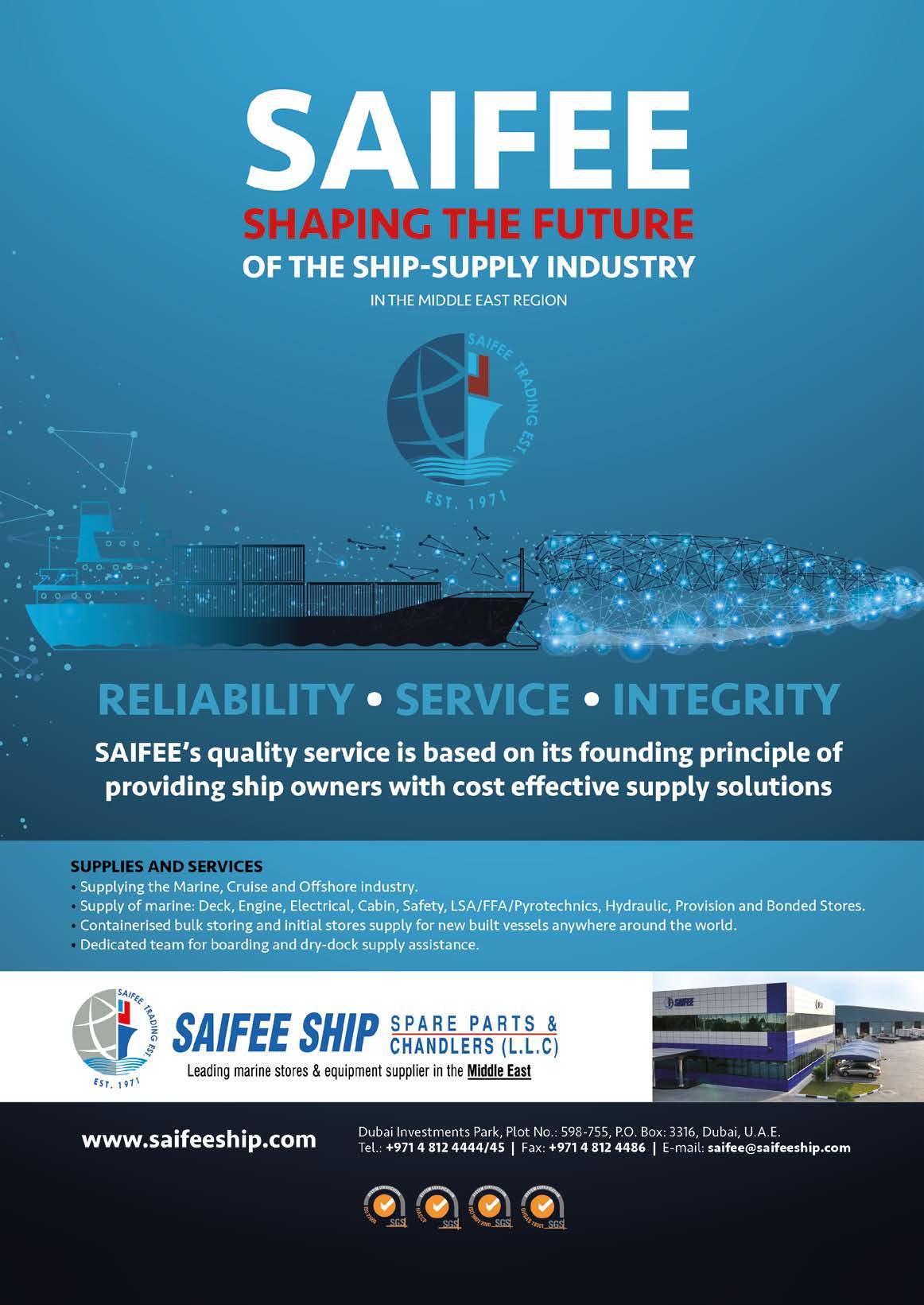

Greening of the Greek fleet


Get our magazine digitally. Scan QR code and fill in your details to receive.


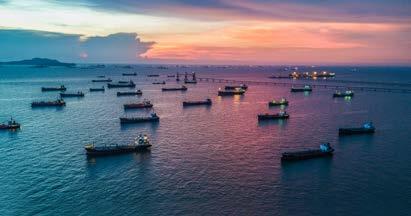

8 – Shipping and the art of risk management
NOTEBOOK
10 – Baltic Exchange adds investor indices
11 – INTERCARGO and RightShip launch independent Dry Bulk Centre of Excellence
12 – MMS advocates genderinclusive onboard health support

25 – Harry Vafias, Head of the Vafias Group
14 – Maritime Authority of Jamaica’s Rear Admiral (Ret’d) Peter Brady takes well-earned retirement
STRAIGHT TALK FIRST PERSON HOW I WORK
16 – BSM launches Smart Academy programme
19 – Swedish Club widens enhanced PEME programme
20 – ITIC: Storms ahead for ship management sector as FuelEU likely to repeat EU ETS mistakes
INTERMANAGER OUTLOOK
22 – Capt. Kuba Szymanski, It’s time to end this unjust criminalisation of seafarers


28 – Eline Muller, Co-owner Muller Maritime Group and a senior executive at Multraship Towage & Salvage
THE MAGAZINE FOR THE WORLD’S SHIP OWNERS & SHIP MANAGERS
ISSUE 108 MARCH/APRIL
5 Issue 108 March/April 2024 Ship Management International 55 Cover
2024
Story
DISPATCHES
31 – Maritime risk management services in growing demand

CREW WELFARE
34 – Seafarers ‘should have access to regular health checks at sea’
36 – Seachef Hospitality Services: 30 years of keeping seafarers happy and healthy
P&I and LAW
38 – Insurance implications of Baltimore bridge accident
MARITIME SAFETY
40 – Safety first: a collaborative approach
42 – Safety is not just a product, it’s an ongoing process
DECARBONISATION
44 – How onboard Carbon Capture & Storage can help drive shipping’s decarbonisation
46 – Energy transition requires ‘finding efficiency in all the right places’
EDUCATION
50 – BLUE BOARD LEADERSHIP PROGRAM: Boosting the prowess of maritime directors amid uncertain times
REGIONAL FOCUS
– Greece Report
– Cyprus Report
78 – Our regular diary section
86 – Lube oils: shipping’s secret weapon when it comes to decarbonisation
87 – Test results for future fuels
88 – Digital adoption requires a customer-centric approach
90 – Innovation & regulation: which is driving which?
92 – Smart leadership - NAVTOR’s quest for a holistic digital ecosystem 96 – Making waves in autonomy
80 – Products tanker trade complex and dynamic
ALTERNATIVE VIEWPOINT

82 – Michael Grey MBE, Seafarers collateral damage once again
98 – Our pick of the most coveted creations
83 – Building for a new era in cable laying
Next issue
100 – Bringing you the best in arts & culture
LIFESTYLE
102 – Motors: Audi e-tron GT quattro
The May/June issue of Ship Management International magazine (SMI 109) wiil focus on the fast-growing maritime centres and nations of the Middle East, namely Dubai & UAE and Saudi Arabia.
There will also be a country report on Singapore, resuming its progress in becoming a hub for innovation and the supply of alternative marine fuels, as well as a focus on the Shiprepair industry and Smart Technology & AI.
For advertising enquiries, please contact Sales by emailing sales@elaboratecomms.com You can also keep abreast of news and subscribe to our daily newsletter at shipmanagementinternational.com
6 Ship Management International Issue 108 March/April 2024
THE MAGAZINE FOR THE WORLD’S SHIP OWNERS & SHIP MANAGERS
REVIEW
OF DESIRE ANALYSIS TECHNICAL DIGITALISATION NAVIGATION INNOVATION LUBES
AD HOC
OBJECTS
55
68
SHIP MANAGEMENT INTERNATIONAL – ISSUE 108 MARCH/APRIL 2024

The shipping business magazine for today’s global ship owners and ship managers
March April 2024 | Issue 108
STRAIGHT TALK
Shipping and the art of risk management
Not so long ago it was often lamented within industry circles that shipping rarely attracted attention in the mainstream media and then only to berate its environmental performance in terms of either oil spills or harmful emissions.
That situation seems to have changed from the 2020 lockdowns onwards, with widespread recognition of the important role played by shipping and its seafarers. This was heightened by ensuing events that led to global supply chain disruptions such as the Ever Given’s blocking of the Suez Canal, UkraineRussia conflict, Panama Canal water shortages, and the Red Sea crisis.

Sales Enquiries
Julian Berry Phone: +44 (0) 1296 682 051
Email:jberry@elaboratecomms.com
Editorial
Bob Jaques Phone: +44 (0) 1296 682 089
Email: editorial@elaboratecomms.com
Email: bjaques@elaboratecomms.com
Finance
Lorraine Kimble Phone: +44 (0) 1296 682 051 Email: accounts@elaboratecomms.com
A latest ‘black swan’ event for the smooth conduct of seaborne trade attracting global media coverage has been the collapse of Baltimore’s Francis Scott Key Bridge following impact by containership Dali, leading to the tragic deaths of six maintenance personnel working on the bridge and temporary disruption of US East Coast trade.
Apart from the civil engineering issue of how a bridge can collapse so quickly and catastrophically, it remains worrying how a relatively modern (2015-built) containership can suffer what appears to have been a complete power outage at what proved to be such a critical time.
While the exact cause(s) of the accident remain under investigation, it is interesting to note a comment from the introduction to DNV’s 2022 publication ‘Managing the Risks of Blackout’ that the incidence of such failures – which it says can ‘often’ be attributed to the growing level of complexity and integration of onboard systems, for example for emissions reduction and improved vessel efficiency - “has become an increasing concern for the whole industry.”
In short, amid what seems an increasing frequency of global trade disruptions and the challenges of the green energy transition, safety remains of paramount importance in shipping and the sea a highly dangerous place. l
Publisher: Sean Moloney
Editor: Bob Jaques
Sales Manager: Julian Berry
Finance: Lorraine Kimble
Design and Layout: Diptesh Chohan
Regular Contributors: Michael Grey
Felicity Landon
Ian Cochran
Margie Collins
Ema Murphy
Motoring Journalist: Rob Auchterlonie
Technical Editor: David Tinsley
Editorial contributors: The best and most informed writers serving the

Connect with us /ShipManInter Visit our website www.shipmanagementinternational.com Download our App Ship Management International Join the debate @ShipManInter
Printed in the UK by Warners Midlands plc. Although every effort has been made to ensure that the information contained in this publication is correct, Elaborate Communications accepts no responsibility or liability for any inaccuracies that may occur or their consequences. The opinions expressed in this publication are not necessarily those of the publishers. All rights reserved. No part of this publication may be reproduced whole, or in part, stored in a retrieval system or transmitted in any form or by any means without prior permission from Elaborate Communications.
global
shipmanagement and shipowning industry.
Wingbury Courtyard Business Village, Upper Wingbury Farm, Wingrave, Bucks, HP22 4LW, United Kingdom
Published by

Notebook Baltic Exchange adds investor indices
Baltic Exchange’s new suite of investor indices offer shipping players and investors a clear view of data relevant to vessel investment
Successfully investing in shipping is all about timing. With cyclical freight rates moving between trough, recovery, peak and collapse, knowing when it’s the right time to invest in shipping or exit the market entirely is driven by a complex range of factors, from global trade demand, timecharter rates and forecasts, market sentiment, fleet renewal, regulatory requirements, and newbuilding and second-hand prices. Ships are also depreciating assets, with a working life of anywhere between 10 and 30 years. Deciding on whether to scrap a vessel early, extend their lives or sell is dependent on the owner’s view of future returns from the freight market against scrap prices, operating costs and asset values.
In a bid to boost the amount of available market data to shipping companies and investors, Baltic Exchange has recently enhanced its data product range with a suite of investor indices beyond its traditional shipping market indexes, such as the Baltic Dry Index (BDI), to give lenders, funds and other shipping industry backers a clear view of data relevant to vessel investment.
Baltic Exchange’s Investor Indices (BII) offer a snapshot of the financial prospects of dry bulk carriers and tankers, enabling shipping players, as well as investors and traders with exposure to oceangoing freight rates or asset values, a clearer picture about when to enter and exit the markets. This available dataset is crucial in an era of high volatility, particularly amidst instability in both the Red Sea and the Panama Canal that is causing major rerouting for hundreds of commercial vessels.
The BII is an easy-to-use dashboard displaying data relevant to vessel investment decisions, residual value, health of earnings, spot and five-year timecharter earnings; purchase and recycling values; and running costs. They offer a high level of clarity and transparency for shipping players and investors in the dry bulk sector, including for Capesize, Panamax, Supramax and Handysize vessel types, and the tanker market, specifically for Very Large Crude
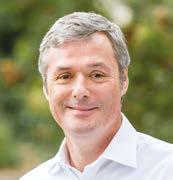
Carrier (VLCC), Aframax, Suezmax and Medium Range (MR) vessels. There are plans in place to include gas carrier assets to the service at a later date.
“The Baltic Exchange Investor Indices offer a simple data suite that allows people to make more informed decisions when investing in shipping,” said Mark Jackson, Chief Executive Officer of the Baltic Exchange.
“It is an easy access point to the range of data suites the Baltic Exchange offers,” he added.
OPEX assessments by the Baltic Exchange are a crucial dataset for managers. This index is broken down into crewing, insurance and technical costs, with the latter accounting for stores, repairs, expenses and management fees. While the indices also include dry docking costs, these numbers are amortised over five years and published separately so do not contribute to the assessment.
To ensure the index is as valid as possible, the Baltic Exchange partners with a number of leading thirdparty ship managers (Anglo-Eastern, BSM, Columbia Shipmanagement, Synergy, Fleet Management, and V.Group) that collectively provide technical management services to more than 2,600 vessels, including bulkers and tankers, as well as a broad range of other vessel types to add context to their assessments.
To compliment the datasets, Baltic Exchange also publishes quarterly papers that analyses the trends and impacts on asset values and freight rates as showcased by the BII from global maritime shipping capital structure consultancy Zuoz Industrial principal Urs Dür.
Understanding the fluctuating value of assets and the various aspects that can impact vessel profitability is vital for shipping players looking for a return on their investment. With volatility set to continue for the foreseeable future in key shipping regions, ship managers and institutional investors can now access more datasets from Baltic Exchange to improve decision making, brought by the world’s most trusted provider of maritime data and market information. l
10 Ship Management International Issue 108 March/April 2024
INTERCARGO and RightShip launch independent Dry Bulk Centre of Excellence
INTERCARGO, the International Association of Dry Cargo Shipowners, and RightShip, the leading global ESG focused digital maritime platform, have proudly launched the Dry Bulk Centre of Excellence (DBCE), an independent, not-for-profit industry organisation dedicated to the administration of the Dry Bulk Management Standard (DryBMS) framework.
DryBMS was developed by INTERCARGO and RightShip, with input from experts and stakeholders across the sector, as an industry tool to raise standards and best practices across safety, security, environmental performance, and social welfare in the dry shipping sector. INTERCARGO and RightShip have worked closely to establish the DBCE to further evolve and disseminate the DryBMS framework.
An independent, not-for-profit organisation entirely separate from its founding organisations, DBCE will be run by an independent management team and will adopt a governance model convened from ship owners, managers, and charterers. This will foster greater cooperation and collaboration between key stakeholders and achieve the common purpose of improving standards and driving operational excellence via active industry participation.
The DBCE Board of Directors will be chaired alternatively by representatives from the community of ship owners/ship managers and charterers and will have representation from RightShip, INTERCARGO and other industry stakeholders creating a truly collaborative industry initiative.
The DryBMS framework will continue to be accessible to the industry, and, from May 2024, DBCE will maintain a secure portal where ship owners and managers can complete digital self-assessment against the DryBMS framework. Ship owners and managers will then have the optional ability to share the results of their self-assessments with their charterer customers. In addition, DBCE will establish an independent self-assessment audit verification process for evaluating and verifying actual performance against self-assessments. DBCE will accredit independent auditors to its defined standard, whom companies may engage to perform audits of their self-assessments in their respective ship management offices.
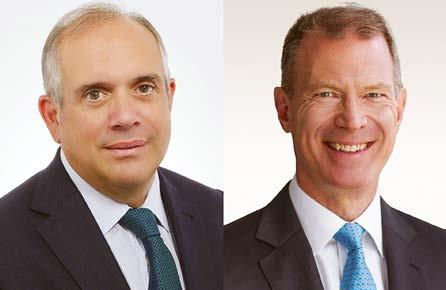
DBCE will be led by a newly appointed managing director, Ian McLeod, who commented: “I am delighted to be driving this new initiative. The launch of the DBCE is the next step for the industry in going beyond compliance and achieving excellence, with the support of the DryBMS framework. The welfare of crew, protection of the environment, and sustainable operation of assets form the bedrock of this initiative, all of which encourage companies towards better operational practices. This benefits not just ship owners, but all in the industry. We urge ship owners, managers, and other stakeholders across the sector, to use this tool and to join us on this transformative journey to make dry bulk shipping stronger, safer, and more sustainable.”
Steen Lund (pictured, right), RightShip’s CEO, stated: “It is exciting to be part of a such an important endeavour in lifting standards across dry bulk shipping. DBCE is more than just an administrator for the DryBMS standard; it is a catalyst for collaboration and proactive engagement across the sector. This launch can’t come at a more crucial time – ship owners and managers must be given the resources they need to achieve excellence and strive for zero harm.”
Dimitris Fafalios (left), Chairman of INTERCARGO, said: “We are collaborating in a scheme that is being developed by the industry and for the industry, which will administer a truly robust standard with the help and expertise of those that the industry relies upon to implement and support it. DBCE’s independence is crucial, ensuring the organisation always works for the benefit of the dry bulk industry as a whole.”
Visit the new DBCE website at www.dbce.org l
Notebook 11 Issue 108 March/April 2024 Ship Management International
MMS advocates gender-inclusive onboard health support


The growth of gender diversity in the maritime industry is important and must be welcomed but it has to be matched by the provision of the right form of medical support onboard ship for all seafarers, including women, according to Marine Medical Solutions (MMS), a leading provider of medical support for seafarers worldwide which takes an all-encompassing, holistic approach to their health and wellbeing.
Speaking on the occasion of this year’s International Women’s Day on March 8, MMS said the biological differences between men and women meant the medical support available at sea had to be carefully tailored to meet women’s health needs onboard ship.
Dr Jens Tülsner, CEO and founder of MMS, said: “It’s crucial that the maritime industry acknowledges and accommodates the unique health requirements of female crew members. From menstrual hygiene support to understanding the varying impacts of medication, such as painkillers and antibiotics, on different genders, every aspect must be considered to uphold the dignity and rights of women onboard.”
MMS stresses the importance of comprehensive training for ships’ Masters and crew members to ensure they are equipped to address women’s health concerns sensitively and effectively. Additionally, promoting awareness and fostering a supportive environment onboard are essential to empower women to seek holistic health and medical assistance without hesitation. Medical assistance for women may need a slightly different approach so awareness is key.
Dr Tülsner added: “We want women to feel comfortable and supported when seeking medical
assistance onboard. By raising awareness, enhancing understanding, and encouraging kindness, we can create a more inclusive and health-conscious maritime environment. “
In the lead-up to International Women’s Day, MMS Ship’s Doctor Dr Anastasiia Vlassova shared some of her onboard experiences and why throughout her career at sea she has always felt it important to raise women’s issues. A lot of vessels don’t have any female hygiene support or adequate choice of medication to alleviate periodic pain or bleeding.
“Men don’t understand and sometimes are scared of our physiological needs,” said Dr Vlassova. “So we need to find the way to add these things to the flags State requited medical lists and make informative explanation for male personnel that it is not illness or problem it is just female physiological need.”
As regards sometimes inappropriate comments from male fellow seafarers, she added: “We will not remove all idiots from vessels ever but we can help female seafarers to realise their right and borders.”
MMS used the occasion of International Women’s Day to reaffirm its commitment to providing telemedical support that is inclusive, understanding, and responsive to the diverse needs of seafarers worldwide. Its range of medical support services includes a 24/7 telemedical helpline, biomedical preventative maintenance, medical formulary management, coordination of medical treatment ashore and running onboard medical facilities. l
For more information visit https://marinemedical.solutions/
12 Ship Management International Issue 108 March/April 2024 Notebook
Dr Anastasiia Vlassova
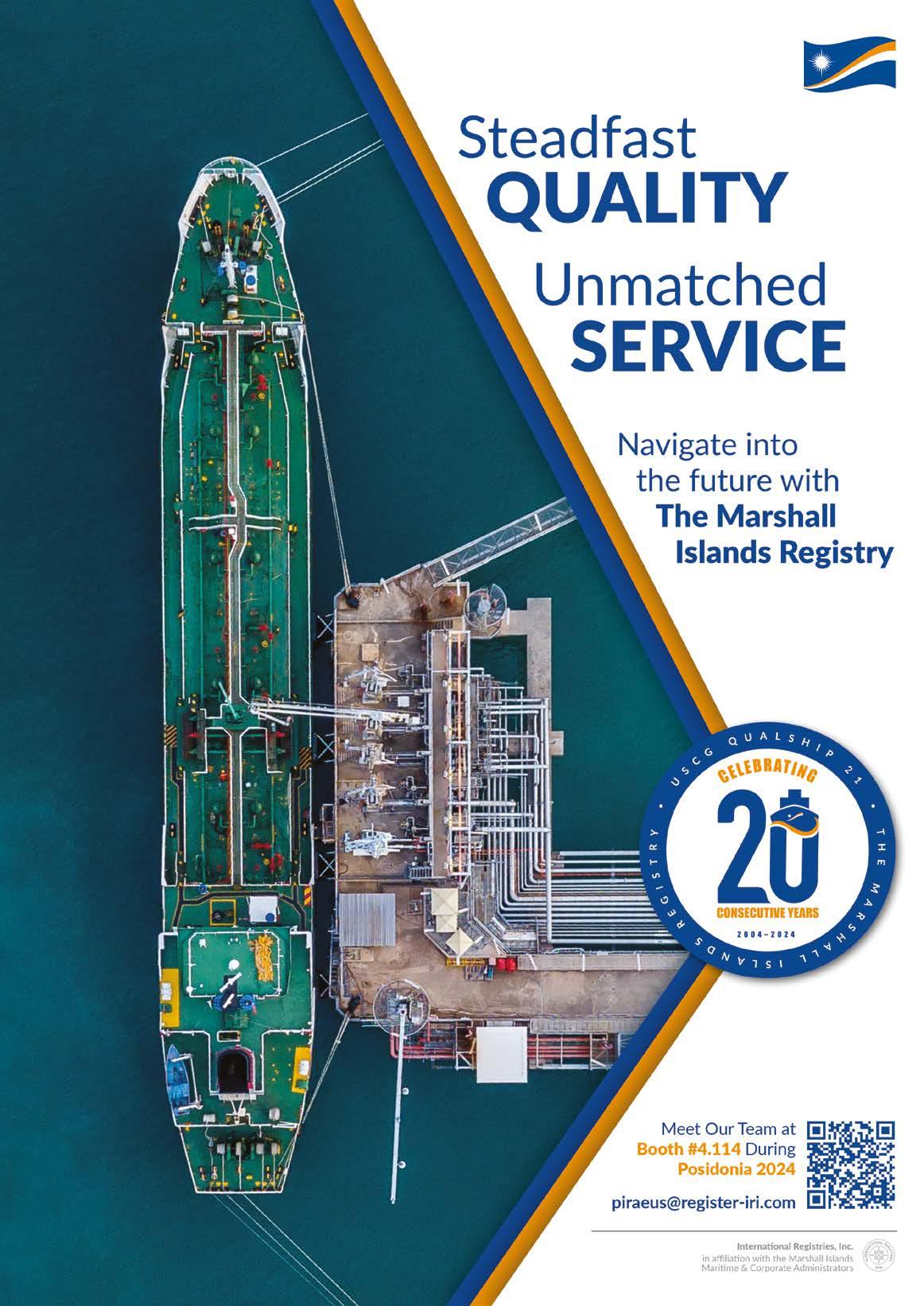
Maritime Authority of Jamaica’s Rear Admiral (Ret’d) Peter Brady takes well-earned retirement

Rear Admiral (Ret’d) Peter Brady has retired from the Maritime Authority of Jamaica (MAJ) having served as its Director General since its inception in 1999 with the coming into operation of the Shipping Act, 1998.
As Director General, Rear Admiral Brady was primarily responsible for elevating Jamaica’s maritime status regionally and globally. He spearheaded several major initiatives by the MAJ including the development of Jamaica as a Shipping Hub with attendant services such as bunkering and drydocking, as well as the implementation of the ISPS Code which came into force in 2004.
One of his best-known achievements was spearheading Jamaica’s re-election to the Council of the International Maritime Organization (IMO) in 2010. Rear Admiral Brady was subsequently appointed as a Special Envoy to the IMO which led to Jamaica’s re-election to Category C of the IMO Council for consecutive biennia ending with the successful re-election to the Council in December 2023.
His distinguished service as head of Jamaica’s delegation to the IMO resulted in his election in 2003, as Chairman of Committee 1 of the 23rd IMO Assembly and Chair of the IMO’s Standards of Training and Watchkeeping (STW) Sub-Committee – a position he held for 10 terms. In June 2010, Rear Admiral Brady presided over the Diplomatic Conference in Manila, Philippines where the most comprehensive amendments to the
and certification of
Rear Admiral Brady has a passion for maritime education and administration and was not only a visiting lecturer at the World Maritime University (WMU) in Sweden, and his alma mater, Dalhousie University in Canada, but he also served up to his retirement as Vice Chair of the Board of Governors of WMU and since February 2020 has been as a member of the CMU Council.
For his service to maritime education Admiral Brady was the 2015 recipient of the Seatrade IMO-themed Award for Maritime Education and Training. Receiving the award, Rear Admiral Brady said: “I feel greatly honoured and humbled to be recognised on this global stage and receive this award, particularly in the presence of some of the world’s maritime leaders. It was very important to me to be able to play a part in improving the training and standards of seafarers around the world and to make them consistent with the latest tech-nologies and I thank the Maritime Authority of Jamaica and the IMO in particular for giving me this opportunity.”
During his military career Admiral Brady was the recipient of the Commander of Distinction, CD (Jamaica); Commander of the Royal Victorian Order, CVO (UK and Commonwealth); Legion of Merit (Commander USA); and the Medal of Honour for Meritorious Service (Jamaica Military). l
14 Ship Management International Issue 108 March/April 2024 Notebook
STCW Convention, the global treaty which regulates the training
seafarers, were adopted.
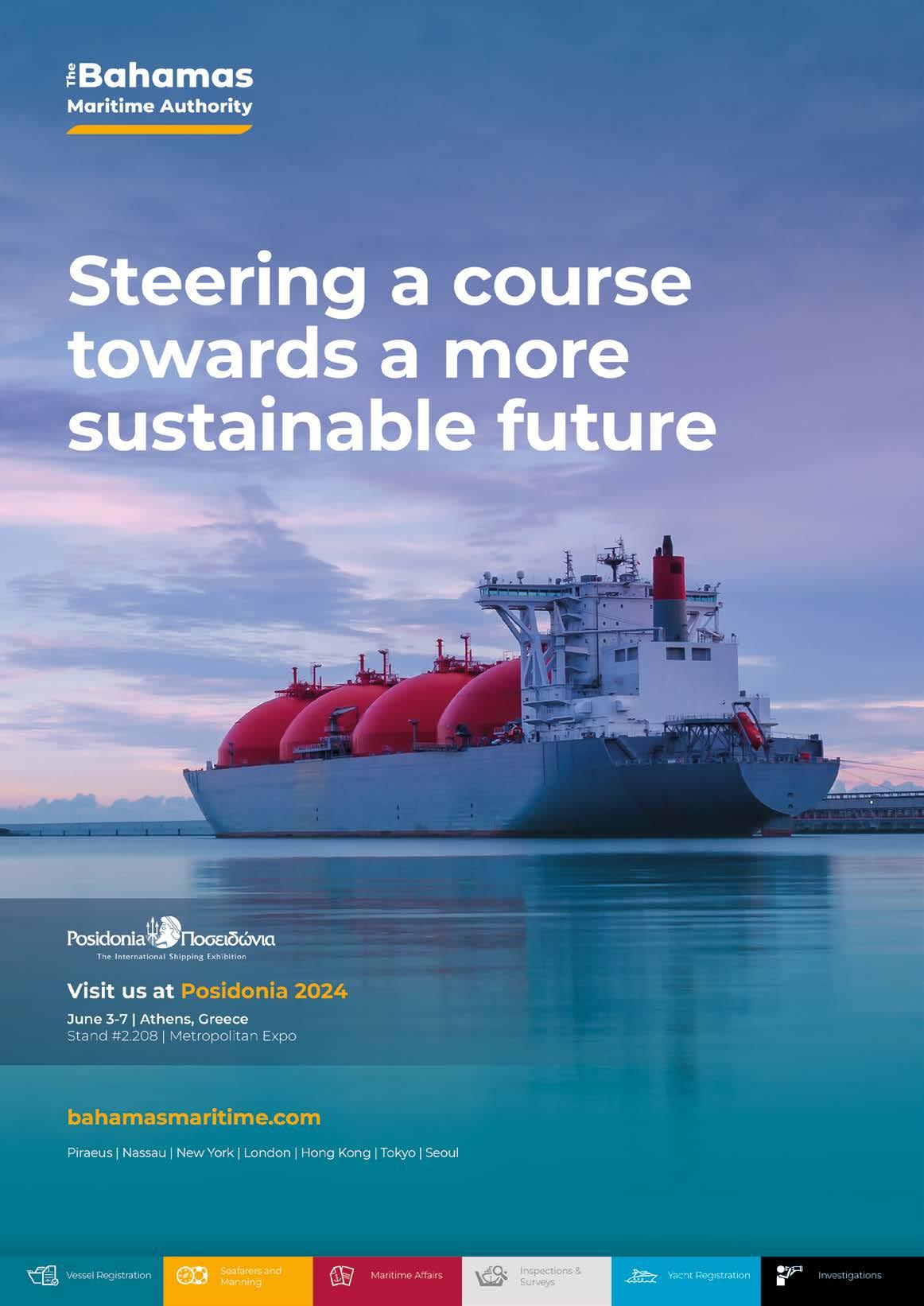
BSM launches Smart Academy programme
Bernhard Schulte Shipmanagement (BSM) introduces a new educational programme for future seafarers. BSM Smart Academy is a collaboration with selected maritime universities worldwide with the goal of closing the gap between academic knowledge and practical training.
The shortage of skilled labour in the maritime sector, in particular at sea, poses a significant challenge for the industry. In the coming years, the global merchant fleet will face a shortage of thousands of officers. As a ship manager, BSM takes a proactive approach to meet this challenge and gain highly skilled seafarers with the newly formed initiative Smart Academy.
Specifically, the BSM Smart Academy provides for nautical, technical and electrical undergraduates from participating maritime universities to take part in the programme as designated BSM cadets following the completion of their first year. This means that they not only receive an academic education but also practical knowledge close to current industry requirements. “We enhance the education of future seafarers by engaging with them at an earlier stage,” says Eva Rodriguez (pictured), Director HR Marine of BSM. Through the collaboration with the universities, cadets will undergo comprehensive training in a controlled and realistic work environment onshore and onboard. The training is aligned with BSM standards, ensuring a higher level of skill, and in particular, developing behavioural competencies before embarking onboard the multiculturally manned vessels.
In addition, students will be specifically trained for the increasingly digitalised maritime work environment to prepare for future leadership roles both at sea and on shore. This approach ensures that when they embark on their cadetship, they are fully prepared and ready to navigate the challenges ahead with confidence and competence.
“We have found that course contents and standards of educational institutions are often varying. This initiative closes the gap between educators and employers by sharing knowledge, experience and skill needs between the industry and the educational sector”, says the HR Marine Director.
BSM actively invests in crew education, training and development to help reduce the crewing shortage over time and maintain the industry’s safety standards and requirements. The BSM Smart Academy programme is another component in BSM’s intensive recruitment and retention commitment. It supplements the existing postgraduate Cadet Programme, the internal fleet transition programme and the proactive recruitment approach.
Eva Rodriguez emphasises, “Seafarer education is costly. However, no education is even more costly.”
At the start of the initiative, BSM will collaborate with selected maritime universities worldwide. The cooperation partners are located in Europe, the Middle East, Southeast Asia and Africa, with another potential partner based in South America. In the first year, up to 100 students are to be recruited for the Smart Academy programme. The aim is to gradually expand the global partner network to open up new seafarer source markets. l

16 Ship Management International Issue 108 March/April 2024 Notebook


Swedish Club widens enhanced PEME programme
Recognising that a healthy crew is a safe crew, and that the physical and mental wellbeing of seafarers is key, The Swedish Club is extending its enhanced PEME (Pre-employment Medical Examination) programme both within the Philippines and into a number of other seafaring nations including India, Ukraine and Indonesia.
An enhanced PEME greatly increases the chance of identifying potential health issues that could lead to a crew member falling ill while on board. The Club’s enhanced
PEME significantly exceeds the basic requirements for employment medical assessments reflecting not only the manner in which tests are carried out, but also how the results of those tests should be interpreted for a potential seafarer to be assessed fit for continued service on board a vessel entered with The Swedish Club.
Johan Kahlmeter, Director of Claims at The Swedish Club, says: “The quality of a PEME as well as the quality of the clinics and examining physicians is of vital importance, having a demonstrable impact on the liability to which an employer is exposed.
Many shipowners and ship managers have experienced the difficulties and risks involved in having a seafarer serving on board in a poor medical condition, physically or mentally, which should have rendered them unfit for sea service prior to employment.
“The safety implications of having unfit seafarers on board cannot be emphasised enough. Apart from the seafarer’s own wellbeing and safety which is key, it is easy to appreciate the risks imposed on colleagues, the operation of the vessel including commercial disruption, and the environment,” he added. l
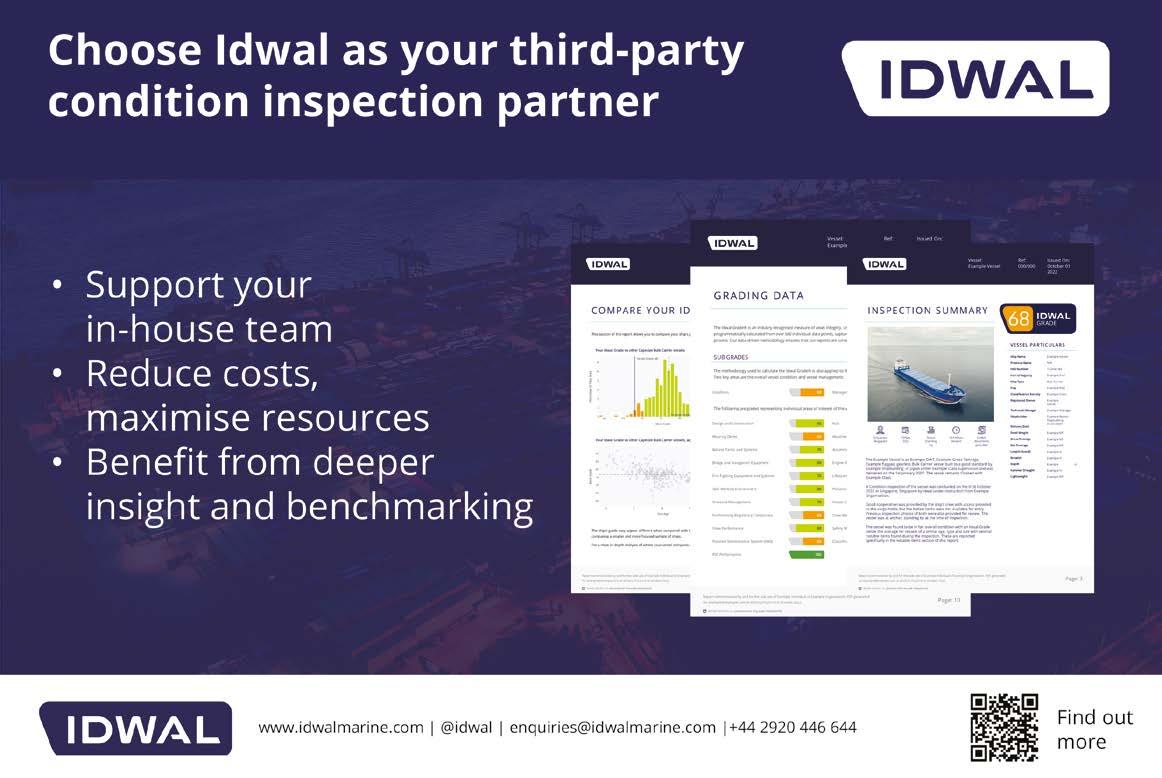
Notebook
Storms ahead for ship management sector as FuelEU likely to repeat EU ETS mistakes
By Mikaela Koni, Senior Claims Executive at ITIC
Whilst the European Union Emissions Trading System (EU ETS) has caused a stir in shipping, FuelEU has seemingly gone unnoticed. Nevertheless, FuelEU will be coming into force on 1st January 2025 and intense storms are forecast in the ship management sector.
FuelEU aims to build up demand and steady use of renewable and low carbon-fuels in vessels. As such, it sets maximum limits on a vessel’s yearly fuel emissions, increasing over time. Emissions must decrease to at least 75% by 2050. FuelEU targets carbon dioxide, methane and nitrous oxide emissions. There is also a zero-emission requirement at berth, creating the need for an onshore power supply. All cargo and passenger vessels above 5,000 gross tonnes must comply, regardless of flag.
The issue that arises with FuelEU is the same as that with EU ETS. The entity responsible for complying with FuelEU is the entity responsible for the vessel’s operation and the duties and obligations imposed by the ISM code. Therefore, in the same manner as the EU ETS, FuelEU could render a ship manager responsible for the vessel’s compliance with the regulation when the ship manager has no power over the commercial operation of the vessel.
A further issue is the scheme allows for a voluntary pooling mechanism, whereby vessels can pool their compliance balance with one or more other vessels, and thus, the pool as a whole will have to meet the emission limits. This causes a problem as it is theoretically possible to ‘pool’ the vessels for which the manager is responsible. Such ‘pooling’ may be perceived as unfair towards some clients and beneficial towards others, creating friction points. Unlike the EU ETS, the FuelEU is a per-vessel requirement, and any detention of the vessel will be applied to the specific vessel. Nevertheless, if penalties are imposed for any breach, these could burden the ship manager.
The FuelEU penalties are proportional to the breach. That is, the penalty is based on the amount and cost of renewable and lowcarbon fuels that the vessel should have used. Additionally, a penalty could also be imposed for each non-compliant port call. This could mean that multiple penalties could be imposed for one voyage.
The regulation states that the penalties remove any economic advantage of non-compliance. However, realistically, this is not the case. Ship managers, as per the ISM code, have the responsibility for checking and ensuring the sulphur

compliance of fuel delivered to the vessel and after that burned, but despite that, the fuel procurement decisions do not lie with the ship managers. Given this, nothing stops the procurement of non-compliant fuel, which will naturally be more economical, as more in-demand green fuels will be more expensive, letting the ship manager face the penalty. If such a scenario is possible, removing any economic advantage as envisaged by the regulation is simply impossible.
While the same issues were raised with EU ETS, the EU seems unable to adopt a lessons-learned approach and places the ship managers in an unfavourable position with a “polluter pays” approach that is easy to bypass.
Managers should act diligently to mitigate risks by ensuring that any ship management agreement considers the liabilities arising from FuelEU. BIMCO has established a dedicated subcommittee to examine the implications of FuelEU, so hopefully, new clauses will be available for their contracts, including SHIPMAN.
Despite the above, a positive thought for the future is that by the time FuelEU is implemented, ship managers will likely have mastered the perils of EU ETS, and their approach to the new scheme will surely be more confident. l
20 Ship Management International Issue 108 March/April 2024 Notebook
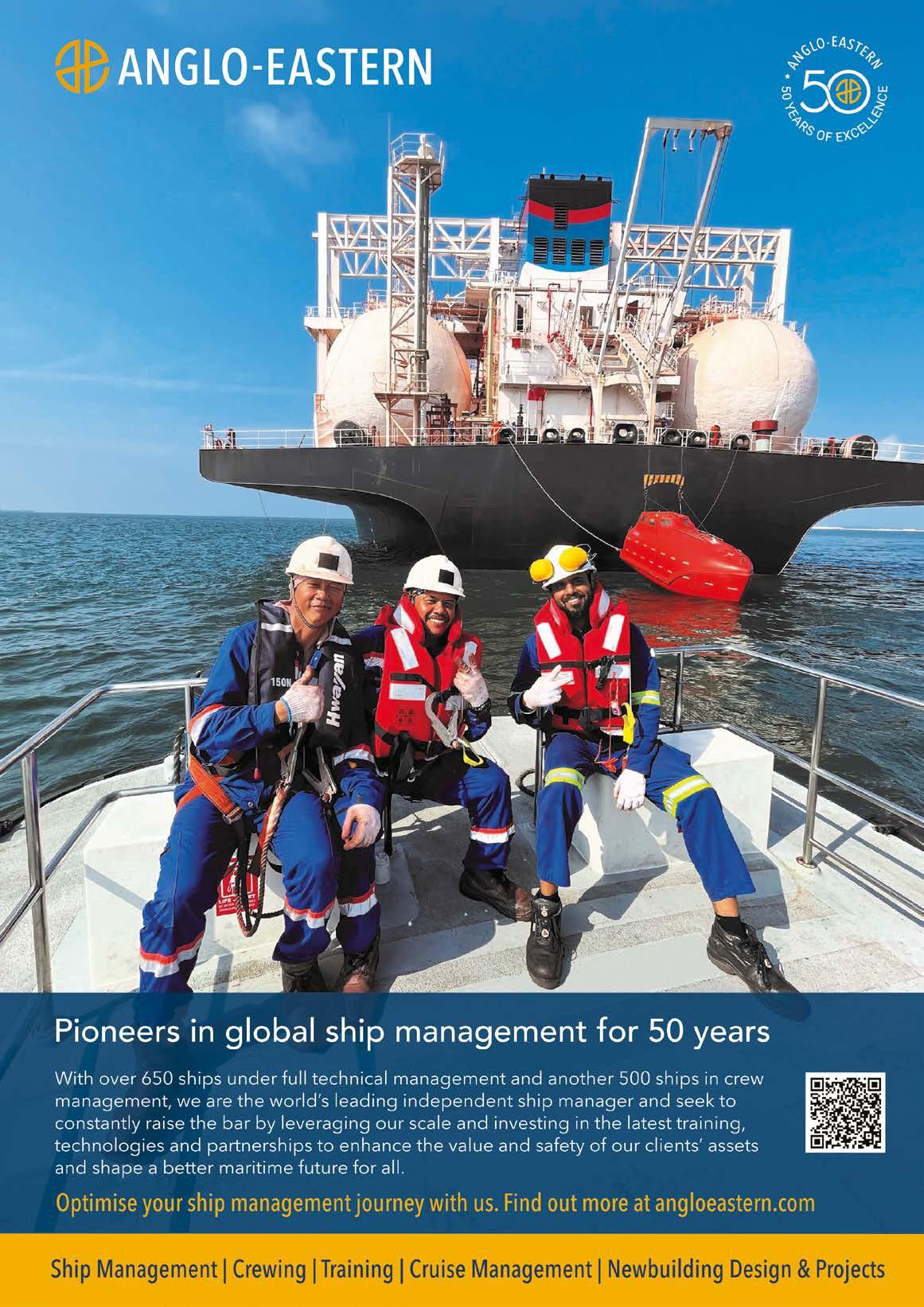
InterManager Outlook
It’s time to end this unjust criminalisation of seafarers
InterManager Secretary General, Capt. Kuba Szymanski, takes a hard-hitting look at the issue of the criminalisation of seafarers.


Ifeel extremely anxious about the increasing criminalisation of our seafarers in areas around the world, particularly in relation to alleged drug smuggling. I believe it is time we as an industry did more to bring this practice to an end.
I know I am not alone in being concerned but I do feel our industry needs to wake up to what is going on and speak out with one strong voice. InterManager has joined industry stakeholders to discuss our concerns with regulators and law enforcement agencies and we need to build on these first steps.
I hear regularly, almost daily, from seafarers who are worried about going to areas of the world where drug smuggling is prevalent, fearing they will be unfairly criminalised if illegal narcotics are found onboard their ship. And I frequently hear worrying testimony from the families of seafarers who have been unfairly thrown in jail in a foreign country and held without trail for months with no evidence that they have committed a crime. I hear harrowing reports of torture, ill-treatment and starvation, resulting in extreme weight loss, physical and mental health problems.
I strongly believe that we must do more to end this situation – for our seafarers, for their families, and for our industry.
On the one hand we are trying to introduce new procedures, protocols and industry best practices which are designed to improve seafarers wellbeing, but on the other hand, we are walking a terrible walk of shame by completely
ignoring the fact that, as a result of our (ship managers’ and owners’) decisions to send ships to high-risk areas of the world, like Central and South America, our own people are being thrown into jails. Crew report drug findings on their ships, often discovered during unloading in port, because they believe it is the right thing to do. But look what then happens: Capt. Andrzej Lasota held for 20 months in a Mexican jail before being released without charge; the crew of the Phoenician M held for seven months in Eregli (Edemir) and Berge Torre at Adana Yumurtalik.
Frequently we do not provide legal support for them as our P&I insurance limits our responsibility. Perhaps it is convenient for us to blame the crew and see them removed in order to have the ship released? What happens to the crew then? They are often left to their own devices and terrible pressure falls on their families to campaign for their release. As an industry we don’t keep any statistics and we do not provide insurance against this for senior officers and ratings.
There is however a light at the end of the tunnel – there are now examples of law enforcement agencies, such as the UK Border Force, not jumping to incriminate innocent seafarers. The US Coast Guard is also working with the shipping industry and partner organisations to establish better procedures in these circumstances.
I believe it is time for change, time to do something to end this situation, and time to demonstrate to our seafarers how much we truly value them. l
22 Ship Management International Issue 108 March/April 2024


First Person
Sean Moloney talks to Harry Vafias, Head of the Vafias Group (Brave Maritime/ StealthGas Inc/ Stealth Maritime/ C3is/ Imperial Petroleum)
Greece’s Brave Maritime Corp, headed up the highly respected shipowner Harry Vafias, recently announced that it had taken delivery of four new state-of-theart 40,000 cu m ammonia carriers from South Korea’s Hyundai shipyard. And while the vessels represent the new generation of gas carriers with super-efficient engines, comprising all the latest environmental features, the most amazing aspect of the deal was that while they were ordered for $46 million apiece, as soon as they were delivered their value had risen to, in excess of, $70m each.
In addition, the group has on order three more new generation gas carriers, one more 40k cu m sistership in HMD for Q1 2024 and two 11k cu m vessels under construction in Japan, one for delivery in 2025 and one in 2026.
Over the last 18 months Brave Maritime has acquired an astonishing 32 ships comprising of seven LPG newbuildings, 10 tankers (four Suezmax, one Aframax and five Product Tankers) as well as 17 bulkers (eight Capes, four Supramax, two Kamsarmaxes and three Handies). According to a company statement, unreported were the two Kamsarmaxes, the Eco Czar and Eco Sikousis, both built in Oshima Japan in 2009 and 2008 respectively. According to brokers’ reports these were bought for in the region of $31m enbloc. After the recent acquisitions and vessel deliveries, the group’s fleet comprises 91 vessels – 35 gas carriers, 30 bulkers and 26 tankers both crude and clean.
A sizeable fleet expansion indeed, but what is the strategy behind the fleet growth?
“Speaking with my group hat on, the last two years have probably been the most active for the group since it was founded. We mainly did three things: one was acquiring 34 vessels of all types, and this by any measure was a significant achievement, meaning crude tankers
clean tankers gas and dry, of various sizes; number two was repaying down all the debt so of the five companies we have – two private and three US listed – four are now debt free, and only one, a listed company, has 15% debt which is negligible. The third important thing, and now with my StealthGas hat on, was selling smaller gas ships and reinvesting in larger new buildings, which is why we have been starting to take delivery of this new generation of 40K cu m vessels,” Harry Vafias said.
And already making a profit on them according to vessel values? “We knew we were ordering at a good time, we never expected to order the ships at $47 million and two years later the ships would be worth about $70 million each. So, it was unexpected.”
But what is driving the strengthening of the markets and what is fueling the very positive market sentiment that is being seen at the moment?
“All these geopolitical problems, most of the time, are positive for shipping. This is the first time in many decades that you have three major problems all happening at the same time – the Ukraine war; the Gaza war which has a danger of spreading in the region, and the simultaneous semi-closure of the Suez Canal and the Panama Canal. This has never happened before and because of this there are risks, but the risks push the freight rates up, and especially for energy cargoes,” he said.
But while shipping will make money out of such situations, there is still uncertainty, surely?
“Yes, but if the ships have to go around the Cape of Good Hope and not go through the
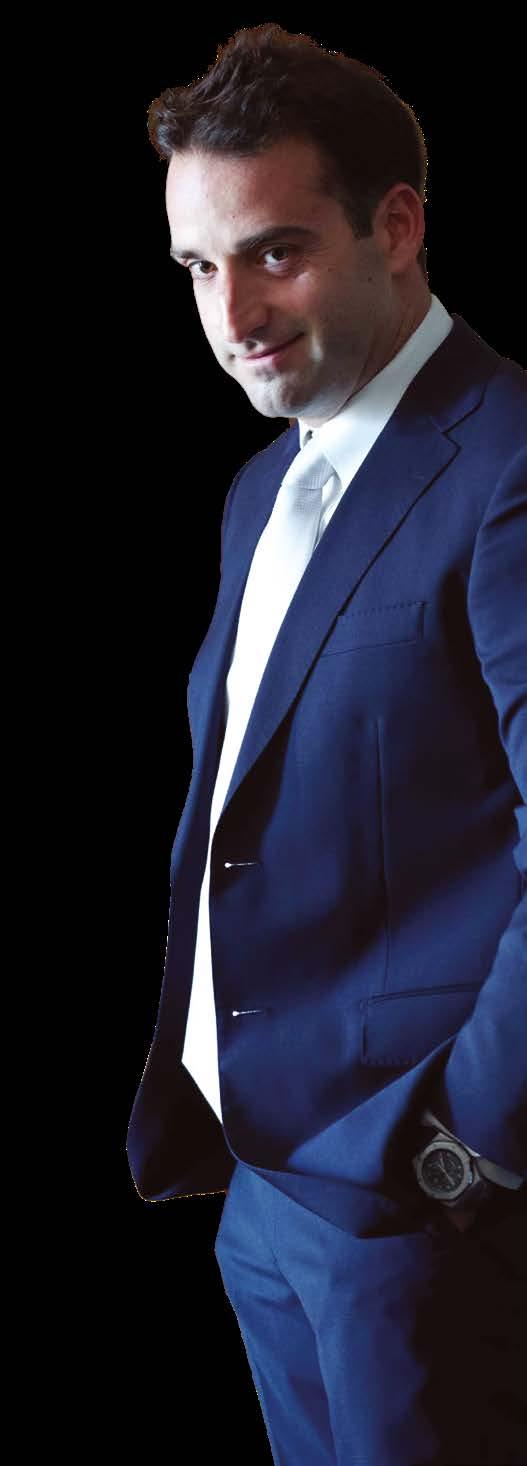
25 Issue 108 March/April 2024 Ship Management International
Panama Canal and then go around South America, that adds so many days onto the voyage and if charterers don’t pay for these additional days, we will not do the voyages,” he said.
“So, you either have to go through the Suez Canal with extra security and everything that that involves, or you go around the Cape and you get paid because you’re not going to do it for free. We never want war and we never want people dying, but especially for energy shipping, oil and gas, these kind of problems have always been positive for the markets,” he stressed.
When the rates are strong, do shipowners still concern themselves with OpEx? The industry is starting to look very seriously at digitalisation to drive value to the bottom line in terms of greater efficiencies and lower costs?
“I’m not the biggest innovator and I like things that I understand, things that I know well, I’m not an expert on technology, I’m not a first mover in technology; we try and do things like that but we are not going to be the first movers, innovators or pioneers,” he confessed.
“Unfortunately, when it comes to shipowners and when the times are good, like now, they don’t focus so much on the OpEx. $1,000 up or $1,000 down doesn’t matter. And this is wrong because in a good market as well as in a bad market you should always try and save money. But when the bad times come, there is more pressure from your shareholders and your family to try and maintain breakeven if you can. So, there is more focus on these things.
“We have the problem of inflation which pushes costs up, in certain cases by a lot, but we have the benefit of operating a large fleet spread across different companies to the extent that we have a lot of synergies in tackling economies of scale so we probably have lower costs than the other shipowners. But unfortunately, when they make money they don’t focus on the last cent and they should. We have 91 ships including the newbuilds deploying a lot of economies of scale. We manage all but two of these ships in-house. We feel we have more control, it’s our own ships, you care more, you use them as a negotiating base. It is better to do it on your own,” he said.
With all this positively around, there must be negative factors that keep shipowners awake at night? For Harry, it is confusion over how the industry can tackle decarbonisation where there is no clarity on the type of fuel that can be used.
“When it comes to decarbonisation there are no forward plans in the industry. You cannot say to shipowners that by a certain date you must have reduced your emissions by a certain percentage when there is no viable fuel alternative that can achieve that. And why are they saying this to us, we don’t build the ships, we don’t design the ships, we don’t build the engines, these are done by other people so why don’t they go to the shipyards or to the engine builders and say look, by a certain date make the engines that will burn a certain fuel.

“This is very unfair, I think, and it worries me because there’s no clear path and you can’t make a decision on this based on untested technology. So, what happens if I decide I want to invest in ammonia as a fuel, and spend all that money and then five years later the industry decides it wants to go into methanol, what am I going do with my ammonia ships? No one is going to pay me for taking the risk.
“So, it is better in this very very risky time, not to be a first mover but wait for the technology to be tested and agreed on and then follow the way the industry is moving. The legislators and the IMO have to go to whoever has the technology, whether it’s the yards or the engine makers, and push them by a certain date to have an agreed fuel and technology that is ready and tried and tested,” he added.
But as Harry questioned, what does an ammonia-ready ship mean? “If the legislators want a greener ship, then go to the yards or the engine builders, but until that point, as an industry, you don’t run your ships at 13 knots you run ships at 8 or 9 knots and save emissions without doing anything, but why don’t they do it?”
Finally, Harry, tell me about Greece’s version of Dragon’s Den. You are into your second series now as a Dragon, how are you finding it?
“When they invited me to join, I was negative because while I had no problem with appearing on TV, I felt that all of these ideas that are being proposed on Dragon’s Den were not related to what I did. So, I didn’t want to find something in a position where I was demonstrating a lack of real expertise in something I had been asked to do or had been offered to invest in.
“But the producer was a really smart guy and he said first of all it is charity, because you are giving money to small start-up companies, and he emphasised that if the Dragons weren’t in a position to buy into the companies then there was little chance of them succeeding. He made me feel a bit bad let’s say. So, I said I would do it and it has turned out to be much better than I expected, which is why we are now on series number two.
“It is funny because as you know I’ve been in shipping myself since 2000 and I’ve had a public company since 2005 but people who meet me, 90% of the cases, talk about Dragon’s Den and not the rest of what I am doing. That shows you the power of TV.” l
26 Ship Management International Issue 108 March/April 2024 First Person

How I Work
SMI
talks to industry leaders and
asks What motivates them and how they deal with the rigours of the shipping industry

EEline Muller
Co-owner Muller Maritime Group and a senior executive at Multraship Towage & Salvage
line Muller is a senior executive at Netherlandsbased Multraship Towage and Salvage, part of the Muller Maritime Group, and from her shipowner’s perspective has strong views on female representation in the maritime industry.
She is also an active member of the International Salvage Union (ISU), chairing its Salvage sub-committee,
and engages with other shipping industry bodies, such as the European Tug Owners’ Association (ETA) and the Royal Dutch Shipowners Association.
Most recently, Muller was appointed as a board member of the Shipowners’ Club, of which Multraship has been a longstanding member.
With more than 35 years of experience in the towage and salvage industry, she says: “I feel grateful for
having acquired skills and expertise that I can now use. As a board member of the Shipowners’ Club, I aim to provide advice and governance from a tug owners and salvage industry perspective.
“The Club’s goals align closely with those of Multraship, which prioritise stakeholder peace of mind, operational efficiency, and trustworthiness for members,” she adds. “At Multraship, we offer peace of mind to our clients, stakeholders, staff, and third-party suppliers by delivering expert services that ensure operational efficiency and build trust.”
Reflecting on last month’s International Women’s Day, Muller has observed a shift in attitudes towards diversity and equality in the industry. However, she stresses that there is still a long way to go.
“Despite progress towards gender equality and greater emphasis on promoting and delivering on diversity and inclusion goals, gender balance in the maritime industry is still very much a work in progress,” Muller comments.
“Not only do we need more female inclusion across all levels of industry, but we need women to be more visible. This will no doubt inspire younger generations and women working in other industries to consider careers in the maritime sector. Men still dominate panels and speaker roles at conferences; as a basic example, women are still underrepresented. This needs to change.”
28 Ship Management International Issue 108 March/April 2024
GENDER EQUALITY AND INCLUSIVITY
“Being a family-run business, it has always been apparent to us that inclusivity is imperative, Muller continues. “As an organisation, we firmly believe in providing equal opportunities and salaries, irrespective of one’s gender. It is ingrained in our company’s culture to ensure that everyone is treated fairly and justly.
“Traditionally, the towage and salvage industry has been primarily male-dominated. Still, at Multraship, we have a well-balanced management team and many talented and inspiring women in our organisation as crew or officers and in office-based positions,” she says.
Muller thinks a gradual change is happening in the industry as a whole, but she would like to see more women in operational, commercial, and technical roles. Representing women in leadership roles and seafaring positions remains a particular challenge.
The right blend of skills and encouraging different perspectives have proven crucial to improving efficiency and operational performance.
Fostering enthusiasm in maritime across the board is critical, Muller believes. Encouraging new and diverse talent to enter, or stay in, the industry will lead to more dynamism, which will, in turn, improve capabilities and help address the key challenges that lie ahead, including the road to achieving net zero in 2050.
SUSTAINABILITY IMPERATIVE
She says it is essential to attract young people who are passionate about sustainability to the industry.
“We must get them involved in greening the shipping industry. They need to realise they can make a difference in addressing climate change and promoting sustainability as part of the maritime industry.
She adds that collaboration between the maritime community, governments and other sectors is crucial. Towage and salvage industry organisations such as the ETA and ISU are actively engaging with stakeholders to find the best business solutions for the industry.
The ETA, for example, is collaborating with 12 other European associations to achieve sustainable and digital goals. Recently, a Joint Declaration titled ‘Charting a Course Towards a Resilient, Competitive, and Sustainable Future’ was released.
Muller is grateful for the increased demand for Multraship’s services, which has grown healthily in the past
couple of years. With its geographically expanded area, Multraship has invested in additional vessels and grown its team at sea and onshore.
Maintaining a high-quality and diverse fleet is equally important, given the increased demand for the company’s services due to project requirements and the continued need for emergency response services such as Multraship’s response to the fire-stricken car carrier Fremantle Highway off the Dutch Coast last year. Therefore, it is critical to build the right fleet and personnel’s operational and skills capabilities.
“Sharing our expertise and insights is crucial, not just on tug and salvage issues, but also on the bigger-picture issues affecting our sector,” says Muller.
“We must invest in people, skills, and technologies to get there. Ultimately, this will enable us to achieve our goals and have a sustainable future,” she concludes. l
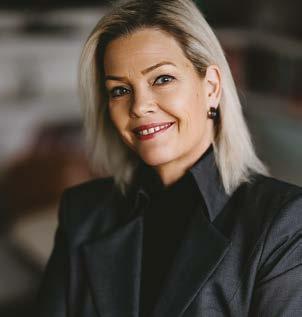
We must get them involved in greening the shipping industry. They need to realise they can make a difference in addressing climate change and promoting sustainability as part of the maritime industry
Eline Muller
29 Issue 108 March/April 2024 Ship Management International How I Work

Dispatches Maritime risk management services in growing demand
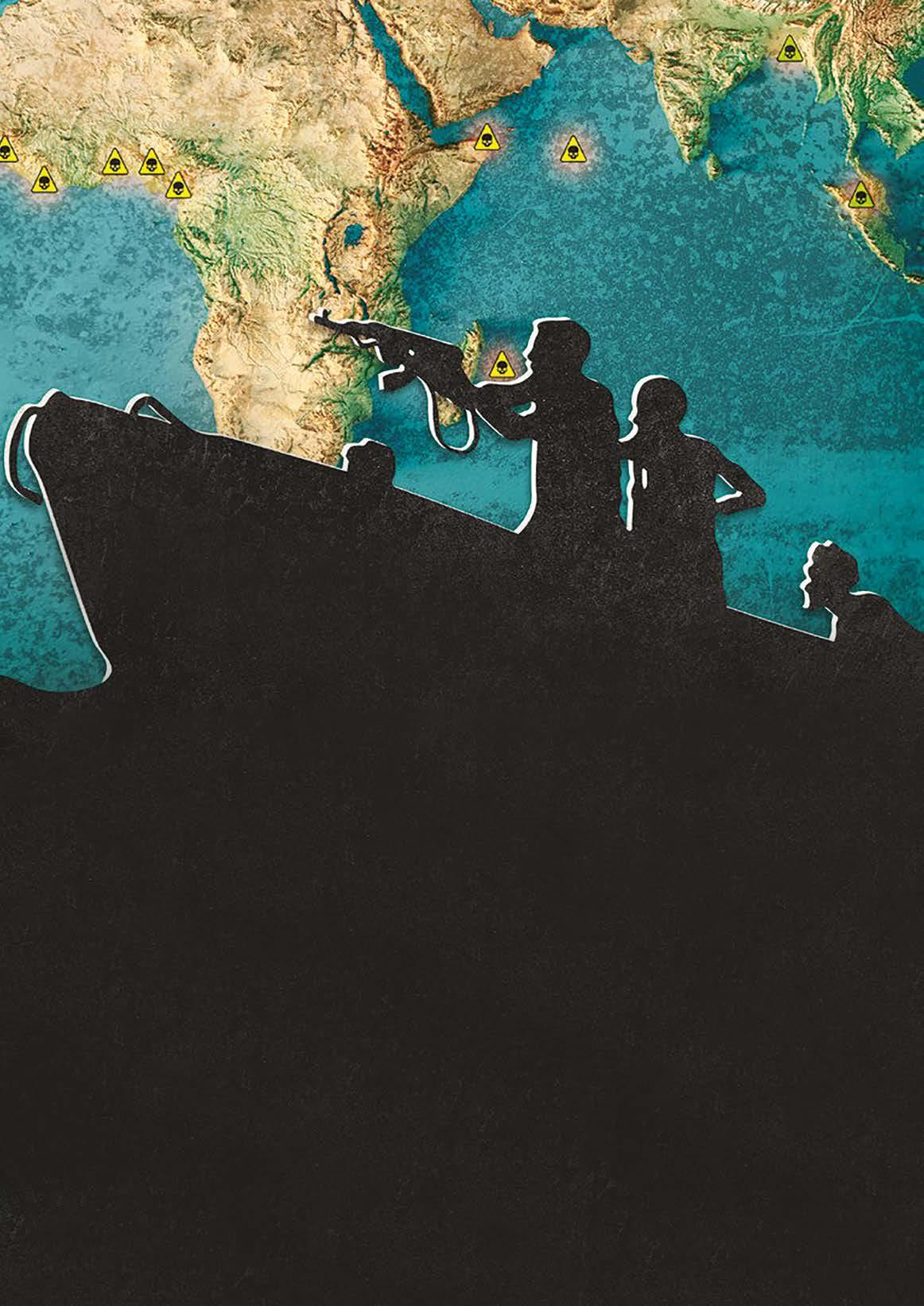
Felicity Landon conducts an exclusive interview for SMI with Ambrey MD of Risk and Intelligence, Joshua Hutchinson.
From the Houthi attacks on shipping in the Red Sea to the resurgence of piracy in the Indian Ocean, there is no shortage of events for global maritime risk management specialist Ambrey Limited to warn its clients about. But as Joshua Hutchinson, Ambrey’s MD of Risk and Intelligence, emphasises, the aim is not to hinder shipping operations – rather, to enable and support them.
“Our job is to increase the understanding of global threats, make sure we articulate those threats daily, and take clients on a journey of mitigation,” he says. “Our job is about business continuity and growth. It is not about stopping things happening but allowing them to happen – it is to help ship owners and managers to keep operating and growing.”
Ambrey offers what it calls a 360-degree approach to maritime security, safeguarding its clients’ people, vessels and reputation. It works with the world’s largest ship managers, and with operators, charterers, insurers and other interests.
Founded in 2014, initially focusing on the increasing piracy threats in the Indian Ocean, Ambrey today has 2,500 staff in eight countries supporting its global maritime operations. It is currently building what it believes will be the largest maritime operations
centre in the world, investing in a ‘mariner-led’ risk management service; this new centre will be in Southampton. Looking ahead after a decade of rapid growth, Hutchinson says: “We aim in the next coupe of years to be supporting every vessel everywhere in every port and on every ocean, to both understand the risks and mitigate them.”
Today’s headline risks make up an alarming list. Attacks on vessels in the Red Sea and Black Sea; civil unrest and drug cartels in South America; piracy groups persisting off West Africa; the huge movement of migrants heading north in Western Sahara, and the migrant crisis from Libya into southern Europe affecting every SAR in the region.
“In the Black Sea, ship owners and managers are having to navigate active USVs, drones and mines,” says Hutchinson. “The Red Sea attacks by the Houthis represent the biggest crisis in the past decade. There is the increased and widening impact of the Israel/ Gaza war and the need to support the humanitarian corridor, especially as the Houthis are now targeting container vessels across the Indian Ocean. In the resurgence of Somalian piracy we are seeing groups of pirates operating deep into the shipping lanes, 400 miles offshore where vessels might previously have felt
IMAGE CREDIT: Cover of International Chamber of Shipping’s ‘Piracy, Armed Robbery and Conflict at Sea’ 2024-25 Edition
The ever-increasing, dynamic Elevated Threat Areas across the Indian Ocean and Arabian Sea shown (in red) on Ambrey’s Fathom platform

relaxed. Head into South East Asia and we have a yearon-year increase in vessels being targeted with robbery and theft into the Singapore Straits. And head up into the South China Sea and you have concerns about the possible invasion by China of Taiwan.
“This is the complexity of the environment that ship managers and operators now need to live in and operate in, and seafarers have to emotionally work with every day.”
Increased number of threats
Is this a particularly threatening time, or is there just greater awareness and real-time information? Hutchinson says that the number of threat events taking place has dramatically increased, and this also coincides with there being more state elections this year than ever before.
“Post pandemic, we are seeing countries under financial duress, countries becoming insecure and unstable because of crime, and naturally where there is instability, crime and poverty, the increase of threats comes about.”
He agrees that the real-time information has become much more accessible but adds: “Managers have had to be more dynamic of how they are aware of what’s going on and how it might affect them. Managers, owners, security officers and others have had to evolve their roles, going from awareness to understanding very quickly. There is a difference between understanding a threat and really mitigating it with risk management, and that is where we provide the assessment for them to work with.”
Not all risks are equal. It is still reasonably safe for some shipping companies to operate in the Red Sea, as long as
they understand the threat profiles and understand how to mitigate the risks. There is civil war in Sudan but still a lot of cargo is moving through Sudan’s ports. The Houthis are firing missiles from Yemen, but there are still port operations in Yemen – people still need food and other cargoes. “More than 90% of trade moves on the water -more than 90% therefore has to enter into a port,” says Hutchinson. “When the port is really shut, that is when a country really falls into turmoil.”
Ambrey’s services include the Sentinel global alert service which alerts vessels in real time with information relevant to their proximity, route and destination. “To save lives, time and money, we need to provide that information as quickly as possible to the people that need it,” says Hutchinson. “Masters on board need to know what’s happening – is there an attack, is the port safe, are there mines in the sea? There is a real sense of community in the maritime industry and the more we bring vessels together, the stronger our awareness of safe operations.”
The Guardian digital service supports up to 4,000 vessels daily around the world, helping ship manager and operators understand the threats and risks prior to entering into an elevated threat area. “It is about providing that real-time information so that when something happens, we are actively able to divert ships,” says Hutchinson.
Ambrey focuses on operating “mariner-led services” – chief officers, master mariners and others delivering a global service to their colleagues on board.
32 Ship Management International Issue 108 March/April 2024 Dispatches

There is a difference between understanding a threat and really mitigating it with risk management, and that is where we provide the assessment for ship managers and operators to work with
BLACK SWAN EVENTS
Can shipping ever be prepared for Black Swan events – and, indeed, how does he define these? “It’s something we can’t imagine happening,” he says. “On risk, what are your known unknowns? Plan for everything, even the unexpected.
Looking at the recent catastrophe of the Francis Scott Key Bridge collapse in Baltimore, he says: “Ships navigate through bridges all the time, so vessels hitting bridges have to be a ‘known unknown’. However, was it ever in our imagination that by being hit, the whole bridge would collapse? Often, with a Black Swan event, we look back and ask –why didn’t we see that coming? If you are aware of a potential threat, it is not going to be a Black Swan.”
In February, Ambrey and Inchcape Shipping Services announced a strategic partnership for providing maritime security services through combining technology, global presence and expertise. “We will announce more partnerships this year, which will focus on bringing a global operation to provide a more safe and secure maritime operation,” says Hutchinson. “The maritime industry is facing severe global threats. Our passion is for a safe and secure industry.” l
Dispatches
Crew Welfare
Seafarers ‘should have access to regular health checks at sea’
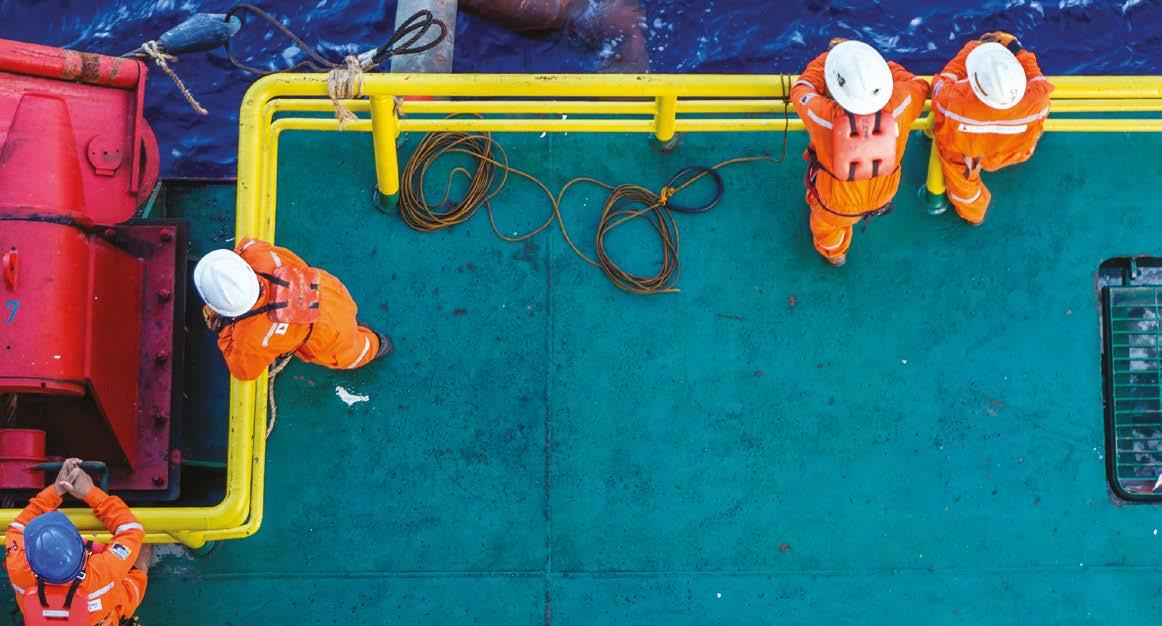
Leading crew change specialist BCS Group –Boers Crew Services says the industry should be collaborating more to ensure the health of seafarers is treated as a priority, with initiatives in place such as access to blood tests while they are out at sea.
Dutch company Boers Crew Services launched its new Preventative Medical Examinations initiative last September alongside its range of crew change services, including accommodation, transport, medical appointments, and visa applications. The initiative gives companies the opportunity to provide maritime professionals access to blood tests while they are out at sea, to both identify and keep track of any health issues.
The company says initiatives like this will help reduce sick leave taken by maritime professionals out at sea, increase morale and productivity and boost crew retention, as well as maximise cost efficiencies for shipping operators.
Boers says it believes shipping companies are not going far enough in making sure the health and wellbeing of their crews are being made a priority. Currently seafarers are required to carry out a Pre-Employment Medical Examination prior to embarking on their careers at sea.
Hans Boers (pictured), Joint CEO, said: “We are still seeing that some companies are not placing enough importance on the health and wellbeing of seafarers. Their physical health is as important as their mental health and the two really do go hand in hand. I think the IMO could also go further with their guidelines and ensuring maritime professionals do not sacrifice their health when they choose a career at sea. It would be a positive move to see regular health checks become a mandatory requirement.”

Under BCS’ initiative crew members can choose from one of four options to carry out the blood test. They can do the blood test themselves while out at sea; a medic can go onto the vessel and carry it out for them; they can alternatively do the test at a hotel while onshore; or a medic can carry out the test for them on land.
The blood tests can pick up issues like vitamin deficiencies, such as high cholesterol, high levels of sugar, and any thyroid issues, as well as more serious diseases.
Results can be accessed privately and securely by the crew member through an app and they will never be shared with employers unless permission is granted. The app can also provide an overview of an entire crew’s health, giving employers the chance to see if a large number of crew suffer with high cholesterol, for example.
The company that offers the blood test to the maritime industry through Boers also provides the initiative in other industries and has seen how the tests can pick up potentially life-threatening conditions. It cited an example of one company that employed 5,000 people, and 5% were found to be suffering with a serious disease. l
34 Ship Management International Issue 108 March/April 2024


Seachef Hospitality Services: 30 years of keeping seafarers happy and healthy
In the 1990s, the idea of outsourcing catering and housekeeping services for vessels was a new and challenging concept. Traditionally, these tasks were managed solely in-house and on board. Only cruise liners, rigs, and platforms had support teams ashore to assist with these ac-tivities, which could be time-consuming. The main concern was how to reduce the workload for seafarers while improving catering and housekeeping management.
In 1994, ‘Seachef Hospitality Services’ was established in Mumbai, India, with the aim of providing catering and housekeeping management services on board merchant vessels man-aged by Bernhard Schulte Shipmanagement. In 2015, Seachef Hospitality Services was entrust-ed with its first vessel from third-party clients. Over the years, the company expanded its services to include crewing services, ensuring the sourcing of highly skilled hospitality professionals. They also invested in training to equip the catering crew with the necessary skills to meet the challenges of their demanding work environment as well as ship owners’ expectations.
In 2023, Seachef Hospitality Services expanded its presence by establishing offices in Cyprus and Indonesia. Only recently, they opened a new office in Greece. Today, the company has more than 100 clients and serves a fleet of more than 500 vessels in over 750 ports worldwide. It has a pool of more than 1,200 catering crew members from over 40 nationalities. Its services go far beyond catering management, stretching from menu planning and inventory management to procurement services and catering budget management.
“Our success is based on being able to create a win-win situation for ship owners and seafarers,” explains Yannis Petrakis, Managing Director of Seachef Hospitality Services.
“We create value by simplifying how food is purchased, handled, and consumed without compromising quality, safety, environmental and regulatory standards. Keeping a ship’s crew happy and healthy contributes directly to the efficiency of the vessel.”
Focusing on the day-to-day nutritional requirements of more than 40 nationalities on board and maintaining the overall hygiene over a variety of ships trading worldwide, the company is proud to have achieved a customer satisfaction rate of over 90% year on year.
“Over the last decades, the catering and hospitality industry for the shipping sector has evolved to prioritise seafarers’ needs and preferences. At Seachef Hospitality Services, we offer diverse menu options, focusing on health and wellness supported by technology and aligned with consumer expectations for sustainability. This way, we ensure seafarers access high-quality, nutritious meals that contribute to their well-being and job satisfaction,” says Petrakis.
For example, the company introduced a unique menu planning software to satisfy the needs of its multinational crew pool. With features such as pre-set multi-cuisine menus, calorie tracking or provisioning requests, the software helps seafarers enjoy well-balanced and healthy meals that cater to their diverse cultural backgrounds. l
36 Ship Management International Issue 108 March/April 2024 Human Element: Crew Welfare

P&I and LAW

Insurance implications of Baltimore bridge accident
In the early hours of 26 March the M/S DALI 9,971 TEU containership suffered what appears to have been a power failure shortly after leaving Baltimore port and struck one of the support pillars of the Francis Scott Key Bridge causing it to collapse, tragically killing six construction workers.
Insurance payouts from the allision could be among the largest the marine sector has ever seen, Lloyd’s of London CEO John Neal said immediately following the accident. Provisional estimates have been put in the $2bn to $4bn range, exceeding the $1.5bn (plus vessel repair costs) paid out after the Costa Concordia cruiseship sinking back in 2012.
With clearance of the bridge wreckage still underway and not likely to be completed before end-May, and the casualty investigation expected to take months if not years, insurance arrangements quickly became a focus of industry interest.
US cargo insurer WK Webster in mid-April informed that “with General Average having now been declared [by the vessel’s owners, Grace Ocean], it is essential for cargo interests to swiftly provide acceptable general average security to reduce any avoidable delays once the vessel is removed and arrangements for delivery can begin to be made.” General Average is the principle establishing that all sea cargo stakeholders (owner, shipper, etc.) evenly share any damage or losses that may occur as a result of voluntary sacrifice of part of the vessel or cargo to save the whole in an emergency.
Richards Hogg Lindley (RHL) of London added: “No indication is communicated so far as when and where their vessel will be berthed and discharged, but this decision indicates that the Owners expect the salvage operations
to result in high extraordinary costs for which they expect contribution from all salvaged parties under General Average.
‘RHL has been appointed as their General Adjuster and they notified us of their intention to keep all containers under their control until security arrangements have been made with the Average Adjusters, both for General Average and Salvage.”
The Adjusters will contact cargo owners directly in due course and will provide relevant information on how to proceed and ac, RHL adds, but explanatory notes on how to proceed and copies of the relevant forms are included on its website.
Cargo interests are asked to inform their Cargo Underwriters who are invited to contact RHL rapidly to ensure prompt release and onward carriage of cargo to destination.
The vessel is entered with Britannia P&I Club, a member of the International Group (IG) of P&I Clubs. Under the IG’s Pooling Arrangement (for claims above $10m), the reinsurance market is expected to bear the brunt of losses, adding to the challenges of reinsurance availability and causing a knock-on effect on marine insurance and P&I costs.
Celebrating 125 years of the Group’s Pooling Arrangement in mid-April, IG Chair Andrew Cutler, who is also CEO of the Britannia P&I Club, commented as follows on the Baltimore incident: ““I confirm that my thoughts and condolences remain with all involved and that Britannia P&I and its Member continue to work closely with, and co-operate with, the US authorities. Whilst recognising the challenges ahead, I feel this will be another example of the strength of the International Group system and the unparalleled cover it provides to the world’s shipping community.” l
38 Ship Management International Issue 108 March/April 2024
PHOTO: Key Bridge Response 2024

Safety first: a collaborative approach
A genuine commitment to the health and safety of mariners is essential, especially as global factors become increasingly turbulent, writes Lars Hardeland, GAC’s Group Operations Director – Shipping


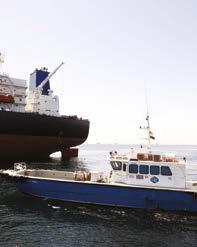

Safety is a collaborative effort, and only as strong as its weakest link, with ship agents having a key role to play. This is why GAC has maintained its long-standing ‘safe boarding initiative’, supporting local partners and suppliers in safety and compliance across the industry. Such initiatives aim to reduce risks to personnel and the environment. Man overboard, pilot ladder, and life raft safety training for GAC’s boarding officers and launch service providers – and those of the third parties it works with – can make the difference between a safe working environment and disaster.
SAFETY CULTURE
Human error can only be reduced so far, which is where data-driven digital frameworks can be essential. GAC’s QHSSE digital application is a useful tool in facilitating reporting, investigation, and follow-ups, enabling quick identification and mitigation of safety risks. The Group also nurtures a positive safety culture online with GAC Corporate Academy courses including Health, Safety, Security & Environment (HSSE), compliance, cyber security, and more to reinforce and promote awareness.
Meeting the safety needs of the future means addressing concerns beyond a company’s immediate remit. That’s why GAC vets its suppliers, choosing to only work with those that uphold the highest safety standards. What’s more, in 2023 we opened a dedicated course to safety and compliance to our third-party vendors, in a bid to minimise risks and set a commercial benchmark for the industry.



A safety report published by DNV and Lloyd’s List Intelligence in 2023 highlighted the importance of adapting to meet developing safety regulations. The transition to new fuels and engine types, vital for decarbonisation, presents fresh challenges with handling potentially dangerous materials. Simultaneous economic sanctions and geopolitical upheaval likewise need to be met with a counterconvergence of new technologies, smart training programs and regulatory body attention.
Regulations such as the IMO’s push to implement relevant codes and conventions, ensure the classification of hazardous materials and push members to enforce new fire-prevention schemes. However, stakeholders still need to take responsibility for their activities.
From a service provider perspective, stability, strength, and competence need to continually underpin operations alongside a comprehensive offering of services during a vessel’s port call. That means establishing a tone for safety through local operations, experienced personnel and a culture that prioritises vigilance.
Using drones for delivery and transitioning to online vessel clearance reduces the need for personnel to board the vessel and the associated offshore safety hazards. These are just examples of how we are driving positive change in the industry.
The world is rightly recognising the reality of continuously improving maritime safety. It is, and must remain, at the top of the agenda for us all. The fix can only become a reality when collaborative efforts across the shipping community are standard. l
40 Ship Management International Issue 108 March/April 2024
Maritime Safety
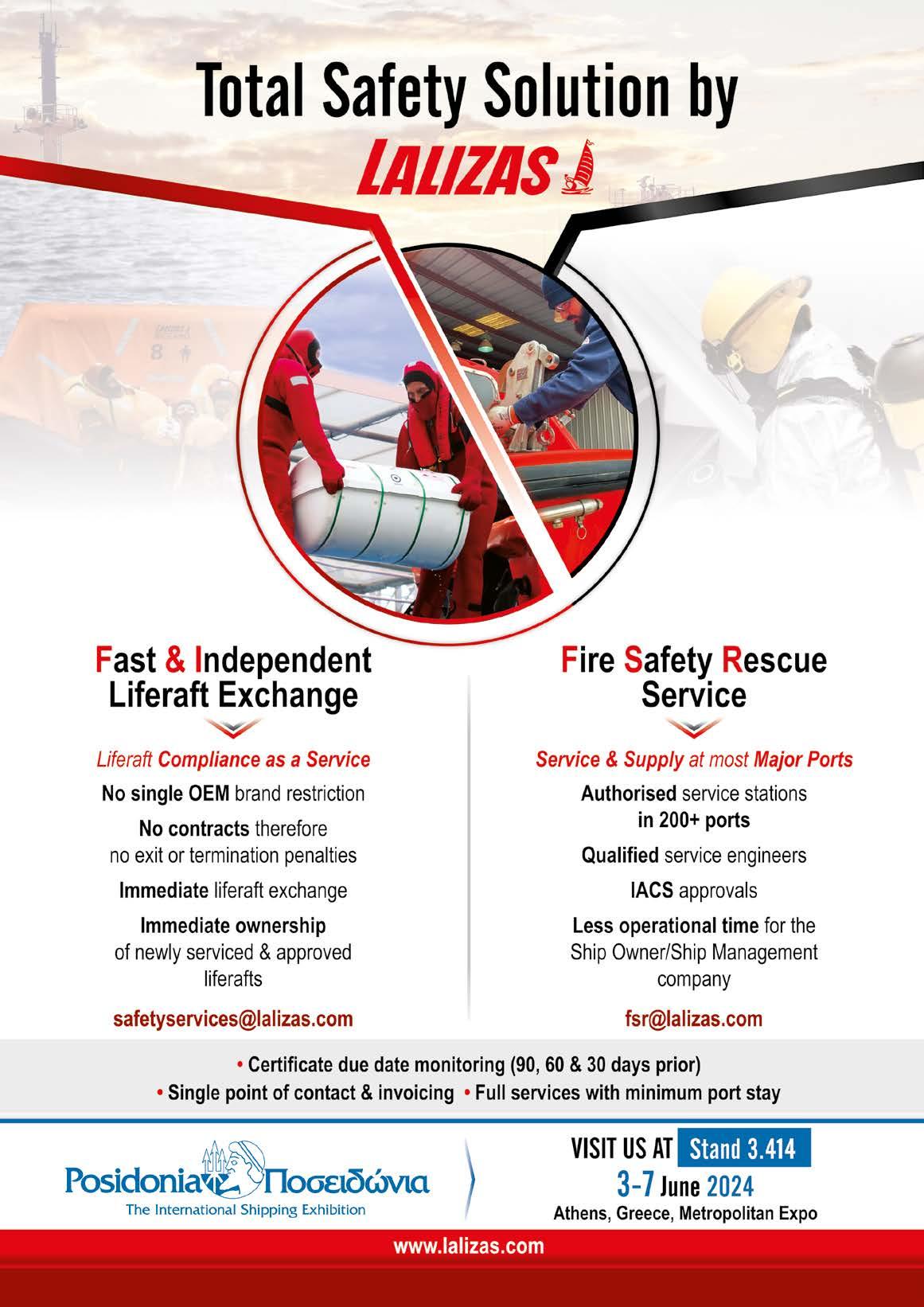
Safety is not just a product, it’s an ongoing process

Maritime industry is arguably one of the most multinational industries in the world - and one of the most risky ones.
Industry experts need to constantly stay vigilant when it comes to identifying hazards and monitoring maritime safety incidents to ensure the safety of everyone aboard.
“Defining patterns and keeping track of maritime safety incidents should be a fundamental aspect of our industry in order to guarantee safety at sea,” observed Mr. Iasonas Lalizas, Marketing & Communications Director of LALIZAS, lifesaving equipment manufacturer.
“Undoubtedly, one of the risks that has recently increased is the concerning rise in fire accidents aboard ships,” he remarked.
Authorities and industry experts have reported that these incidents involving fires, particularly on ships carrying electric vehicles (EVs) with lithium-ion batteries, have increased alarmingly in recent times. As a result, there have already been instances of shipping companies refusing to carry EVs on their ships because of the potential fire risk. As evidenced by the significant increase in recent incidents, fires on ships remain one of the most important safety concerns for the shipping industry and as a result, additional safety measures are now being implemented to actively prevent them.
More specifically, the revised EN 469:2020 standard, adapted from the MED Directive, introduces significant changes to the design and performance requirements for fireman’s suits.
The new standard comes into force on 25 August this year, and from that date, all fireman’s suits on board EU-flagged vessels will have to comply with the updated standard.
Given the present circumstances, LALIZAS proves to be one step ahead of times, offering an extensive range of firefighting gear, which includes the latest Fireman Suit called Antipiros.
“LALIZAS has been designing and manufacturing a wide range of lifesaving products specifically for the commercial marine industry for over four decades. Our commitment to safety at sea is demonstrated by our range of high quality firefighting equipment such as fireman’s suits. We are always striving to stay ahead of the curve, and for that reason we
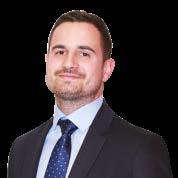
constantly work on evolving and expanding our products and services with the highest safety standards in mind. Our commitment to ensuring safety at sea in the face of evolving risks is demonstrated by our new Antipiros Fireman’s Suit,” Mr. Lalizas outlined.
In addition to the high quality of the lifesaving equipment, LALIZAS stresses the importance of proper maintenance and use to ensure the safety of all concerned.
“It is important to ensure that reliable and authorised Service Stations are used by both ship-owners and ship management companies,” notes Mr. Lalizas.
LALIZAS, with over forty years of experience, is equipped with the resources as well as the expertise to assist ship-owners and management companies with the safety of vessels and compliance with international regulations. This is achieved through the Fire, Safety and Rescue (FSR) services that LALIZAS provides in all the major ports of the world.
Moreover, another service now offered by LALIZAS is the Fast and Independent Liferaft Exchange (F&I). F&I is an innovative proposal for a simple and fast exchange of liferafts, without any contract or commitment on the part of the ship’s management and/or owner, while offering as a service the compliance of the liferaft with international regulations.
“As the company focuses on the future, we will continue to emphasise on safety and its essential role in the maritime sector, with high quality products and services aimed at safety at sea. After all in LALIZAS we truly believe that Safety is not just a product, it is an ongoing process” concluded Mr. Iasonas Lalizas.
LALIZAS is attending once again the Posidonia Exhibition (Pavilion no.3.414). This year, the manufacturer is also offering a seminar with industry experts, sharing their knowledge and expertise on issues regarding safety at sea. l

42 Ship Management International Issue 108 March/April 2024 Maritime Safety
Mr. Iasonas Lalizas
Antipiros Fireman Suit Set
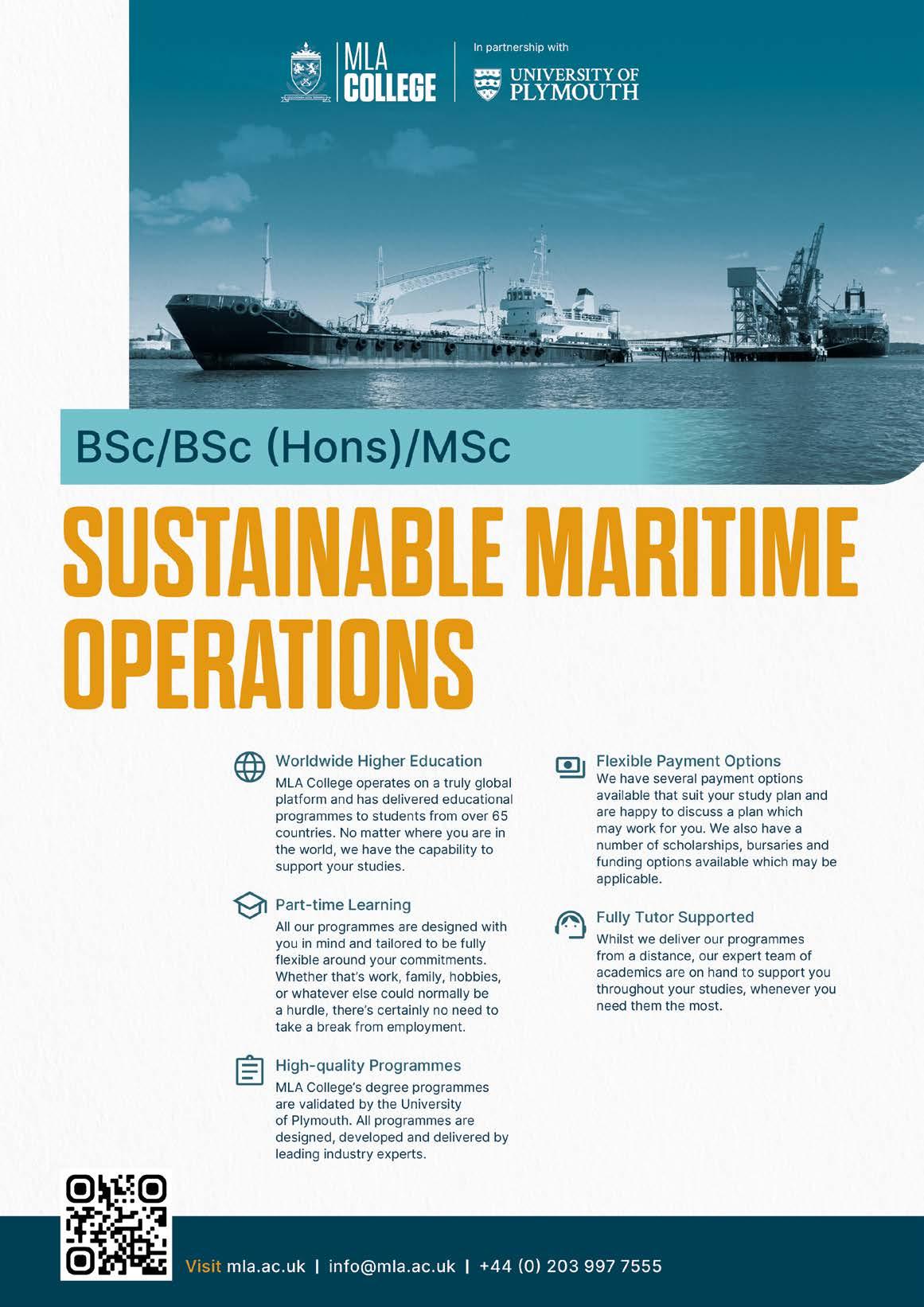
Decarbonisation
How onboard Carbon Capture & Storage can help drive shipping’s decarbonisation
By Sigurd Jenssen, Director, Wärtsilä Exhaust Treatment
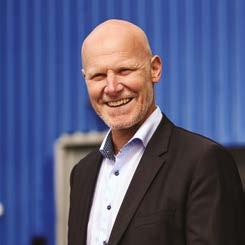
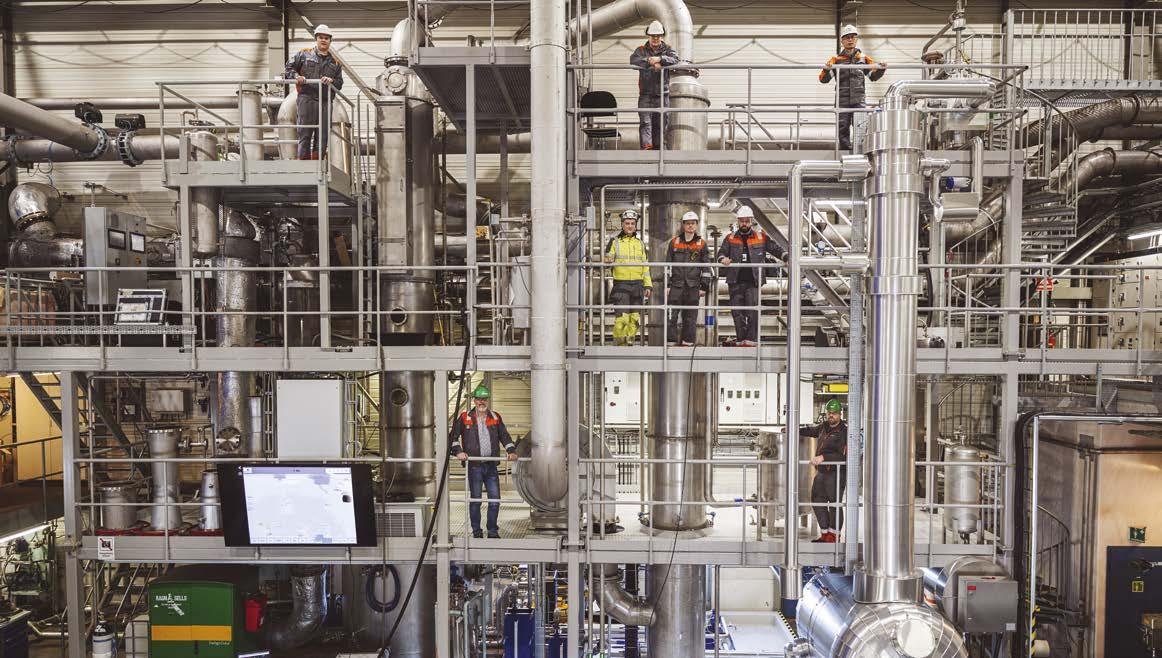
The global average temperature in January and February 2024 was 1.6°C and 1.77°C above preindustrial levels, respectively, surpassing the Paris Agreement’s 1.5°C benchmark, according to the Copernicus Climate Change Service (C3S) reporting on behalf of the European Commission. These months mark the ninth consecutive instance of record-breaking warmth for their respective months of the year; the urgency for us to act on the climate is clear.
To limit further temperature increases, the IMO has outlined its
strategy to reduce greenhouse gas (GHG) emissions from shipping, aiming for a 20% reduction by 2030, 70% by 2040, and net-zero by 2050. To meet these targets, shipping must utilise every available tool in its decarbonisation arsenal, from digitally enabled energy efficiency measures to the increased uptake of new fuels.
A range of solutions will be required. It is not possible to decarbonise shipping if we don’t optimise voyages, make ships more efficient, and move – where we can – away from an overreliance on fossil fuels. Add carbon capture &
storage (CCS) to this list – which will be commercially available next year – and suddenly the shipping industry has a compelling mix of technologies to choose from, as it works to meet its environmental targets.
CCS is so close to fruition because shipping has many years of experience tackling another pollutants directly in the stack – sulphur – through its efforts to comply with the global 0.5% sulphur cap. These efforts are now serving as the perfect technical and operational springboard to tackle the biggest pollutant of them all – CO2 – where it
44 Ship Management International Issue 108 March/April 2024
Wärtsilä Exhaust Treatment’s test hall in Moss, Norway
matters; on the ship, before it reaches the atmosphere.
This evolution from addressing sulphur to capturing carbon didn’t happen overnight. Over the past few years, scrubber capabilities have undergone successive upgrades to combat various pollutants in vessel emissions and throughout the propulsion chain. Selective catalytic reduction systems (SCR) and exhaust gas recirculation systems (EGR) have been employed to tackle NOx emissions, in order to meet MARPOL Tier III requirements. Moreover, these scrubbers can filter particulate matter and black carbon, even beyond standard land-based regulations, and they are capable of removing microplastics from scrubber washwater through advanced filtering systems.
To make CCS work within the confines of a ship exhaust, all noncarbon pollutants must be removed before the exhaust gas reaches the CCS system. Consequently, scrubbers have evolved from a technology aimed at reducing sulphur, NOx, and PM emissions for human health reasons, into a versatile technology platform ready to address shipping’s holistic environmental challenges.
On the commercial front, scrubber adoption remains economically compelling. The stable price differential between high and low sulphur fuels ensures that the payback period for scrubber installations has reduced to less than two years for several vessel types. Additionally, as the cost of new, lowcarbon alternative fuels remains high, the economic benefits of scrubbing are likely to endure for decades.
Wärtsilä Exhaust Treatment is currently trialling its CCS system in Moss, Norway, aiming for a 70% CO2 capture rate, with plans for a pilot installation within the next year. We believe that this is an initial optimum target, enabling us to balance commercial viability with regulatory targets. Extensive testing

has provided valuable insights into its operation and the merits of different CO2 capture solvents, while also showing that the capture rate can likely reach 80% with a solvent optimised for marine engine exhaust gas.
Whilst technological development progresses, understanding how it will integrate onboard a ship is vital. Seaborne CCS faces unique challenges, such as space limitations, energy requirements, storage infrastructure, and exhaust pre-treatment. Addressing these challenges is crucial for both new and existing vessels to achieve decarbonisation goals.
To tackle these issues, Wärtsilä is pioneering CCS feasibility studies, a first in the industry. These studies, lasting from four to six months, involve expert engineers researching and designing bespoke solutions. The primary aim is to assist shipowners in seamlessly integrating CCS technology into their vessels, in the future.
These studies cater to both newbuild and existing vessels, providing comprehensive commercial proposals for CCS integration. By closely analysing a ship’s architecture, Wärtsilä’s experts determine how to accommodate the power, space, and exhaust requirements of CCS onboard. This ensures minimal disruption during potential retrofitting.
Conducting these studies accelerates the initial phases of CCS integration and
educates customers on the benefits and complexities involved.
Equally important is the role being played by CCS-ready scrubbers. These scrubbers have been constructed with future CCS retrofits in mind, futureproofing them for when the technology is available, whilst ensuring near-term sulphur cap compliance.
Today, Wärtsilä is advancing to real-world testing on different ship types to assess how the technology performs during continuous operation at sea. This testing is crucial for understanding training requirements, the value chain, and service and maintenance organisation.
In the summer of 2024, the world’s first full-scale installation of Wärtsilä’s CCS technology is scheduled to take place onboard Solvang’s ethylene carrier, Clipper Eris, to prove technical viability and refine the technology. The success of this pilot is a precursor to the commercial launch in 2025 and will demonstrate the technical feasibility of retrofitting CCS technology.
Moving from the current phase of development, to supporting technology adoption at scale, requires huge investments and a sustained effort across the industry. It is time that we collectively raise our understanding of the potential this technology promises and recognise the critical role that it is poised to play in the industry’s decarbonisation journey. l
45 Issue 108 March/April 2024 Ship Management International Decarbonisation
Render of Wärtsilä CCS-ready scrubber system

Energy transition requires ‘finding efficiency in all the right places’

An achievable plan for transitioning to shipping’s low carbon future requires recognizing the full scope of challenges and opportunities arising from the energy landscape, writes Ardmore Shipping’s Director of Innovation, Garry Noonan.
Navigating the ever-evolving landscape of environmental regulations poses formidable challenges for shipping companies, and a strategy for the energy transition is crucial to remain competitive and sustainable in the long run. As regulatory bodies worldwide intensify their focus on sustainability, owners and operators find themselves grappling with the dual objectives of enhancing the efficiency of their fleets and managing escalating costs.
Within this context, it’s hard for shipowners to make the big calls on their long-term fuel and propulsion choices.
At Ardmore, our roadmap for tracking and reporting our progress is our Energy Transition Plan (ETP) that focuses on identifying and integrating efficiency initiatives that are right for Ardmore’s tanker fleet. This involves the development of alternative fuels, implementation of clean technologies, adopting innovative business models, and working in collaboration with customers who are themselves shifting towards a more environmentally friendly future. While many of these elements are long-term goals, the ETP also explores more immediate avenues to invest in solutions that will increase fuel efficiency and lower emissions in the short-term.
OPTIMIZING IDLE PERIODS
Through Ardmore’s ETP, we are constantly identifying and assessing new and emerging technologies that can boost fleet-wide performance. For example, whilst we implemented twelve different initiatives in 2022, we assessed over 100 possibilities.
To start, optimizing the efficiency of vessels
during stationary periods presents opportunities for significant energy savings. Anchored or berthed ships often rely on auxiliary power sources, such as generators, to maintain essential systems. Efficient energy management during these idle phases not only reduces fuel consumption, but also minimizes emissions and operational costs.
To enhance efficiency during stationary periods, we have utilized low-load boiler optimization. By upgrading the boiler control and burner systems, energy loss is minimized during ignition cycles. Through this process we have seen a remarkable reduction in boiler turndown ratios – which now sit at 5% of the normal load, down from 20%.
Decarbonisation Ship Management International Issue 108 March/April 2024
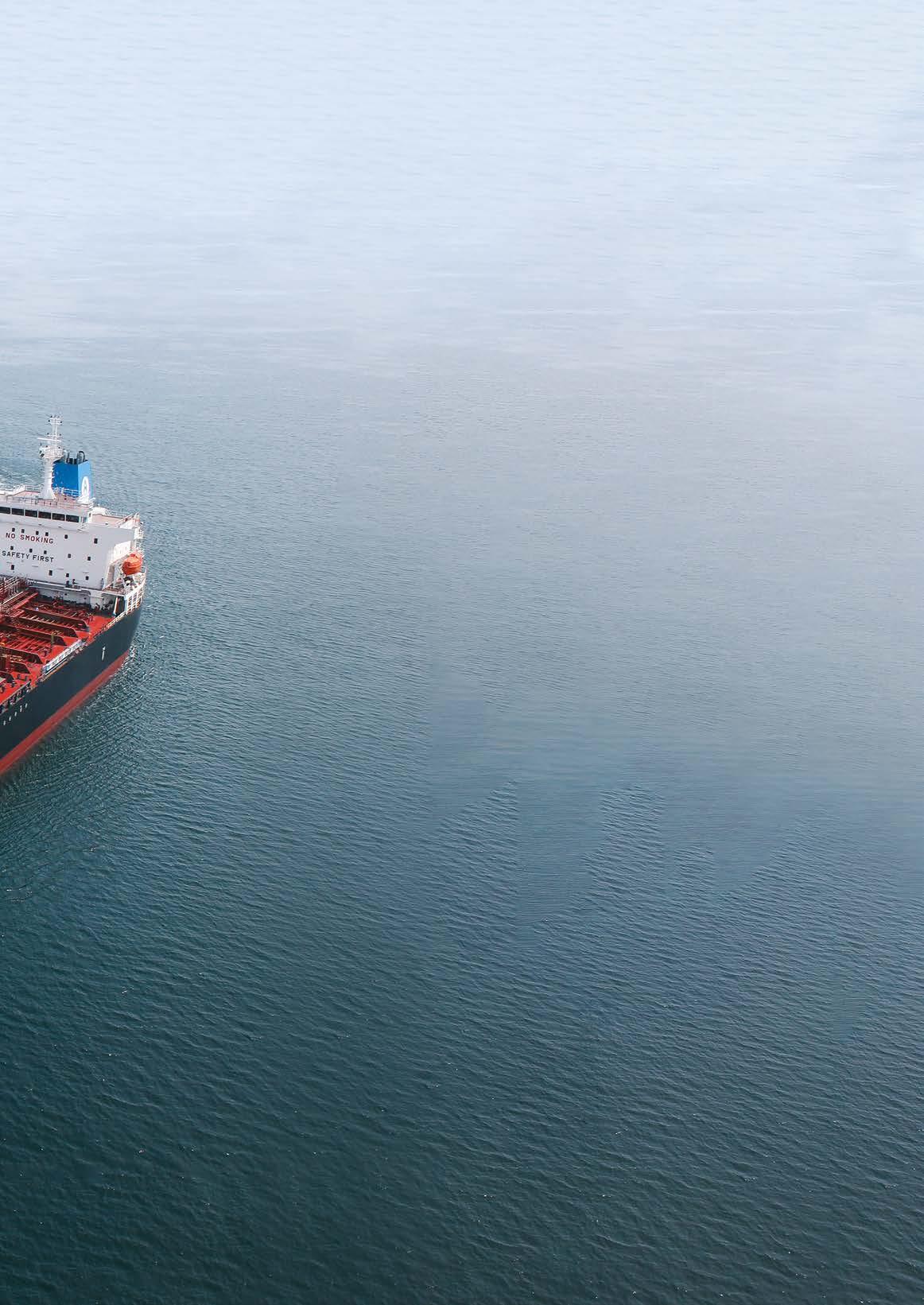
Alfa Laval’s micro boiler solution is also a technology we have embraced. The solution harnesses waste heat from generators, supplementing the main boiler when vessels are stationary. This has resulted in substantial fuel savings – up to a tonne and a half per day. The challenge lies in the space constraints on vessels, but we managed to install one on each of our MR’s during their planned docking periods.
ROUTING OUT EFFICIENCY
A key aspect of our approach remains the use of energy-efficient technologies across our fleet. To date, we have invested in fuelefficient engines, advanced hull designs, and other technologies that reduce fuel consumption and emissions.
This includes Manta Marine’s FuelOpt™ technology, which has been installed across our fleet. The system is designed to ease the technical burden of greener ship operations as it automates propulsion control, replacing the need for constant monitoring and manual adjustments. Through use of the system, our crew have full control of vessel speed, fuel consumption and/ or engine power, and are therefore able to avoid potential overconsumption of fuel in harsh conditions such as high swells and winds.
Variable speed drives are becoming standard in new builds, driven by evolving industry requirements. To optimize energy consumption, we are embracing this technology, which slows down pumps and fans based on demand. This ‘low-hanging fruit’ in energy efficiency has shown promising results, with an average fuel saving of about one tonne per day.
As shipping embraces the AI evolution, our collaboration with DeepSea Technologies has seen the rollout of their AI-enabled voyage speed optimization tool across our fleet. This solution aims to automate the process of adjusting speed based on market dynamics, balancing the value of time and bunkers, resulting in smarter decision-making.
We are also focused on other sustainability solutions, such as the Value Maritime Filtree system. Functioning as a sulphur scrubber with a twist, it filters washwater to remove particulate
matter and residues, ensuring responsible disposal. Additionally, the system is carbon capture-ready, aligning with our anticipation of future industry trends.
FOULING SOLUTIONS
Reduction in biofouling can improve both fuel efficiency and operational performance, and Ardmore is experimenting with ultrasonic transducers to maintain propeller cleanliness. We are also trialing using this technology to improve our speed log accuracy in the long term, which contributes to more reliable data for our performance management system.
Exploring innovations from Seacoat, our vessels are also undergoing trials with nontoxic, durable, and smooth coatings. The aim here is to reduce fouling by creating a very smooth surface, reducing the adherence of marine life, while also ensuring easy cleaning without compromising coating integrity. Furthermore, the non-toxic nature of these solutions prevents fouling, without causing damage to marine life.
TAPPING INTO A NEW ERA OF INNOVATION
We are making encouraging progress towards meeting the goals outlined in our Energy Transition Plan, driven by our willingness to embrace novel concepts, coupled with the meticulous evaluation process used to identify the most suitable solutions for our fleet.
A wide array of energy-efficient solutions has surfaced in recent years, ranging from advanced propulsion systems and fuel-efficient engines to innovative hull designs. These solutions are revealing potential savings in previously untapped areas, which is proving indispensable to achieving shipping’s decarbonization objectives.
As an industry, we can also make faster progress by sharing our approach and lessons learned with each other. As the energy transition unfolds, we hope other shipping organisations can also benefit from exploring the role of innovative technologies in helping them to make progress today towards a lowcarbon future. l
Decarbonisation 47 Issue 108 March/April 2024 Ship Management International


Education BLUE BOARD LEADERSHIP PROGRAM: Boosting the prowess of maritime directors amid uncertain times
Serving in the leadership of most business ventures is a tall order – not least against the backdrop of international conflict and uncertainties that are having huge impacts on the supply chains of global shipping and trade.
Tough questions abound daily, sometimes hourly, and even minute-by-minute over how to react to emergencies and to over-arching emerging trends. Even if the right broad strategies are in place, organisations and their leaders must be mentally agile enough to adapt swiftly to circumstances.
It is precisely at such crossroads that there is a need to bring into play a sound reservoir of knowledge as the basis for a holistic approach to finding solutions. This is where the distinctive Blue Board Leadership Program from Copenhagen Business School (CBS) stands ready to help provide the right grounding, to improve sharply the competencies of present and future members of ‘blue boards.’
The program is an initiative of CBS Board Leadership Education and the Blue MBA Alumni Academy and is funded and supported by the Danish Maritime Fund. It offers a robust training regime geared to the range of subject areas that

command, or should command, the attention of board-level representatives. The project benefits from the active support of accomplished professors (from CBS and other international universities and business schools), experienced board members, and partners from EY (who contribute their expertise on annual reports and finance issues) and leading law firm Kromann Reumert which has offices in Copenhagen, Aarhus, and London.
The course works on the premise that developing an appropriate intellectual and practical ‘tool kit’ will fortify the prowess of each board member so that he or she can delve quickly and deeply into the tasks and problems coming across (sometimes hurtling across) their desks and find ways to communicate their conclusions with real effect. Much of the narrative they face may be driven by conflict outside the boardroom arena, but that is what should motivate integrated and exhaustive analysis.
Among topics covered by the Blue Board Leadership Program are the ABC of board membership (including how to handle the dynamics within individual boards), corporate
50 Ship Management International Issue 108 March/April 2024
law, legal responsibilities, financial management, succession planning, how to formulate decisions, the vital need for diversity, building the capital base, assessing the global outlook for the maritime industry, geopolitical and societal trends, sustainability, digitalisation, innovation, disruptive business models, cyber risk, cyber security and cyber governance, and supply chain trends.
With the world tearing itself apart in one way or another, and the best-laid plans capable of falling apart, many ‘experts’ are ready with snappy answers. Unfortunately, those answers usually turn out to be partially or downright wrong.
In the past two years, and even more so in the past few months, factors including the legacy effects of the Covid-19 pandemic, smouldering and active wars in Ukraine and elsewhere, the force of climate change, a new upsurge of piracy, and intractable inflation, have heightened the interconnected tensions.
The flare-up of developments in the Middle East is a sharp example of shifting scenarios that pose dramatic and unexpected consequences for trade, shipping lanes, demand for commodities, and pricing. The numbers involved can grow rapidly (for instance, a rethink has had to be made about the routeing of the 30% of global container traffic that normally passes through the region).
That crisis, parallel with the Ukraine war, has restructured the flow of oil and other commodities through some of the most important waterways in the
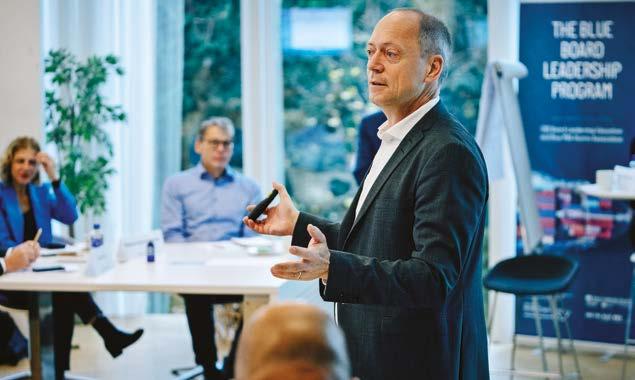
world, and the widespread economic implications have yet to play out fully.
More than at any time in the past few decades, the geopolitical situation dictates everyday concerns including security and the vulnerability of markets to disruption. If re-routeing via the Cape of Good Hope of Red Sea traffic goes on for an extended period, it is likely to contribute to delay in achieving CO2 emission targets, as the longer sailings will require more bunkers and push up other costs.
Reports have suggested it might lead to a more than five-fold increase in CO2 emissions per twenty ft container.
Simultaneously, on the other side of the world the Panama Canal draught restrictions are causing new headaches for voyage planners, with some services arranging partial transits over land.
Of great concern on all these fronts is that the data to assess the risks is often unwieldy or opaque amid the fog of hostilities and drama of meteorological

surprises. Data can drive efficiencies, but do we have the skills to interpret it?
Apart from big changes in digitalisation, on the menu for the maritime industry are defence against cyber risks, and the spreading net of international regulation. It is recognised that directives are not uniformly applied: regulators, industry experts and technologists have much work ahead on such imperatives as designing the new framework for autonomous ship operations.
Part of the spur towards a more sustainable maritime industry by way of greater voyage optimisation and de-carbonisation is the introduction of the EU’s Emissions Trading System (ETS), the community’s commercial lever to mitigate the effects of climate change, and a watershed as the world’s first major carbon market. To stimulate the use of renewable and low-carbon fuels, ships (initially cargo and passenger vessels of 5,000 gross tons or more) that trade to, from or within the 27-nation
Education
51 Issue 108 March/April 2024 Ship Management International
bloc will have to comply with the ETS; and with a provision named FuelEU Maritime. The latter mechanism will from 2025 impose increasing caps on the carbon intensity of fuel. FuelEU Maritime portends new collaboration among stakeholders, including fuel suppliers, shipbuilders, and shipowners, to accelerate the affordability and availability of sustainable marine fuels.
The ETS requires that ships pay for the right to emit greenhouse gases by buying allowances which are financial instruments that can be traded. Operators of all ships will have to calculate their attained Energy Efficiency Existing Ship Index (EEXI) to measure their energy efficiency and to initiate the collection of data for reporting their annual operational carbon intensity indicator (CII) and CII rating, which will be A, B, C, D or E (where A is the best). Any ship rated D for three consecutive years, or E for one year, will have to submit a corrective action plan to show how a level of C or above will be achieved. This is bound to mean that costly remediation plans will have to be drawn up for several thousand ships globally.
Blue board members are thus unavoidably among those who have a big responsibility to drive the targeted reduction by 2030 in EU greenhouse gas emissions of at least 55% compared to 1990 levels, but at the same time they may have in the light of a greater cost of financing their assets and an increased cost of trading in the EU, to adjust their operational policies.
Discussions within the Blue Board Leadership Program are sure to address the big talking point of the past year: the rapid advances in the field of artificial intelligence which could be heralding an age of opportunity in the industry or be a source of problems and unforeseen risks. Even more important than AI though is what might be called the ‘people question’ and boards will need to focus on harnessing human resources ashore
and at sea where perceived threats in the shipping lanes, working conditions in some sectors, and bureaucracy over visas are deterring recruitment.
All in all, it cannot be denied that demands upon, and expectations of, current and future ‘blue board’ members are continuously accelerating, presenting increasing complexity, unpredictability, and volatility, and the need for a tight grip on risk management and on aligning with the Environmental, Social, and Governance (ESG) agenda which is high in the sights of reputable investors.
A challenging matrix therefore for men and women at the helm of business decisions, but an invigorating prospect for all who are passionate about the industry – so let us not despair. The ‘blue boards’ that navigate skilfully these turbulent waters will take advantage of new market opportunities, increase financial yields, and enhance shareholder value.
Incorporating sound principles and best practice for effective board membership, the Blue Board Leadership Program during the eight days of each course explores case studies – around 20 of them –so that participants can learn from successes and from failures. Led by an impressive faculty of two dozen professors, board leaders, advisors, and industry experts, they see how

high-performance boards operate under different governance regimes.
The Blue Board Leadership Programme began in late 2022, drawing on expertise from CBS Executive, which designs and runs senior executive and board governance educational programmes, and the Blue MBA Alumni Association, whose members have graduated at various times over more than two decades from Copenhagen Business School’s renowned Executive MBA in Shipping & Logistics (the Blue MBA).
Blue MBA Alumni Association/ Academy chief executive Irene Rosberg has said that the Blue Board Leadership Program has as its starting point the requirements of the maritime industry, including its many and varied service providers, for leadership that has at its fingertips a wide and up-to-the-minute variety of skills and abilities.
The next Blue Board Leadership Program will take place in two modules of four days each: Class of 2025 module 1, December 2-5, 2024; module 2, January 27-30, 2025. Both will be at Copenhagen Business School, CBS Board Education, Porcelaenshaven 22, 2000 Frederiksberg, Denmark.
Further information is available from program directors Kim Vestergaard kv@ cbs-executive.dk and Irene Rosberg ir.mba@cbs.dk l

Education


Regional Focus
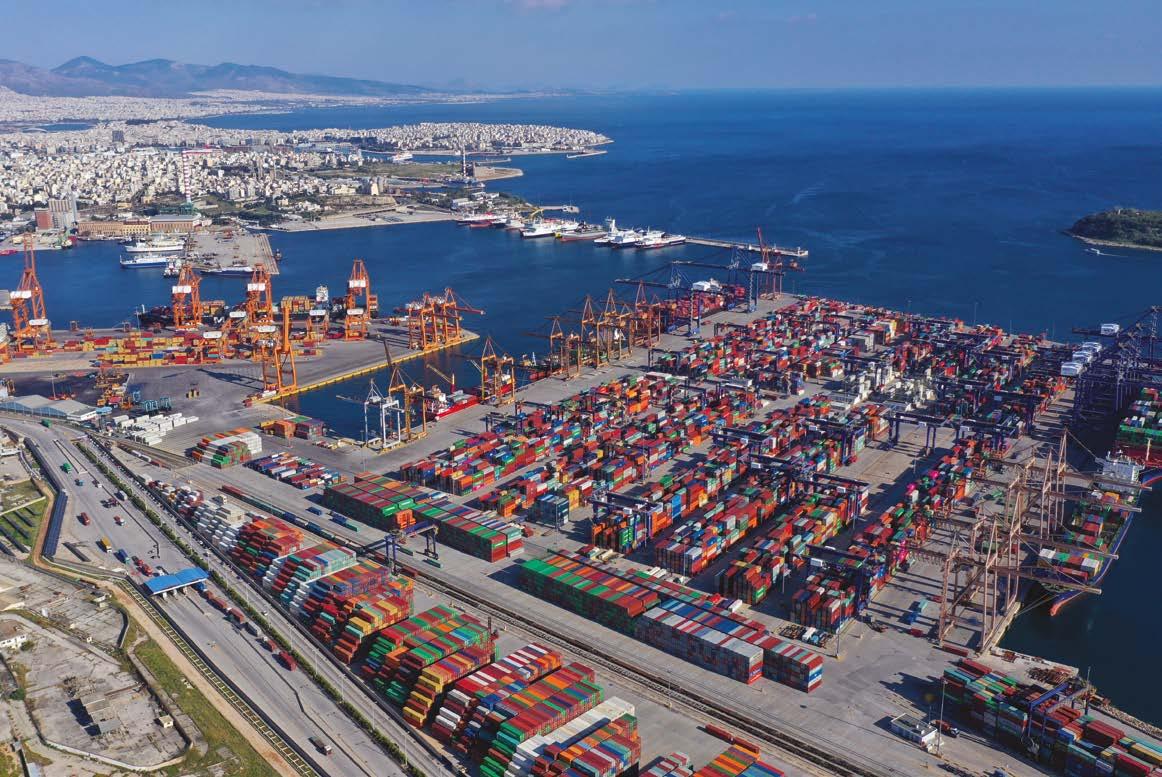
Rising to the challenge of energy transition
Greece remains the world’s largest shipowning nation controlling more than 4,200 vessels totalling over 330m dwt and 200 million gt, a record amount, according to figures released by the London-based Greek Shipping Cooperation Committee (GSCC) earlier this year. And that total continues growing, with a 50% surge in newbuilding orders over the past year, the GSCC added.
Decarbonisation is clearly a key concern for Greek shipowners, as it is for the rest of the industry, and particularly so given Greece’s traditional involvement in tramp shipping or cross-trading, where the reliable supply of alternative fuels may not be as guaranteed as on, say, regular mainstream liner routes. Nevertheless, the country’s shipowners remain staunch supporters of IMO’s ambitious targets to reduce greenhouse gas (GHG) emissions from shipping.
The Union of Greek Shipowners (UGS) took a leading role in the ‘Shaping the Future of Shipping: Delivering a Net Zero World’ Summit, organized in the context of COP 28 climate summit hosted by the International Chamber of Shipping (ICS) in Dubai in December 2023. The industry flagship event featured the participation of over 300 leading representatives and government officials from the maritime and energy sector, from 30 countries.
The President of the UGS, Melina Travlos, stressed shipping’s core message about the sector’s decarbonisation: the imperative need for cooperation and coordination of all parties involved in the transport chain, for the achievement of the goals of the IMO, underlining the importance of a unified approach among governments, regulators, and

stakeholders, and inviting all states to support the IMO in its ambitious work. Her speech became an inspiring reference point throughout the Summit’s discussions.
“Time flies and yet large challenges remain, and new ones are emerging,” said Ms. Travlos. “However, if we can work together to achieve our shared goals, the prize will be greater than the greening of our industry, it will be the greening of all industries. We cannot even discuss, let alone succeed, with a global energy transition without shipping and its role as a catalyst in every aspect of socioeconomic change and progress. Shipping has always built bridges for growth and prosperity. This is our purpose, our duty, and our commitment to the world.”
During the Summit, Dimitrios I. Fafalios, Secretary of the Board of Directors of UGS and President of Intercargo, participated in the discussion about the decisive role of seafarers in the transition to net zero shipping. It was emphasized that seafarers must be trained appropriately to acquire the necessary skills to use new technologies and alternative fuels on board ships safely–an essential factor in protecting human life and the environment.
During his participation in the discussion of Ministers, Christos Stylianides, the Greek Minister of Maritime Affairs and Insular Policy, highlighted the importance of cross-sector cooperation in achieving the goal of decarbonising shipping. He stressed the need for collaboration among all parties involved, including energy producers, equipment manufacturers, port authorities, and the shipbuilding community, to develop practical and realistic solutions. l
55 Issue 108 March/April 2024 Ship Management International
UGS President Melina Travlos with Minister Christos Stylianides
Leading Greek shipowners partner with LR on Maritime Emissions Reduction Centre
Five leading Greek shipowner companies are collaborating with the Lloyd’s Register (LR) Maritime Decarbonisation Hub to set up a not-for-profit global Maritime Emissions Reduction Centre (M-ERC) in Athens that will focus on optimising the efficiency of the existing fleet. The five Founding Members of the M-ERC are Capital Group, Navios Maritime Partners, Neda Maritime Agency, Star Bulk and Thenamaris.
At the time of the announcement in February, Evangelos Marinakis, Chairman and Founder, Capital Maritime & Trading Corp. said: “We are proud to be a part of this alliance that aims to establish an ecosystem for research and innovation in the shipping industry in Greece. Energy transition in the shipping industry is a challenge that necessitates collective forces.”
Angeliki Frangou, Chairwoman of the Board and CEO of Navios Maritime Partners LP commented: “Navios believes in the fundamental importance of developing appropriate technologies and solutions for reducing carbon emissions. As responsible members of the global community, we continue to investigate novel approaches for solving this complex problem. We are delighted to collaborate with Lloyd’s Register, and we hope our collective efforts will bear fruits in the short term.”
Nikolas Martinos, CEO, Thenamaris, added: “There is a pressing need to identify and implement safe and practical solutions as we transition to the fuels and technologies of the future. As a Founding Member of the M-ERC, Thenamaris is committed to being an active partner in this initiative.”
“Energy saving technologies and operational practices will play the primary role in delivering the 30% reduction of emissions targeted by the IMO in just six years from now,” pointed out Nick Brown, LR CEO. “So, we need to make every upcoming drydocking count and

the Maritime Emissions Reduction Centre in Athens will support our industry to evaluate and implement existing and new solutions.”
Elina Papageorgiou, Lloyd’s Register’s Global Director for Strategic Goals and VP for Greece & Cyprus, explained to SMI that the LR Maritime Decarbonisation Hub, established in 2020 with a strong presence in Greece, is a joint initiative with the classification society’s unique charitable umbrella body, the Lloyd’s Register Foundation. It aims to “steer thought leadership in terms of the upcoming energy transition” by creating projects and collaborations to accelerate decarbonisation, and covers not only work on the technical side but also considerations of “community and investment readiness”, bringing together a broad range of stakeholders outside ship operating circles such as charterers, ports and fuel providers. Examples of the Hub’s collaborative efforts include the Silk Alliance to build a network of ‘green corridors’ out of Singapore, and the work conducted with the Sustainable Shipping Initiative on ‘Green Steel’.
Creation of the M-ERC was thought necessary to focus on the existing fleet and “what can be done today” in terms of optimisation for meeting the IMO’s decarbonisation goals of 2030, ahead of those of 2040 and 2050, she continued. This will mean an emphasis on retrofit solutions given that many shipyard slots are full until 2027/8 and the existing orderbook today is mostly for vessels using conventional fuels.
Athens was chosen as base for the M-ERC “primarily because of the broad range of ship types controlled by Greece’s owners”, Papageorgiou explained, which together represent some 20% of the world fleet and 60% of the European one. But it is planned to later expand to other locations and widen membership to include other stakeholders, she added, with an announcement to this
56 Ship Management International Issue 108 March/April 2024 Greece Report

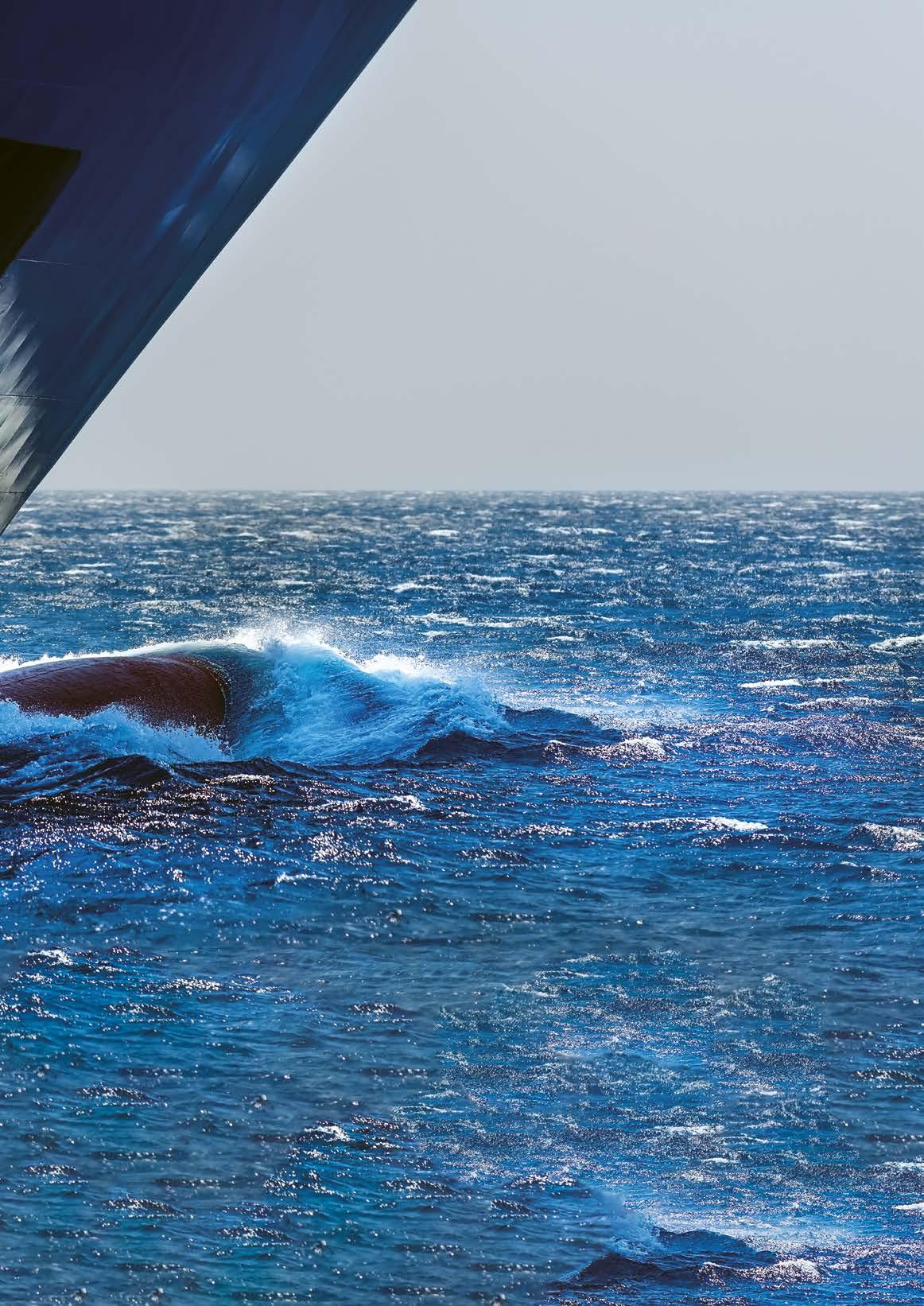
Athens was chosen as base for the M-ERC “primarily because of the broad range of ship types controlled by Greece’s owners”
Eleni Papageorgiou, Lloyd’s Register
effect and details of initial M-ERC projects expected to be announced in the coming months.
The LR executive stressed that the M-ERC is intended “for the greater good of the industry” rather than the competitive advantage of any individual companies. The five founding members are all shipowners that LR is already working with across a wide range of areas she added, an area where LR has a technical consultancy arm with broad-ranging expertise.
Lloyd’s Register has some 180 employees based in Greece, including 30 working in digital arm LR OneOcean which operates one of the industry’s largest digital solutions for over 22,000 vessels and also provides “support for decarbonisation on the digital side of things”. Global Directors of several of LR’s sectoral teams – including Tankers, Bulk and Gas – are all based in Greece, as is the Newbuilding team and Global Technical Client care. “Lots of global positions are here, and that’s because of the pace of the market and the conversations we’re having here.
“There has been much progress on addressing energy transition challenges in the past two years,” Papageorgiou concluded. “Then there were a lot of unknowns but there’s a lot more known today. Collaboration is key and the M-ERC gives an opportunity to develop that. A lot of strategy and investment in LR has been based on this. We have a lot of ways to support that conversation and much experience on working different fuels. We want to push that envelope as a trusted partner towards practical solutions that we can then bring to bodies like the IMO for endorsement as a safe and sustainable means of energy transition for the maritime industry.” l


Greece Report 57 Issue 108 March/April 2024 Ship Management International
Representatives from the M-ERC founding members at the launch event (l to r): Spyros Capralos, Chairman of BoD Star Bulk; Michael Lykiardopulo, Principal, NEDA Maritime; Nick Brown, CEO, LR; Angeliki Frangou, Chairwoman of the Board and CEO of Navios Maritime Partners LP; Evangelos Marinakis, Chairman and Founder, Capital Maritime & Trading Corp; and Nikolas Martinos, CEO, Thenamaris
Angeliki Frangou shakes hands with Philippa Charlton, Chief Marketing Officer, LR, with Natassa Kouvertari, Decarbonisation Programme Manager, LR Maritime Decarbonisation Hub, also pictured (far left)


DABS steps up to the challenge
By Elias Kariambas, Vice President, Regional Business Development, Greece, ABS
ecarbonization and the energy transition present a global challenge and the local Greek shipping market is no different. Shipowners must achieve a once-in-a-generation change with two core elements; reduce their own carbon emissions and embrace the emergence of new value chains.
Greek shipowners have responded with orders for conventional and dual fuel tonnage as well as ships that will carry the emerging cargoes of the energy transition: ammonia, methanol, and CO2 itself. In the process they are demonstrating their endlessly innovative approach of responding to the prevailing environment and capturing the commercial opportunity.
In response ABS has invested in broadening the capabilities of the Athens office, drawing on specialists to create world-leading centers in sustainability, ship systems and digital capability.
Our Global Sustainability and Regulatory Affairs services are run from the Athens office, with specialists on hand to provide advice across a range of subject areas. We have personnel dedicated to sustainability and performance, while three engineers represent ABS to IACS and two to IMO to provide
real capability and knowledge from these bodies on topics like safety, machinery and environment.
In addition, ABS organises regular events and seminars in Greece providing updates and insight into industry issues, while our experts participate in all major events and conferences. The office also participates in numerous European Union-funded research projects aimed at fostering a safer, more efficient, lower carbon industry.
Our strategy for the Athens office is always to differentiate ourselves from the competition, providing the best possible service and solutions.
To respond to the needs of shipowners we have to innovate; establish new departments and services and be the leaders in the service we provide. As competition increases it is important that we improve every day and move continuously forward. For that we have to always be close to clients and give them reasons to be with ABS; because we are proactive and responsive as their technical advisor and safety partner.
Another important issue is to draw on the most experienced, best-educated personnel and retain them, as well as being attractive to potential those graduating or seeking to join an organization with exciting prospects. l
HELMEPA launches energy transition project METAVASEA
For over four decades, the Hellenic Marine Environment Protection Association (HELMEPA) has been spreading the spirit of voluntary environmental commitment worldwide and contributing to the training of more than 33,000 seafarers and shipping professionals.
Now HELMEPA has launched a landmark new METAVASEA (from the Greek word ‘metavasi’ meaning ‘transition’) project, announced at last December’s COP28 by the US State Department as one of the 50 new entries of the Green Shipping Challenge.
METAVASEA places the human element at the heart of maritime decarbonisation through the training and upskilling of 1,500 seafarers, shipping professionals, and port workers in new fuels, digital awareness, sustainability, and soft skills. It also seeks to boost the involvement of shipping companies and ports in maritime decarbonisation initiatives, offer insights into shipping and community readiness for new fuels, and raise climate awareness generally in the East Mediterranean – a climate change ‘hot spot’.
The project is supported by Lloyd’s Register Foundation, and brings together six partners, 12 associate partners and 60 supporting organizations in Greece, Cyprus, and the wider East Med. l
58 Ship Management International Issue 108 March/April 2024 Greece Report


with Costas Th. Kontes, Managing Director, V.Ships Greece
SMI) Please describe the scope and size of the V.Ships Greece operation and the profile of your clients.
CK) V.Ships Greece is currently operating close to 80 ships belonging to some 20 different clients, plus we have another 150 vessels under crew management. Vessel types include contanerships, bulkers and tankers.
We are the largest independent third party manager in Greece, both in terms of the number of vessels and number of shore-based employees here, close to 80, serving the local market.
Our clients are about 90% Greek and include a variety of different types of owners, from large owners that also have their own in-house management departments for whom we provide incremental services, to typical small owners with just one or two vessels for whom it’s not sustainable to have their own in-house management operations. Another type of client is the investor who is in shipping purely because they saw it as the right time in the cycle to enter. Then there’s the client that has decided to benchmark itself against other technical managers
SMI) What do you see as the main advantages of third party management?
CK) The biggest advantage is the obvious one of economies of scale, particularly when it comes to purchasing items. Then there’s the fact that we have been able to invest in our platform and systems in order to support our clients, which is especially important at times of new regulations and when there’s any crisis in the market. Also we operate in 18 different locations around the world, using the same systems in every office, and we have a huge crewing network. These are all elements our clients appreciate.
SMI) How are you helping clients harness the full benefits of digitalisation?

CK) Having been in this business a number of years, V.Ships has been able to develop an in-house platform called ShipSure, which has been central to our collecting and sharing data and delivering insights to clients over the last 15 years. This can provide both clients and individual vessels with any information they need on matters such as crew, finance, safety, procurement and more. It’s an integrated ERP (Enterprise Resource Planning) system with capabilities to connect with every other software or tool in the market.
ShipSure allows us to provide the right amount of information to stakeholders so they can make the right decisions. It builds up BI (Business Intelligence) reports through the data that each ship generates, with a dashboard functionality to identify elements of concern. We strongly believe in the importance of the human element but feel it needs the assistance of an automated system to help ensure the right decisions are made.
SMI) Can you please give some examples of reference clients?
CK) Our biggest client is Costamare where we have enjoyed a partnership over many years and currently manage over 40 ships. We have helped them both on the container side and on the bulker side when they decided to invest in that ship type. Other major clients include Seanergy, publicly listed in the US, and Empros Lines.
SMI) And on the big challenge of decarbonisation, how is V.Ships Greece assisting?
CK) We are working closely with our clients, providing them with the right studies in what they need to invest. We have a consultancy called V.ERDE (Vessel Emission Reduction
60 Ship Management International Issue 108 March/April 2024
& Decarbonisation Enhancer) with a team of people with the technical expertise able to provide solutions for our clients’ needs, on meeting the requirements for these new fuels and new regulations like the EU ETS (Emissions Trading System). This is currently the single biggest point of concern for our Greek clients. Here we have partnered with Aither, which provides carbon trading solutions for shipowners, and built up a product that supports our clients and provides the data they require in claiming from charterers the allowances that they need. So we have the organisation behind us to support all these initiatives.
SMI) Some believe the challenge of decarbonisation may lead to the demise of the small Greek ship owner/ operator? What are your views on this?
CK) It depends on how you define that. If you mean a small owner that manages their vessel(s) only on their own, then I think that is a challenge and not really sustainable. But if you mean a small operator doing the commercial part of the business while using he platform and scale of an organisation like V.Group to manage the vessels, then I think that is something that will continue for the

future. We see many owners who are operating on a small scale entrusting operations to us in this way – it’s win-win situation for both partners.
SMI) Is third party management in general on the rise in Greece?
CK) Yes, definitely. The younger generation has a lot of people with a that are more interested in the business side of things, with a new mindset to those of the past, and that brings ship managers into their zone of interest.
For example, we started V.Ships Greece back in 1994 but third party management in Greece was at a very early stage then so we decided not to manage any ships out of Greece. The first ones we did manage was in 2013 when we started our partnership with Costamare. Twenty years later, in December 2023, we were managing 98 ships – a number that has since dipped (to 80) because of a number of ships sold in this good market.
It’s remarkable to have seen such steep growth in what’s probably the most difficult market for outsourcing.
SMI) Thank you very much for your time and insights, Mr Kontes. l

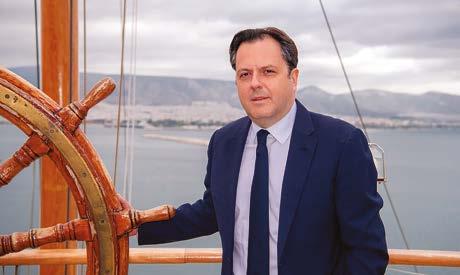
61 Issue 108 March/April 2024 Ship Management International Greece Report
V.Ships Greece office with Costas Th. Kontes at the helm
2 Minutes
with Ioannis Marinakis, Marketing manager, Kyvernitis Travel Group
Q) Please describe your company and the scope of its activities, as well as any milestones in your development.
Kyvernitis Travel Group, marking its 50th anniversary in 2024, stands as a leader in Greece’s travel sector, with a rich legacy since 1974. Our team of over 130 professionals delivers exceptional services in Crew and Business Travel, Meetings and Incentives, Sports and Events, and Luxury Leisure Travel. A pivotal moment in our history was the strategic acquisition of the American Express GBT office in Greece in 2021, a testament to our growth and commitment to excellence. We pride ourselves on values of trust, integrity, innovation, and customer-centricity, driving us to surpass expectations and set industry standards.
Q) Are there any particular challenges in providing crew travel for Greek shipowners, and what advantages do you as a Greece-based company have?
Greek shipowners, particularly those involved in tramp shipping, face significant challenges due to irregular routes and unpredictable schedules. Coordinating efficient crew travel under these conditions requires high adaptability and expertise. As a Greece-based company, Kyvernitis Travel Group leverages extensive local knowledge and strong relationships with shipowners to deliver bespoke crew travel solutions that address these unique challenges effectively.
Q) How has the crew travel market generally and the complexities of your business been affected by recent geopolitical disruption?
The recent geopolitical events, including the RussiaUkraine conflict and Red Sea crisis, have introduced significant uncertainty, travel restrictions, and safety


concerns into crew travel. These challenges have necessitated a more vigilant approach to monitoring developments, adapting travel plans swiftly, and prioritizing the safety of crew members while ensuring operational efficiency. Our team is committed to maintaining seamless travel logistics amidst these complexities.
Q) Are decarbonisation and the desire to cut emissions impacting clients’ travel choices and if so, how are you able to cater for this?
The global push towards decarbonisation is increasingly influencing our clients’ travel decisions. In response, Kyvernitis Travel Group works closely with clients to promote sustainable travel practices. This includes offering carbon offset programs, advocating for energy-efficient travel options, and implementing nature-based solutions. Our dedication to reducing emissions is aligned with our clients’ environmental goals, reflecting our commitment to sustainability.
Q) Are there any other points that you would like to bring to the attention of SMI readers?
At Kyvernitis Travel Group, we are continuously pushing the envelope on innovation, transparency, and climate-positive actions. Our forward-thinking approach positions us as a pivotal partner in the travel industry, ready to meet future challenges and opportunities with cutting-edge solutions and a commitment to sustainable practices. l
62 Ship Management International Issue 108 March/April 2024 Greece Report
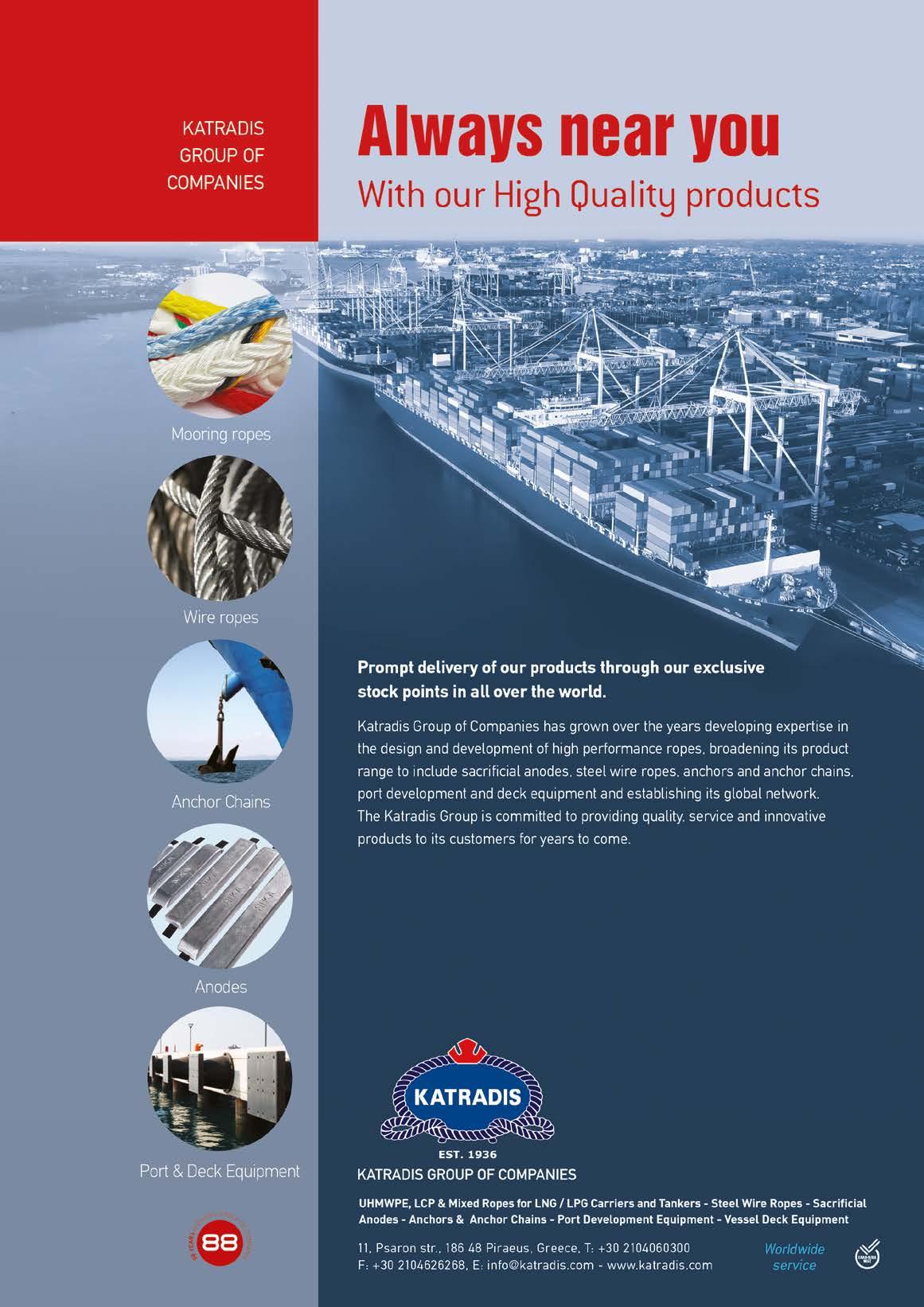
Harbor Lab and 90POE join forces
In a strategic alliance aimed at providing greater efficiency and transparency of port call operations for clients, Athens-based Harbor Lab recently announced it was strengthening its longstanding collaboration with 90POE (90 Percent of Everything) by joining forces.
Harbor Lab is a global leader in centralising and simplifying port cost management via its robust platform, while 90POE (90 Percent of Everything) is developer of the next generation platform OpenOcean STUDIO.
Under the collaboration Harbor Lab will bring its expertise in optimising, digitalising, and streamlining the disbursement account analysis process, a historically complex and time-consuming aspect of shipping operations. Its full suite of solutions delivers value across the entire port call management, ensuring quick and accurate port cost estimates, reliable validation of actuals, efficient payments, and expedited claims process through technology, transparency, and automation.
90POE’s OpenOcean STUDIO, is a dedicated platform built by the industry, for the industry, which enables ship owners, operators, and managers to transform their entire maritime operations with a comprehensive solution for operational and commercial management whether on-board, on-shore or on-the-go.
The two companies say key benefits of the integration will include: streamlined port call planning and coordination; enhanced transparency in operations throughout the port call process, allowing clear insights into agent appointments and disbursement activities; and optimised port expenses at the same time as reduced operational workflows, leading to substantial cost savings and time efficiency. l


HEMEXPO links with DNV over energy-saving devices
HEMEXPO, the Hellenic Marine Equipment Manufacturers and Exporters association, is committed to delivering environmentally friendly solutions and services to support shipping’s green transition. Its member companies offer sustainable technology including energy-saving devices, friction-reducing hull coatings, shore connection facilities and carbon capture systems.
In late 2023 HEMEXPO reached an agreement with DNV for the classification society to assess the energy-saving devices (ESDs) produced by its member companies.
Under the terms of the agreement, DNV reviews a makers list provided by HEMEXPO to confirm ESDs that fall in the category of energy saving devices and describe the regulatory metrics - i.e., the Carbon Intensity Indicator (CII) and the Energy Efficiency Existing Ship Index (EEXI) - they influence.
“Our agreement with DNV is a significant breakthrough as it aligns closely with the need for an international standard on ESDs, and HEMEXPO’s endeavours to encourage the marine equipment industry’s transition towards green solutions,” said Eleni Polychronopoulou, HEMEXPO President (pictured, centre, with other HEMEXPO board members).
Chara Georgopoulou, Head of the Maritime R&D and Advisory and Onboard CCS (Carbon Capture Systems) Manager for DNV Greece, commented: “ESDs can be instrumental in helping to reduce fuel use, cut greenhouse gas emissions and fully contribute towards compliance. For wider adoption however, the industry needs confidence in the technology. By working together to review HEMEXPO member products, DNV is proud to help build this confidence and ensure that the shipping industry can use ESDs to meet its decarbonisation goals.” l
Greece Report
Ship Management International Issue 108 March/April 2024
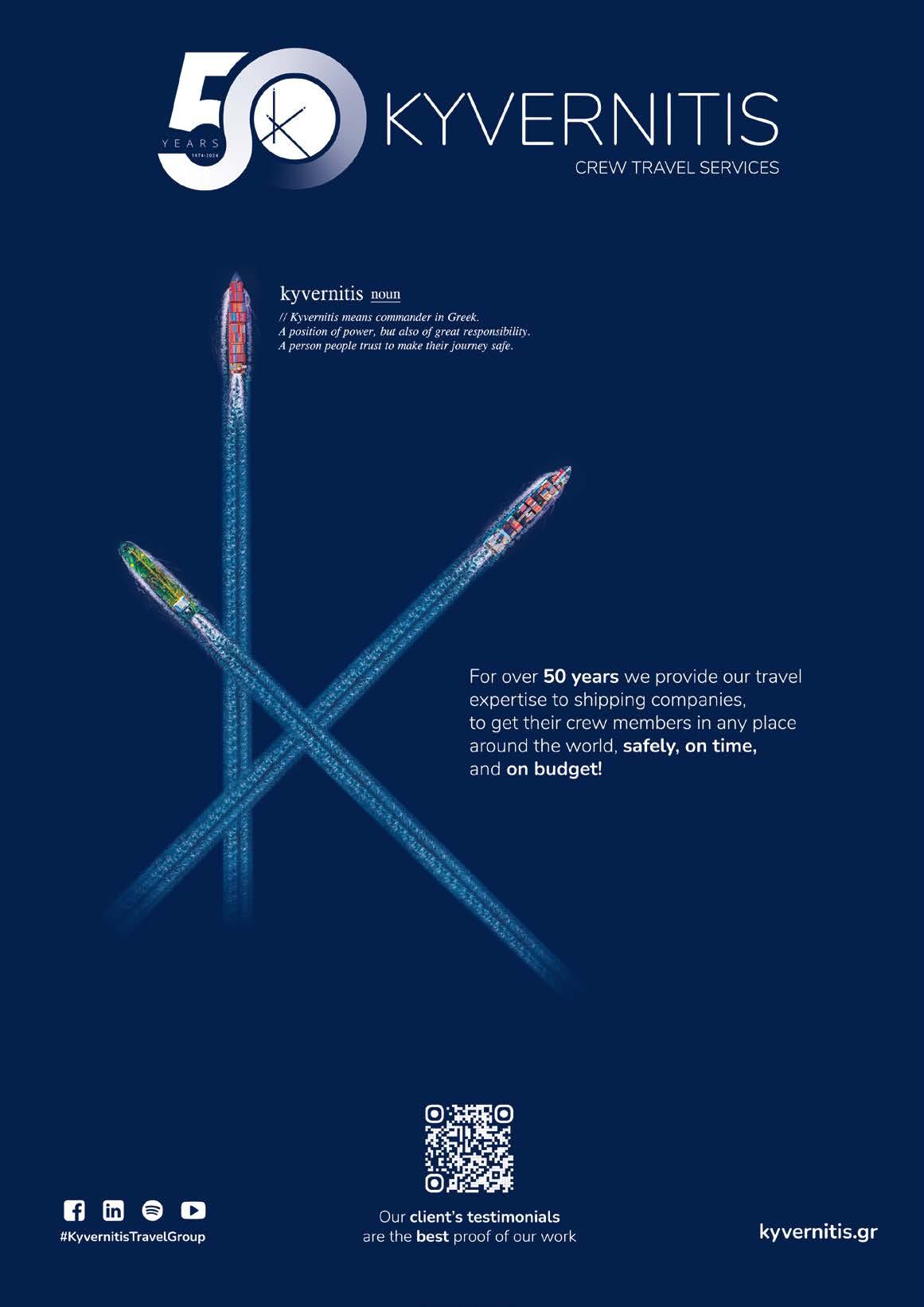

Bureau Veritas spearheads sustainable maritime solutions in Greece and Cyprus
 IBy Paillette Palaiologou, Vice President, Marine & Offshore Division SEEBA Zone, Bureau Veritas Group
IBy Paillette Palaiologou, Vice President, Marine & Offshore Division SEEBA Zone, Bureau Veritas Group
n the heart of the Mediterranean lies a region rich in maritime tradition and innovation: Greece and Cyprus. Through strategic partnerships and pioneering initiatives, Bureau Veritas (BV) is helping shape the future of shipping in the region, ensuring compliance with regulations while fostering environmental stewardship and operational efficiency. With a keen eye on the evolving challenges and opportunities facing the industry, BV is collaborating with key stakeholders across supply chains to drive decarbonisation efforts and shape a better maritime world.
One noteworthy endeavour exemplifying BV’s commitment to cutting-edge solutions that not only enhance operational efficiency but also reduce environmental impact, is the application of BV’s SMART notation to the fleet of ship management company Laskaridis Shipping. This notation recognises the high level of digitalisation deployed to enable the fleet to closely monitor and optimise operations, contributing to both business success and emissions reductions.
BV’s collaboration with Laskaridis doesn’t stop there. In a groundbreaking project, BV supports the pilot installation of a methanol-fuelled fuel cell on a bulk carrier. This initiative serves as a pioneering effort to explore the feasibility of utilising fuel cells on board vessels, as well as the safe handling of methanol as a fuel. Through rigorous testing and risk analysis, BV ensures the viability and safety of alternative fuel sources, paving the way for future advancements in sustainable propulsion systems.
Moreover, BV’s strategic partnerships also extend to industry giants like MSC Cargo. Several retrofit projects underway aim to optimise vessel efficiency when operating at lower speeds than they were designed for. By focusing on the radical derating of main engines, combined with
the replacement of turbochargers and propellers, BV has empowered MSC Cargo to enhance the performance of their vessels while reducing their environmental impact. These initiatives, carried out in cooperation with global technology leader Wärtsilä, demonstrate BV’s holistic approach to eco-friendly solutions, encompassing both operational and technological enhancements.
BV partnered with MSC Cargo once again to facilitate a retrofit project for the use of LNG and ammonia as alternative fuels on existing NeoPanamax containerships. By leveraging expertise from Wartsila and Wartsila Gas Solutions, BV and MSC Cargo are leading the charge in transitioning towards cleaner energy sources in maritime transportation.
Furthermore, Naftomar’s latest venture, supported by BV, marks another significant milestone in the region’s maritime landscape. The initiative involves the construction of four Very Large Gas Carriers (VLGCs) and Very Large Ammonia Carriers (VLACs), equipped with dual-fuel LPG capabilities. Their forward-thinking approach extends to a Joint Development Project with Hanwha Ocean, aimed at designing a fuel gas supply system compatible with ammonia for potential future retrofits. With these vessels poised to engage in the trade of green ammonia, this ambitious undertaking underscores the region’s commitment to embracing renewable energy sources and fostering sustainable growth within the maritime industry.
Bureau Veritas’s activity in Greece and Cyprus epitomises its commitment to advancing sustainable maritime solutions. Through validation, certification, and collaboration, BV ensures the integrity and safety of emerging fuels and technologies, thereby fostering trust and transparency along the supply chain. l
66 Ship Management International Issue 108 March/April 2024 Greece Report
Helping owners comply with emissions regulations

 By Theophanis Theophanous, Managing Director of BSM Greece
By Theophanis Theophanous, Managing Director of BSM Greece
On 1 January 2024, shipping officially joined the EU ETS (Emissions Trading System). With it emerged a comprehensive set of responsibilities, accompanied by significant financial implications for shipping companies.
Bernhard Schulte Shipmanagement (BSM) offers ship owners and oper-ators a wide range of services, from standard emissions reporting to in-depth management of the EU ETS obligations on behalf of the owner. This includes providing regulatory consulting, account creation and management, reviewing commercial agreements, trading, and EUA custody services.
Whether it is the EU ETS, CII (Carbon Intensity Indicator), or EEXI (Energy Efficiency Existing Ship Index), new regulations and measures aiming at minimising the shipping industry’s carbon emissions call for a more proactive approach towards managing carbon intensity while en-couraging data transparency. At BSM, our aim is to enable our crew, shipowners, and charterers to make data driven decisions for most effi-cient vessel operations that reduces their environmental impact and thus costs and comply with or even go beyond the requirements of in-ternational regulations. Through a holistic process of vessel performance monitoring, decarbon-isation management, data collection
and data analytics managed by our Fleet Performance Centre (FPC), we are helping our customers to optimise voyage efficiency, environmental sustainability and compli-ance while cutting OPEX, manual reporting and performance claims. Our team of experts uses smart technologies to continuously track and analyse carbon emissions. We identify patterns, trends, and inefficien-cies to develop data driven decarbonisation strategies and take correc-tive actions to reduce emissions. We also work with smart technologies and artificial intelligence to enhance the efficiency of energy manage-ment, emission monitoring and data analysis.
Decarbonising the shipping industry has long reached non-debatable status. Environmental regulations such as the EU ETS and the CII rating scheme are just the start. The European Commission’s ‘Fit for 55’ legis-lative package includes additional regulations, such as FuelEU, that are still being developed.
Meanwhile, the IMO is looking into market-based measures similar to those of the EU. Proposals have been submitted and are under review. For this reason, we continue improving our smart technologies to track and analyse carbon emissions. By doing so, we not only ensure compli-ance but also devise decarbonisation strategies aiming to lower both emissions and costs. l
67 Issue 108 March/April 2024 Ship Management International
Greece Report

Cyprus stresses its green credentials
The maritime community in Cyprus shares a close affinity with that of neighbouring Greece, both in terms of shared historical and social links as well as a strong ideological commitment to the decarbonisation goals of both the IMO and European Union - as befits two of the EU’s three largest shipping flags and Europe’s premier shipmanagement centre.
The importance of the shipping cluster was reinforced this year when the President of the Republic of Cyprus, Nikos Christodoulides, appointed two advisory committees to help the Shipping Deputy Ministry further “elevate the competitiveness of the Cyprus flag and the entire maritime cluster.” The move coincided with the 35th anniversary of the Cyprus Shipping Chamber (CSC), which remains an active participant in both IMO and EU shipping committees.
Announcing the committees, President Christodoulides stressed that “the entire shipping industry has embarked on a profound journey of change, defined by two transformative challenges – automation and decarbonisation. … To navigate this shift successfully, it is vital for the shipping industry to proactively embrace and incorporate these advancements into their fleets. This begins with optimising energy efficiency of existing vessels by incorporating innovative technological mechanisms and extends to the development and funding of

new innovative, state-of-the-art ships equipped with cuttingedge technologies.”
The Cyprus Shipping Deputy Ministry is doing its bit to support ship owners on the pathway to decarbonisation and incentivise the use of such technologies. As of January 2024, annual tonnage tax is being reduced by up to 30% for each vessel that demonstrates measures to reduce its environmental impact, ensuring shipowners are rewarded for their sustainable shipping efforts.
Cyprus-based ship owners and managers are certainly rising to the decarbonisation challenge. For example, Lemissoler Navigation under Chairman and CEO Philppos Philis – former President of both the CSC and of ECSA (European Community Shipowners’ Associations) - is collaborating with China’s SDARI (Shanghai Merchant Ship Design & Research Institute) and ABS on the design of the first methanol-fuelled ultramax bulk carriers to be built in China.
Mastermind Group under Capt. Eugen Adami - another former CSC President and prime mover behind the Adopt-A-Ship initiative to familiarise schoolchildren with shipping – has also ordered smaller, methanol-capable dual fuel bulkers of 43,000dwt.
In addition, Cyprus based-shipowner and alternative investment fund Pelagic Partners, together with Borealis Maritime, has just bought two 2021-built Platform Supply Vessels said to represent the best-in-class PSVs available in the market., both dual-fuel ships capable of operating on lower carbon LNG, as well as being ammonia-ready. The sister vessels are also fitted with hybrid battery power and shore poer connections. Pelagic was set up as an offshoot of Germany’s Hartmann Group, former owners of Limassol-based ship manager Intership Navigation - which in January was subject of a management buyout by long-term CEO Dieter Rohdenburg, also a Vice President of the CSC.
Meanwhile, a special event was held in Athens in early March to celebrate the 60th anniversary of the establishment of the Registry of Cyprus Ships – originally considered something of a ‘second register’ for Greek owners. In her speech, the Shipping Deputy Minister, Marina Hadjimanolis, referred to the
68 Ship Management International Issue 108 March/April 2024 Cyprus Report
Shipping Deputy Minister Marina Hadjimanolis

evolution of the Registry throughout the years and to the advantages of Cyprus as a flag state. The dinner saw a strong turnout among the shipowning community of Greece, reaffirming the long-standing and steady support to the Cyprus Ship Registry - as indicated by the island’s other shipowner body, the Cyprus Union of Shipowners (CUS), which unites Greek owners of Cyprus-flagged tonnage.
“Facing the global issue of decarbonisation, we are committed to contribute significantly by actively participating in several projects and exploring the potential of alternative fuels,” says Andreas Hadjipetrou, Managing Director of Columbia Shipmanagement (CSM). “We view our adherence to EU regulations not only as a legal obligation but also as a strategic alignment with a sustainable future.
“Regarding the European Union Emissions Trading System (EU ETS), we stand prepared to support our partners by providing the necessary monitoring, reporting, and verification of greenhouse gas emissions as mandated by the EU MRV regulation.”
Innovation is “a cornerstone” of CSM’s commitment, Hadjipetrou continues, as exemplified by its involvement in projects such as NH3CRAFT and BlueBARGE. NH3CRAFT aims to develop a safe and commercially viable technology for the onboard storage of ammonia as a marine fuel, while BlueBARGE focuses on designing an energy barge to supply electricity to ships, with a modular and scalable approach geared towards reducing emissions.
CSM is also actively participating in the European Union tender to develop largescale liquid hydrogen containment for shipping, he adds, as well als overseeing the construction of five Super B-Class vessels equipped to utilize multiple fuels including methanol, aligning with the highest automation and emission standards. “These vessels not only meet IMO regulations for emissions and sustainability,” he says, “but also exemplify our dedication to environmental protection.
CSM’s state-of-the-art Performance Optimisation Control Room (POCR) is fundamental to the way the shipmanagement company helps partner shipowners with their decarbonisation challenge.
“Meticulously adhering to ISO 9001 standards, and functioning 24/7, 365 days a year, the POCR stands at the forefront of leveraging advanced technologies to monitor vessels in real-time,” explains Hadjipetrou. “Strategically positioned across three key hubs - Cyprus, India, and the Philippines - POCR harnesses cutting-edge AI and machine learning technologies to optimise navigational, operational, and commercial performance. Through this integrated approach, it delivers a seamless solution for decarbonisation while enhancing the overall experience for all maritime stakeholders.
“By optimising every facet of maritime operations, POCR contributes significantly to reducing carbon emissions and advancing sustainable practices within the industry.”
As far as Greek shipping is concerned, that market is becoming “more and more integrated and absorbed within the larger global logistics and transportation network,’ the CSM MD observes, and Columbia is becoming increasingly involved, offering integrated maritime solutions. “Our Greek office is one of the fastest expanding of the Group,” he says, “and is emblematic for Columbia’s ambition to offer ‘second-party’ ship management.
“Greek owners can of course benefit from Columbia’s Performance Optimisation Control Room (POCR) which offers real-time 24/7 fleet monitoring, customisable performance alerts, and comprehensive monitoring for all aspects of vessel performance. The system is available on mobile platforms, providing users with fleet position, status, and technical data.
President of the Republic of Cyprus,


Andreas Hadjipetrou, MD, Columbia Shipmanagement and CCO, Columbia Group

70 Ship Management International Issue 108 March/April 2024 Cyprus Report
Nikos Christodoulides


“The POCR is an independent service accessible to any operator from anywhere in the world, regardless of prior relationships with Columbia Shipmanagement,” Hadjipetrou adds.
In fact, CSM’s POCR is now a member of the OneLink consolidated online platform, which brings together various vessel performance-related services in one place – including engine performance, bunker, lube oil, weather routing, emission data and more.
“By consolidating the software’s and services under one umbrella, Onelink helps shipowners and ship managers decarbonise their fleets by providing a single platform for managing navigational, operational, and commercial performance,” explains OneLink MD Capt. Pankaj Sharma (formerly CSM’s Group Director Digital Performance Optimisation). “This integration can lead to improved efficiency, reduced emissions, and better decision-making for fleet management.”
OneLink is fast growing its business in both Cyprus and Greece outside of Columbia, Sharma adds, including “a significant contract with a distinguished Greek client” secured this year. “I would like to emphasise how our innovative one-stop-shop solution OneLink enhances service delivery, catering effectively to clients of all sizes and keeping us competitive in the evolving global shipping market,” Sharma tells SMI. “Our focus on individual shipowners remains paramount, ensuring personalised service despite growth.”
On the question of whether a predilection for tramp shipping makes it harder for Greek owners to decarbonise operations, CSM’s Hadjipetrou points out that their adoption of more expensive alternative fuels “will only happen when these become available at major bunker hubs around the world”. In addition, once the carbon transport storage infrastructure is in place, he expects to see various carbon capture technologies becoming viable for vessels on certain routes.
“At Columbia we are here to support our clients with this costly and complicated transition,” Hadjipetrou concludes, “which we can help tailor to each and every vessel type, taking into consideration the trading pattern for individual vessels and in some cases fleets of vessels. Furthermore, we hold the advantage of a large pool of well-trained competent crew, which will be ready to handle these new fuels and technologies.”

Matrix Ship Management (MSM) is a leading maritime service provider specialising in comprehensive ship management solutions. The company’s activities encompass various services, including technical management, crew management, crew travel, and consultancy services for many types of vessels worldwide. With a focus on efficiency, safety, and sustainability, the company says it strives to deliver superior performance and add value to its clients.
Mike Dobson, Group Commercial Director, says the MSM is committed to supporting ship owners in their decarbonisation efforts through various means. “One example is our implementation of advanced monitoring and optimisation systems onboard vessels to improve fuel efficiency and reduce emissions. Additionally, we work closely with owners to explore alternative fuel options such as biofuels and retrofit vessels with energy-efficient technologies like scrubbers. Our proactive approach
to sustainability ensures that we continuously seek innovative solutions to minimise environmental impact while maximising operational efficiency.”
Matrix is also actively involved with the Cypriot Authorities to ensure compliance with the new EU ETS regulations affecting the shipping industry this year. “We are available to ship owners to guide them through this complex set of new requirements to the maritime industry,” says Dobson.
As regards the recent escalation of disruptive events in the shipping industry, such as the Russia-Ukraine conflict and Red Sea crisis, Dobson confirms that “this has indeed presented challenges for our business operations. Events like these have highlighted the importance of robust risk management strategies and contingency planning.
“We source a considerable number of Ukrainian crew for our managed vessels worldwide, and the severity of the logistical challenge the Russian invasion has impacted on these movements should not be understated.
However, he points out that “our extensive network and experience in the industry enable us to mitigate risks and provide timely solutions to unforeseen circumstances effectively.” Moreover, being a Cyprus-based company confers several advantages, he adds, including the island’s “strategic geographic location at the crossroads of Europe, Asia, and Africa, providing easy access to major shipping routes and markets. “Additionally, Cyprus boasts a favourable regulatory environment, with a well-established legal framework and supportive government policies for the maritime sector, he points out, and is renowned for its maritime expertise and infrastructure, including first-class registry and service providers.
One issue that Dobson says he would like to highlight is “the importance of collaboration and innovation in addressing the evolving challenges facing the shipping industry. As technology continues to advance and
73 Issue 108 March/April 2024 Ship Management International Cyprus Report
Mike Dobson


regulatory requirements evolve, it is imperative for stakeholders across the maritime ecosystem to work together to drive positive change and ensure the industry’s sustainability and resilience. At Matrix Ship Management, we are committed to fostering partnerships, embracing innovation, and leveraging digitalisation to enhance efficiency, safety, and environmental performance throughout the maritime value chain.”
“Connectivity is going to play a pivotal role in delivering the zero-carbon future that the shipping community is committed to achieving,” says Despina Panayiotou Theodosiou, CEO of Cyprus-based Tototheo Maritime. “We are actively addressing the challenges of decarbonisation through innovation, leveraging our advanced hybrid network solutions and specialized software platforms.
“For example, by integrating LEO and GEO satellite services with 4G/5G networks, we enhance data exchange efficiency, enabling real-time monitoring of vessel operations. This critical insight allows for operational optimisation, leading to reduced fuel consumption and supporting informed decision-making.
“Moreover, we have developed specialised platforms like TM Synergia, that offers a comprehensive suite for managing and reporting carbon emissions, compliant with EU ETS and CII. This simplifies the integration of environmental compliance into daily operations. Another specialised platform is PERSEUS, which aligns ports and vessels to achieve just-in-time operations, thereby reducing emissions from waiting times. The platform also provides situational awareness, facilitating speed adjustments.”
Use of real-time data and analytics to minimise emissions and therefore fuel costs not only provides Tototheo clients with operational efficiencies and avoids any penalties under emissions regulations, it also protects clients’ reputations on environmental matters, she adds, giving them “a competitive edge in a market that increasingly values green initiatives”.
In fact, Tototheo Maritime sees itself as more than “your average player in the world of maritime satellite services,”
the CEO continues. “We go beyond supporting ship operators, we actively manage every aspect of connectivity. We ensure that clients have uninterrupted data flow, and enable seamless communication, from the complex process of selecting the most reliable solutions to working with them for their continued security.
“A significant aspect for us involves the orchestration of networks, going beyond having hybrid systems onboard. We coordinate and manage diverse network resources and components to work seamlessly together. This is especially relevant in complex environments like on a ship. There is a pressing need to identify and allocate the right channels for the right services, and to proactively handle the demand for data.
Efficient orchestration of multiple networks onboard ships requires a holistic approach, one that acknowledges the unique challenges of maritime environments and it involves leveraging advanced technologies and robust cybersecurity measures to deliver connectivity that is both reliable and secure.
“At Tototheo Maritime, our commitment is to ensure that our clients can effectively navigate and capitalise on the opportunities presented by this dynamic communications environment,” the CEO concludes. “Our strategic approach aims not only to enhance safety, efficiency, and sustainability in maritime operations but also to position our clients for success in an increasingly digital and interconnected world.”
Insurance broker and risk manager Marsh Cyprus traces its presence on the island back to 1989 when HSBC set up an office there (as Gibbs Hartley Cooper) in reaction to the growing marine community on the island. That office experienced a constant growth and in 2010 HSBC Insurance Brokers was acquired by global group Marsh. Whilst the primary purpose of the office was to service the growing shipping community of the island, it quickly diversifed into the non-marine sector as well, primarily for risks that could not be absorbed by the local insurance market. The office currently employs 28 persons providing the full scope of risk management, advisory, broking and captive management services.
74 Ship Management International Issue 108 March/April 2024 Cyprus Report
Despina Panayiotou Theodosiou
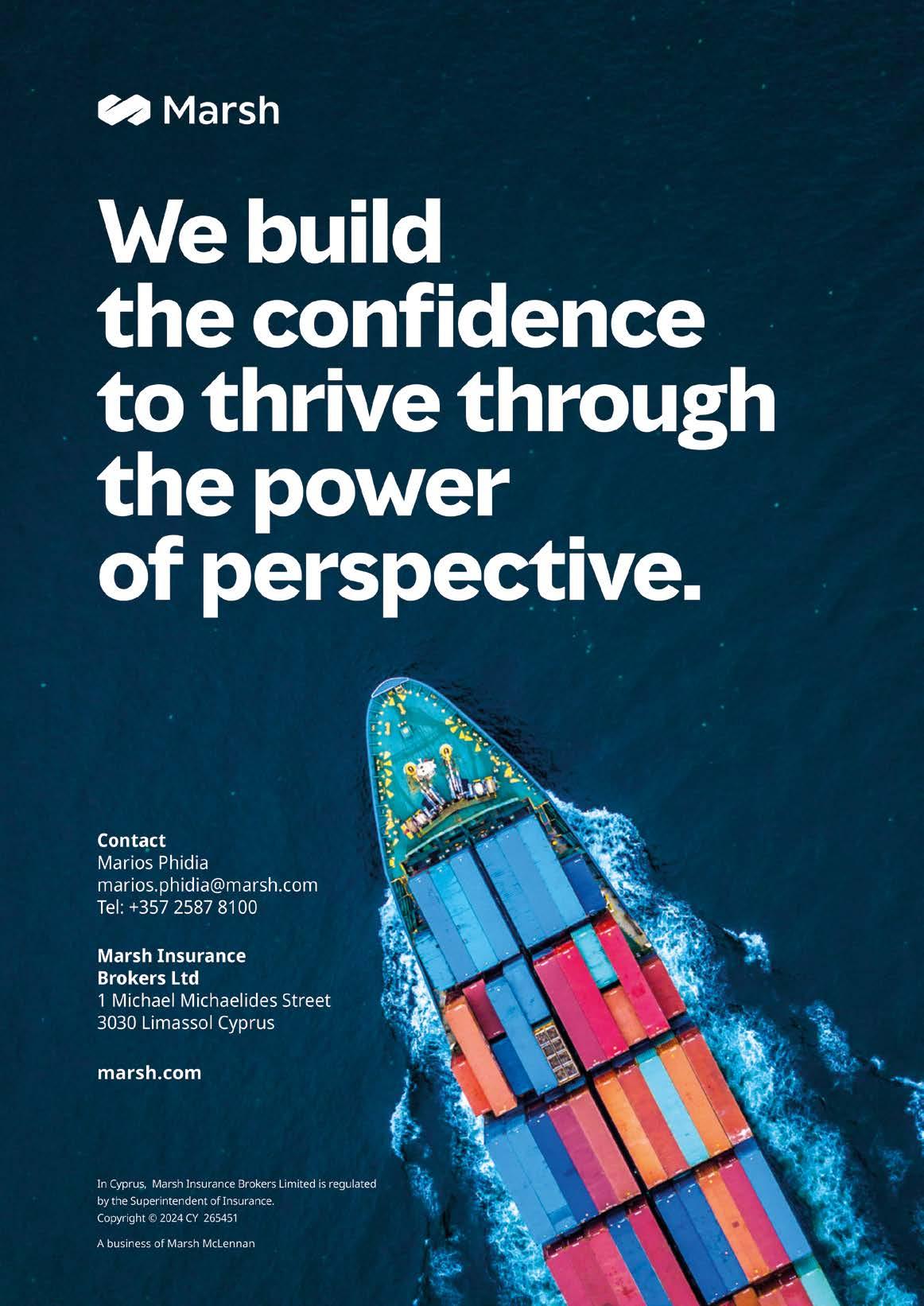
“The office in Cyprus has always been client orientated and being part of an insurance broking ‘giant’ has only helped to enhance our services to clients,” says Costas Joannides, CEO Marsh Cyprus. “We pride ourselves in providing a local service but with the full backing of a large organization. This greatly assists the level of service that we can provide to our clients that are always in the centre of what we do. There is absolutely no overlap in our organization as we have a very close cooperation between all the marine offices of Marsh globally.
“Additionally, we hold annual meetings between our European marine offices whereby collaboration is the main theme. This is where our clients tend to benefit most by enjoying a very personal and local service but with the muscle of the Marsh McLennan group.
Marsh Cyprus provides a full advisory service to its clients and this includes geopolitical and global supply chain disruptions. “Within Marsh we have a dedicated team and this is where we can thrive by providing such services to our clients,” says Joannides, adding that most of these can be without any additional charge.
This same team also advises on decarbonisation, he informs, “and we are being proactive with our clients in this very topical matter. We must also state here that the Cyprus shipping community is taking this very seriously and various seminars are being organised specifically for this matter.”
Management consulting firm KPMG is well-positioned to assist the shipping industry in “navigating the challenges and seizing the opportunities presented by decarbonisation regulation and initiatives across the supply chain, to create value for the organisation and enable the enterprise strategy”, says Sylvia A. Loizides, Board member & Head of Shipping at KPMG in Cyprus. “With the world increasingly embracing sustainability, the pressure mounts on shipping to adopt cleaner practices. KPMG can help companies address these challenges effectively while capitalizing on emerging opportunities.”
Central to KPMG’s support is the development of robust decarbonisation strategies. By conducting comprehensive

assessments of current operations and emissions profiles, KPMG aids companies in measuring their carbon footprint, setting ambitious targets, and analyzing decarbonisation scenarios across Scope 1, 2 and 3 emissions, and helps define achievable goals and charts pathways to realize them through diverse decarbonization initiatives.
Navigating the intricate regulatory landscape is another area where KPMG says it can help. “With regulations like the IMO’s greenhouse gas reduction targets and emissions trading schemes looming large, compliance while maintaining competitiveness becomes paramount. KPMG’s regulatory experts offer invaluable insights, guiding companies through adherence to regulations and identifying available incentives to bolster decarbonisation efforts.”
Beyond compliance, the company points out it can help shipping companies to leverage decarbonisation as a driver for innovation and competitive edge.“ Embracing sustainability fosters brand enhancement, attracts eco-conscious clientele, and unlocks new market opportunities,” it says, adding that it can “assist companies in identifying innovative business models, partnerships, and investment opportunities that align with their sustainability objectives.
“Furthermore, we can support shipping companies in enhancing transparency and accountability regarding their decarbonisation efforts. Through robust reporting frameworks and sustainability disclosures, companies can underscore their commitment to environmental stewardship to stakeholders. KPMG’s proficiency in sustainability reporting and ESG assurance can help companies develop credible and transparent communications that build trust and credibility with stakeholders.
“Overall, KPMG’s multidisciplinary approach, industry knowledge, and global reach make it an invaluable partner for shipping companies embarking on the decarbonisation journey. Whether navigating regulatory intricacies, driving innovation, or fostering transparency, KPMG stands as a steadfast partner in shaping a sustainable future for the shipping industry.” l


76 Ship Management International Issue 108 March/April 2024 Cyprus Report
Costas Joannides
Sylvia A. Loizides

Energy trades and ‘techno-stress’ feature at CMA Shipping 2024
The Connecticut Maritime Association (CMA) Shipping 2024 event was informally dubbed as a ‘Birthday Bash’ - celebrating 40 years since the organisation’s founding, and the 39th annual conference/ expo. Like any birthday celebration, there was a healthy dose of looking backwards, but - as shipping events are prone to do - also a great deal of peering into an always uncertain future.

The prestigious Commodore award went to Mike Tusiani (pictured), who built up the brokerage giant Poten & Partners into its 2024 status as undisputed brokerage and consultancy leader in the realm of LNG and other gas shipping trades. Looking back to when he first joined Poten in the early 1970s, he remembered the beginnings of both the LNG and LPG trades during his remarks in ‘the Commodore Debate’.
Half a century on, these cargoes loomed large in the conference discussions of the energy transition, with the IMO having now shifed its measurements of emissions towards ‘well to wake’ frameworks. Crude oil and refined products also dominated the conversations when it came to sanctions and even the Panama Canal’s restricted transits - where Asia’s urgent need for LPG shipments has led to payments of outsized monetary premiums for auction slots. The Red Sea crisis, complete with various maps showing vessel routings, was also a major discussion topic.
Looking towards the future, the concept of ‘techno-stress’- the uneasy interaction of seafarers with emerging technologies (for more efficient vessel operation, and for managing new fuels) found its way into multiple presentations. Former Commodores Lois Zabrocky (International Seaways) and John Hadjipateras (Dorian LPG), along with other two shipowners, also expressed their view that AI will play an increasing role in shipping’s future development... l
APM sets new record with highest attendance to date
The 18th Asia Pacific Maritime (APM), held from 13-15 March 2024, welcomed an unprecedented number of 15,717 attendees in Singapore. This figure surpassed attendance records of previous editions, signifying a positive revitalisation of Asia Pacific’s maritime sector and solidifying Singapore’s position as a leading maritime hub.
Held at the Marina Bay Sands, the event showcased an extensive range of 710 exhibitors and featured 150 industry speakers worldwide. This year’s theme, ‘Future of Vessels, Solutions for Tomorrow’, was a timely response to the industry’s pressing need for sustainable and innovative solutions.

“Participating in this edition was particularly humbling because I was able to meet many global exhibitors and speakers, all from diverse backgrounds,” said conference speaker Punit Oza, Founder, Maritime NXT & International Vice President, Institute of Chartered Shipbrokers. “What stood out to me was the urgent need for decarbonisation. The topic took centre stage at APM 2024, with leaders coming forward to discuss solutions that will drive the industry’s net-zero target.” l
78 Ship Management International Issue 108 March/April 2024
Ad Hoc
Cycling added to list of Posidonia sporting events
Interunity Group, a leading maritime services provider, has launched the first iteration of IG Cycling - THERMO2024, a new charity sporting challenge held across the Southern Pindos mountain range, Greece on June 1. The event takes place the week before the biennial Posidonia industry gathering in Athens, which already attracts sailing, soccer and running competition in its sidelines.

More than 100 riders will take part in the arduous cycle touring race over courses of 80km or 160km, reaching summits of around 1,400 metres, and with over 4,000 metres of climbing on the full route. The race will start and end in the village of Thermo, three hours from Athens.
The event was created in order to raise funds for two charities close to the hearts of the IG team: Elpida, supporting children with cancer and their families, and Common Seas, combatting plastic pollution in the oceans. l
Five lines and PSA Singapore ‘do good’ together
PSA Singapore recently joined forces with five major shipping lines – CMA CGM, Hapag Lloyd, HMM, ONE, and Yang Ming – to make the day of seniors from Lions Befrienders, one of PSA’s partner beneficiaries.
Held on 27 February, the half-day event was the first corporate social responsibility activity jointly organised by PSA’s Health@Home team with multiple shipping lines, demonstrating solidarity among industry partners for giving back to the local community.

A 120-strong group, comprising volunteers from the collaborating organisations and seniors from Lions Befrienders, gathered for an excursion to the River Wonders in Singapore, Asia’s first and only river-themed wildlife park, complete with a hearty buffet lunch.
“By combining our resources and expertise, we can make a significant impact in giving back to the community,” said PSA spokesperson Ong Chiew Suan, adding that PSA looks forward to more chances of working together on community projects with its shipping partners. l
Take to the heights with The Seafarers’ Charity
UK-based The Seafarers’ Charity invites intrepid entrants to join its challenge of conquering 24 peaks amidst the breathtaking UNESCO World Heritage site of England’s Lake District on July 6 – 7, 2024.
Covering a total of 33 miles with a remarkable ascent of 13,000 ft, The Seafarers’ Charity’s signature fundraising challenge event combines individual endurance with collaborative teamwork, participation supporting its mission to enhance the lives of seafarers.

The charity points out that for 18 years it has “taken teams to greater heights” in support of seafarers. This year, it is proud to introduce two new challenge options - Silver 21 Peaks, and Bronze 7 Peaks - aiming to foster inclusivity and cater to varying endurance levels. For further information, contact: events@theseafarerscharity.org l
79 Issue 108 March/April 2024 Ship Management International
Ad Hoc
Analysis Products tanker trade complex and dynamic
By Ian Cochran

Overall, global products tanker trade patterns remain complex and dynamic, Genoa-based shipbroker and consultancy Banchero Costa said in its March review of the sector.
This is probably something of an understatement given the increasing number of geopolitical events seen in the past couple of years.
Major products tanker owner and operator TORM, in a recent results presentation, agreed that the market was strongly impacted by geopolitical events last year.
The EU/G7 sanctions against Russian oil products officially took effect in February, 2023, which reinforced the trade shifts that had already begun the year before, ahead of the sanctions.
In early October, 2023, the conflict in the Middle East and subsequent attacks on vessels in the Red Sea forced many tankers to re-route via the Cape of Good Hope, adding to the tonne/mile
growth already seen from the sanctions against Russia.

In addition, recent restrictions on Panama Canal transits also resulted in longer sailing patterns, TORM said.
Global seaborne trade in clean refined products was estimated to have reached over 800 mill tonnes per year, according to Banchero Costa. The Asia/Pacific region accounted for over a third of the total, with China and South Korea leading the way. The US is the largest net exporter, especially to South America and Europe but exports were increasing to Asia.
New sanctions are reported to be affecting Russian trades and it will be soon even more difficult to find owners willing to lift Russian cargoes, even with a G7 crude price cap ($60 per barrel) and with the relevant due diligence, says Banchero Costa.
GASOLINE EXPORT BAN
Russia has announced a temporary ban on gasoline exports from 1st March to 31st August this year. According to Greek broker Intermodal, the ban was introduced to address concerns about potential domestic gasoline

Ship Management International Issue 108 March/April 2024

shortages and rising prices, plus forthcoming refinery maintenance periods.
Looking at the country’s exports, a significant shift in trade patterns was seen after Russia’s invasion of Ukraine.

In 2021/2022, the Netherlands and in particular, Amsterdam, was the top Russian gasoline importer. However, it was a different story last year, with the United Arab Emirates being the top destination, closely followed by Nigeria and other African countries. Nigeria is also leading the importer’s list thus far this year.
It is evident that West Africa will be affected by the ban, as it is also where the majority of Mediterranean and European exports end up.
Although the ban is seen as a temporary measure, its impact on global gasoline markets could be significant. It remains to be seen whether alternative sources can adequately compensate for the loss of these cargoes, Intermodal said.
Europe mainly exports gasoline to West Africa and the US. However, the Russian ban coincides with Europe’s refinery maintenance season, which typically occurs in the second quarter of each year before the peak summer demand season.
Overall, Russia’s actions highlighted the complexity and dynamics at play in the global gasoline market, where supply management and price considerations are key factors for major producers, Intermodal said.
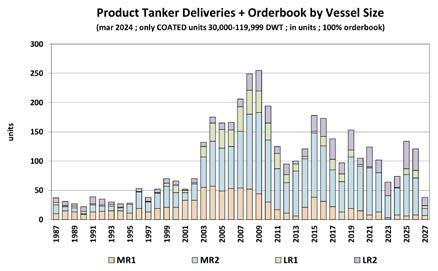
Gibson Shipbrokers pointed out that with new refinery capacity coming into play in the Middle East and Asia, a shift in cargo flows could be seen as a result.
Gibson said that refining margins across the world surged to record levels in 2022, following Russia’s invasion of Ukraine.
Although margins have declined since, they have generally remained healthy, even in Europe, where the structural shortage of middle distillates prevailed over the competitive disadvantage of relatively simple and ageing refineries, compared to large and sophisticated plants in the Middle East and Asia.
However, the European refining sector will again face challenges. For example, according to the IEA, Middle East refining throughput is anticipated to increase by 650,000 barrels per day this year, due to the recently commissioned facilities.
These include Kuwait’s 615,000 barrels per day Al Zour plant, which reached full operational status earlier this year, whilst the 230,000 barrels per day Omani Duqm refinery was also formally inaugurated in early February, with product exports starting in September last year. Bahrain’s Sitra refinery expansion project is also expected to increase regional runs later this year, Gibson said.
FLEET ANALYSIS
According to Banchero Costa’s analysis, last year net fleet growth of coated tankers (between 30,000 - 120,000 DWT) was 2.2% year-on-year This pattern is expected to continue at around 1.7% this year and then growing by about 3% in 2025 y-o-y.
Examining the different types, LR2 (82,000120,000 DWT) growth was 5.5% y-o-y last year, which is expected to continue at around 3.5% in 2024 and then at about 8.6% in 2025.
LR1’s (60,000 – 81,999 DWT) net fleet growth in 2023 was static, while it is expected to shrink slightly by 0.2% in 2024, before growing again by around 1.3% in 2025 y-o-y.
As for the MR2 (43,000 – 59,999 DWT) fleet, this sector grew by 2% in 2023 and the growth is expected to continue at around 1.9% in 2024 and then at about 3% in 2025, while the MR1 (30,000 – 42,999 DWT) fleet saw a drop of 0.3% y-o-y last year, which is expected to continue at around minus 0.4% this year and then fall by around 1.3% in 2025. l
Analysis
Alternative Viewpoint
Seafarers collateral damage once again
By Michael Grey, MBE, is an internationally respected maritime commentator
There have been plenty of expressions of outrage at the Houthi’s attacks upon shipping in the Red Sea and Gulf, increasing in volume in March, with the first deaths and injuries aboard the bulker True Confidence. Ministers, secretary-generals, trade union and industry leaders have spoken of their anger and disappointment at this reappearance of mechanised piracy on the high seas, and their sympathy for the dead and injured.
Sadly, it might be suggested that “fine words butter no parsnips” and do nothing to remedy the situation, with the rebel Yemeni forces clearly improving their strike rate. Significantly, only the US and UK have shown any signs of taking the fight to the enemy and doing anything more than defending merchant ships and themselves, when they come under attack.
Diplomatic caution and geo-politics being what they are, any more muscular response from those with warships in the area is unlikely to be forthcoming. Principle, some say, has limitations in these dangerous times and it is difficult and probably pointless to sanction a failed state. Its inhabitants, who appear to rejoice at the attacks upon passing ships, have little enough to lose.
Seafarers, who certainly did not take up their career to function as targets for armed militants, will continue to fear death and injury in what should have been a routine voyage. The fact that a war risk bonus might be paid, and they have a legal option (quite how effective this might be under some flags and owners remains to be seen) to decline a berth aboard ships transiting these vital but hazardous routes, does not mitigate the fear that the drone or missile has your name on it. You may be paid a bit more, but still end up dead or injured, while the fear, and that of your nearest and dearest, will not go away.
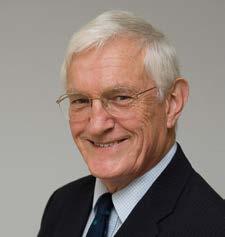
There are now threats that the Houthi rebels will extend their hostilities to vessels which are taking diversionary routes around Africa. It has yet to be determined whether pirate activity from the coast of Somalia is connected to the Houthis, or local opportunists attempting to profit from the regional instability.
In their recently published book “Conflict – the evolution of warfare from 1945 to Ukraine” General David Petraeus and historian Andrew Roberts describe what has become known as asymmetric or hybrid warfare in which a weaker state can inflict substantial damage on a more powerful opponent, without provoking the full weight of retribution. Thus, Iran’s sponsorship of their proxies in Yemen can be provided, while maintaining “an air of deniability.” There are no signs that this strategy can be in any way dissuaded, without escalating the regional conflicts, so if the ships are to be put into harm’s way, the only solution remains one of defence, after the drones and missiles are on their way.
And there is precious little comfort in that for a merchant mariner aboard a ship whose operator has decided to take the risk of a Red Sea transit and pay the additional premia. It now seems almost academic as to whether the ship is one with an Israeli, US or UK connection as the Houthis says they are targetting, or whether it belongs to China or Russia, countries that have supposedly negotiated immunity for their vessels with the Houthis.
Unless there is a sudden outbreak of peace in and around Gaza, the seafarers, collateral in hostilities in which they mostly have no part, will continue to operate the ships upon which the world depends. They are about the only things that can be depended upon, in this dangerous time. l
82 Ship Management International Issue 108 March/April 2024
Technical Building for a new era in cable laying
Wind
farms in deeper waters and projects for international subsea power connections are driving the rapid development of the cable ship fleet, as David Tinsley reports.
Spurred by accelerating demand in the offshore renewables and interconnector markets, the past 12 months have seen a raft of contracts for the construction of large, purpose-built cable-laying ships.
Such is the capital intensity and technological complexity of the modern-day cable-layer, which must ensure high levels of operability, productivity and precision in often environmentally challenging conditions, that newbuild projects remain the province of niche players. Current fleet investments are divided between cable manufacturers who also undertake installation, and specialist offshore and subsea companies, a number of which have roots and major interests in the dredging sector.
Offshore wind farm developments are centre stage in stimulating the advance of the cableship fleet, in capacity, capability and technology. The project requirement in each

case is two-fold, entailing the putting down of cable arrays linking wind turbines to offshore substations, and the laying of high-voltage export cables connecting the substations to the onshore network.
The wind energy industry’s progression into areas further offshore and in deeper waters, and the prospective drive into new regions around the world, influence the design, wherewithal and performance of new-generation cable-layers.
The underwater infrastructure in Europe, moreover, is also gaining greater dimension through schemes to connect power networks in different countries, so as to better ensure system robustness by providing for energy flows in either direction. Highly capable cable-layers are pivotal to the establishment of submarine interconnectors, and to the long-term upkeep of such increasingly vital elements in national energy planning.
83 Issue 108 March/April 2024 Ship Management International
Nexans order for an advanced cable-layer from Norway followed major power cable supply and installation contract awards in Europe (credit: Skipsteknisk)
Ever-larger carousels featuring in current and planned newbuilds attest to the longer cable distances and heavier cables entailed in many such projects.
Milan-headquartered Prysmian Group has ordered two high-capacity cable-laying ships in recent months. The company’s latest stage of fleet development involves distinct classes of vessel and represents an overall capital expenditure of EUR350 million ($380 million). One of the ships will be a 190-metre evolution of the deepwater Monna Lisa(sic) type presently under construction by Norwegian international shipbuilder VARD, and the other project, entrusted to an unnamed shipyard, entails a vessel of approximately 167 x 40 metres intended for shallow water operations.
The latest deepwater newbuild, incorporating the VARD 19-8 design, will be fitted with three carousels able to hold a total 19,000t of cable. As well as offering one of the highest loading capacities in the market, beneficial to factory-to-site logistics and overall project efficiency, the vessel will be equipped to allow simultaneous laying and burial of up to four cables, using a variety of ploughs.
Rated to the DP3 standard of dynamic positioning and engineered for a bollard pull in excess of 180t, the vessel will be the third in a series of Prysmian newbuilds from VARD and is expected to make her debut at the start of 2027. The contractual association began with the 170-metre Leonardo da Vinci, completed in 2021 and placed under the husbandry of Monaco-based Sea World Management. The vessel features 17,000t of carousel capacity and a diesel-electric power and propulsion system using three Azipod main propulsion units. The second in the series, the nascent Monna Lisa (sic) is due in early 2025 and, as with her predecessor, will be able to work to depths of 3,000m and more.
The newly booked shallow-water cable-layer will employ an eight-point mooring configuration to better ensure continuity of laying and burial in challenging environmental conditions.
French telecoms and power cable maker Nexans implemented a further stage of in-house fleet development last autumn by contracting a 150-metre cable-layer from Norwegian builder Ulstein Verft.
Specified with three turntables conferring a load capacity of approximately 14,000t and hosting a large range of subsea equipment, including jetting and ploughing tools, the vessel will be a derivation of the technologically acclaimed Nexans Aurora, completed by Ulstein in 2021. The DP3 newbuild will take the concept further and will have the means of laying up to four cables simultaneously, pertinent to large-scale, timecritical schemes. She will also achieve new environmental objectives through the nomination of a hybrid power system and machinery able to run on a bio-diesel mix.
The prospective 2026 fleet entrant, designed by Aalesund consultancy Skipsteknisk, will be assigned to Nexans Marine Operations of Oslo and will carry out cable installation, repair and recovery. The ship’s multi-genset, diesel-electric plant will be supplemented by a battery pack to provide a peak-shaving function and spinning reserve.
The commitment to fleet expansion follows two major contract wins for Nexans. A EUR1.7 billion ($1.85 billion) deal with TenneT of the Netherlands to connect three wind farms in the German Bight with the German mainland, using subsea cable manufactured at the group’s Halden production centre in Norway, was followed by a southern European interconnector assignment. The latter, EUR1.43 billion ($1.55 billion) award embraces the Greece-Cyprus section of the EuroAsia Interconnector, involving some of the longest and deepest high-voltage DC(HVDC) submarine electric cables to date.
On the back of a record order backlog and strong market outlook, Danish cable maker NKT announced investments last year in a new factory at its Swedish manufacturing complex and construction of a sophisticated cable-layer worth between EUR200 and 250 million ($217-271 million). The newbuild is
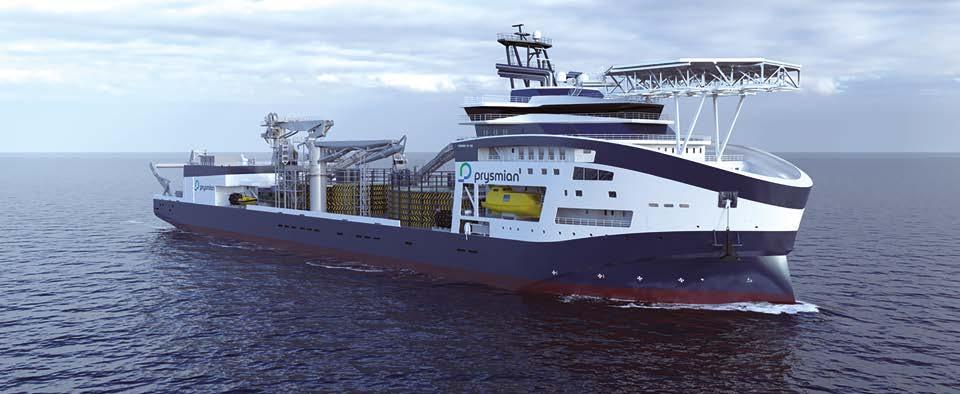
84 Ship Management International Issue 108 March/April 2024 Technical
Prysmian has booked a third high-capacity cable-layer from the VARD Group. (credit: VARD)
to be delivered from one of VARD’s Norwegian yards towards the end of 2026 and will be specialised in the handling of HV cable. The ship will be constructed in parallel with NKT’s expansion of its site at Karlskrona, Sweden, entailing the creation of new HV cable production lines, and both assets are expected to be operational from 2027.
Developed by Norwegian consultancy Salt Ship Design, the vessel will work alongside the 140-metre NKT Victoria to connect offshore wind farms to the land as part of a project led by Dutch-German transmission system operator TenneT.
The DP3-capable NKT Victoria, dating from 2017, is husbanded by Remoy Management of Fosnavaag, on Norway’s west coast.
Belgian international construction and dredging group Jan De Nul has ordered an exceptionally high-capacity cable-laying vessel which will also be distinguished by the capability to run on methanol fuel. With an unrivalled, maximum load intake of 28,000t, the cableship is to be delivered under the name Fleeming Jenkin from China Merchants Heavy Industry (CMHI) Haimen yard in 2026.
The vessel will have the means to lay up to five cables simultaneously, deploying heavier and longer cables in depths to 3,000 metres. She will be arranged with three cable carousels plus a hold for fibre optic cable, complemented by three 50t tensioners and cable-laying wheel integrated into the stern chute, plus 100t and 30t offshore cranes. An aft deck chute will facilitate cable laying in shallow waters, while the wheel will make for efficient working at greater depths.
Jan De Nul has looked to homegrown marine engine technology to power the new, 215-metre behemoth. The complete shipset of five engines that will drive the 30,600kW primary genset installation, feeding electrical energy to the propulsion units and
Jan De Nul’s Fleeming Jenkin cable-layer newbuild in China will offer an as-yet-unrivalled load intake of 28,000t.
(credit: Jan De Nul)

manoeuvring thrusters, will be from Ghent manufacturer Anglo Belgian Corporation (ABC).
The medium-speed engine outfit will enable firing on methanol, bio diesel or hydrotreated vegetable oil(HVO) as well as diesel oil, and will incorporate emission-abating selective catalytic reduction(SCR) and diesel particulate filter(DPF) systems. Operation on ‘green’ methanol, for example, will achieve compliance with the most rigorous particulate matter( PM) standard under Euro Stage V regulations and Euro 6 nitrogen emission criteria.
The machinery package is based on four 12-cylinder models of the DV36MeOH type from ABC, plus an eight-cylinder unit of the DZDMeOH series released in 2023. The genset aggregates will be supplemented by a 2.5MWh-rated battery installation.
While the Jan De Nul project signifies a prestigious win for Chinese shipbuilding, European mettle in the high added-value stakes recently received a fillip by way of a cableship contract from Japan. In a transaction worth more than $200 million, the VARD Group is to supply Toyo Construction with a 150-metre cable-layer and wind farm construction vessel.
In addition to a 9,000t carousel capacity and the wherewithal for deploying subsea DC power transmission lines, the newbuild will feature a large open deck area and 250t heave-compensated crane. The specification will confer a multipurpose capability, embracing tasks such as ground-based foundation work and floating offshore wind turbine mooring. The VARD design
provides for inter-array, HVAC export and interconnector cable lay, cable burial and construction duties, and incorporates a fourpoint mooring arrangement for shallow-sea assignments. The hull will be built at VARD’s Tulcea yard in Romania and transferred to Norway for outfitting and completion by mid-2026.
Meanwhile, plans for what would be the largest cable-layer to date hang on the go-head for the creation of a new, HV cable production plant in Scotland. The UK company behind the intertwined schemes, XLCC, has reached the point of having obtained planning permission for the proposed cabling factory at Hunterston, on the Firth Clyde. XLCC is backed by many of the investors in XLinks, which is seeking to import solar and wind power from Morocco to Britain via a 2,360-mile undersea cable.
XLCC retained Salt Ship Design for conceptual planning of the cable-laying vessel, and has also worked closely with SeaTec, the technical services division of shipmanagement organisation V.Group. Model testing was conducted in the Netherlands last year. Given the scale of the XLinks project, and potential other, future interconnectors, the ship would have a very substantial cable carousel storage capacity, understood to be as much as 24,000t.
Industry projections in 2023 indicated that global 2030 subsea cable demand could considerably outstrip manufacturing and cablelaying fleet capacity, causing a bottleneck in realising energy transition objectives. l
85 Issue 108 March/April 2024 Ship Management International Technical
Lubes Lube oils: shipping’s secret weapon when it comes to decarbonisation
By Gianluca Marucci, Castrol Global Marine and Energy Technical Services Director
The global marine industry has a unique challenge: balancing the growing seaborne trade which is critical for the global economy, while simultaneously putting in measures aimed at decarbonising its operations. The marine sector will gradually transition to new fuels. Yet, there is a risk of overlooking one aspect that will be important to the utilisation of new fuels: the lubricant. Marine lubrication will be integral for the effective and safe use of clean fuels.
Marine lubrication is indispensable for engines, and any flaw in the lubrication can be fatal for the engine. Ask any seasoned engineer, and they will highlight that using the wrong lubricant can pose a range of issues from deposits and corrosion to overheating. Lubrication failure has been the number one cause of a ship’s engine failure, with the average claim cost being approximately $560,000.
Previously, the industry assessed lubricant performance based on its base number (BN). However, as the industry explores different fuel types and in line with this, looks for new attributes and qualities in engine fluids, choosing the right lubricant has become more complex. The wrong lubricant with the wrong fuel could cause significant engine damage, resulting in downtime, loss of earnings, repair costs, and risking seafarers’ lives.
With changing regulations, engines becoming more complex, and new fuels, marine lubricants will cement their importance in the shipping industry. With the introduction of new fuel types and the need to adapt lubricants in line with this, the monitoring of lubricant performance will grow

in importance. On an ongoing basis, engineers will need to use tools such as used-oil analysis data, test kits and expert condition monitoring advice to keep watch for any issues. With deep knowledge of lubricant and equipment interaction necessary, shipowners need close collaboration to keep their operations in sync with the latest OEM recommendations and environmental legislation.
Condition monitoring technology is a key tool to help support the skills and talent of the crew by bolstering human expertise and experience with smart, digital solutions. Realtime smart monitor analysis can identify issues early, helping owners and operators to make informed decisions and take preventive action before any major damage occurs.
Lubricant suppliers will emerge as consultants, using their products, digital tools, and human expertise to give early warning to operators when issues arise. Empowering operators with easily accessible information for an accurate real-time picture of the system’s state, which is especially vital as the industry explores new fuels and forms of propulsion.
As the marine industry continues to evolve, lubricant providers must continue to offer more holistic solutions that can bridge the gap to unlock the use of potential new fuels. The bottom line is, that if the fuel is considered a ship’s energy source, the lubricant can be considered its blood, giving vital information about engine health and performance. Lubricants should be viewed as a facilitator of change, that enables progression and that are playing a key role in the industry’s decarbonisation journey. l

Ship Management International Issue 108 March/April 2024
Test results for future fuels
Dr Olivier Denizart, Technical Manager at Lubmarine, shares some key findings of his company’s latest R&D projects on ammonia and methanol
Along with methanol, ammonia has been recognized as a viable fuel solution, one that, whilst offering opportunities towards GHG reduction targets, also poses key challenges from the perspectives of safety (both environmental and human) and practicality. Providing good combustion in a dual fuel engine, another advantage to shipping is that ammonia should face less competition with other areas of the transport sector – unlike some of the other fuel alternatives being considered.
Ammonia storage already exists in 120 ports globally, enabling both ship to shore and ship to ship bunkering solutions alongside reasonable liquefaction temperatures. But it is far from plain sailing when it comes to ammonia with significant challenges around its volumetric energy density and of course its deadly toxicity and the need for stringent safety solutions.
At the same time OEMs are developing NH3 engines with MAN ES and WinGD anticipating it will launch a two-stroke ammonia-fuelled engine in 2024.
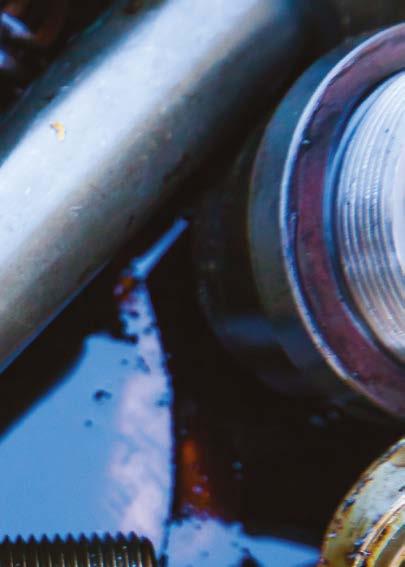
It’s a fuel solution we are actively researching here at Lubmarine, with our R&D teams having redesigned a 1.5 litre passenger car diesel engine to run on ammonia enabling us to run our own in-house tests to better understand the impact that ammonia will have on engines and specifically for us, the impact, and challenges for effective engine lubrication.
With any new fuel, we must understand the interactions and impacts of the relationship between lubricant, fuel, and engine to ensure that our lubricants are delivering the desired performance and, through lifecycle assessments, be assured that there will be no carbon generation.
It’s a methodology that starts in our labs with our ammonia engine oil development project.
From an initial perspective, we wanted to show that NH3 (ammonia) can interact with lubricant chemistry so our challenge is to fully understand its operating behaviours to enable us to adapt lubricant formulations to meet specific needs.
When it comes to lab testing, our key objective is to develop an engine oil technology that allows reliable, clean, and efficient use in Ammonia-fuelled internal combustion engines.
To meet these objectives, we need to: observe lubrification challenges in a real engine environment - deposits, wear, corrosion, oil ageing; evaluate sensitivity to engine oil composition; and calibrate laboratory test severity.
Our challenge is to understand the impact that NH3 has on oil components and their performances, the availability of NH3 ICE tests (performance, endurance), access to large engine prototypes and our need to run and understand evaluation test results.

Key observation and assessment areas when we are running ammonia engine tests include: ammonia dilution, nitro-oxidation, corrosion, cylinder wall degreasing, water handling, deposit control and material/elastomer compatibility.
Testing protocols look at three specific areas: oil formulation – including base oils and additives; NH3 alteration tests – influence of temperature and crankcase gases composition; and performance evaluation.
This year will be a very key one for us here at Lubmarine with regarding to lubrication development to reflect new fuels. Thanks to our R&D and OEM‘s partnership we’ll start lubricating tug boats using an Ammonia-fuelled 4-stroke engine this year.
On the methanol side, we are starting trails with Methanol 2-stroke commercial engines. From our lab test results to date we have been able to analyse the oxidation and main characteristics of our lubricants where they have been adapted to methanolfuelled engines.
What we have been able to do is widen our testing to incorporate actual field tests on these new engines which is providing invaluable data from which we are able to evaluate, implement and apply to further tests to support product development. l
87 Issue 108 March/April 2024 Ship Management International Lubes
Innovation

Digital adoption requires a customercentric approach

“In our experience, working closely with customers for a smooth transition and adoption of technology is key, especially considering the critical role | of their existing processes, systems, and data,” says Richard Buckley, CEO & Founder of 90POE.
Nearly 90% of global trade is transported by sea, underscoring the shipping industry’s pivotal role in our interconnected world.
The industry’s evolution marks an important convergence of technical and financial innovations, significantly reducing costs and enhancing the reliability of long-distance trade.
Today, as digital transformation becomes imperative, we look at the drivers toward the adoption of digital technology and share our experience at 90POE in supporting customers with the integration of technology into their maritime operations.
ADOPTING DIGITAL TECHNOLOGY IN DAY-TO-DAY TASKS
Over the past decade, there has been a significant increase in the number of digital solutions for the maritime industry.
Recognising the limitations of traditional Enterprise Resource Planning (ERP) systems and with the need to move operations online during the COVID-19 pandemic,
ship owners, operators and managers are continuing to explore the benefits of digitalisation across operations.
The focus is on platforms which provide comprehensive functionality for all areas of ship management, both commercially and operationally.
Richard Buckley, Founder and CEO of 90POE, explains: “Adopting digital technology is more than having new tools.
“It involves a paradigm shift in process and decisionmaking, powered by new technological insights. At 90POE, our mission is to ensure these innovations not only integrate but significantly enhance maritime operations to drive safety, sustainability, and profit.”
DIGITALISING MARITIME OPERATIONS: THE DRIVERS FOR CHANGE
The drivers for the adoption of digital technology have been well documented over the last few years, as have the multiple benefits associated with this.
Recently, with the roll out of increasing regulations around industry emissions, including the IMO’s Energy
88 Ship Management International Issue 108 March/April 2024

Efficiency Existing Ship Index (EEXI), Carbon Intensity Indicator (CII) and European Union Emissions Trading System (EU ETS), we have once again seen the value of digitalisation promoted to stakeholders who are actively looking for ways to manage their fleet’s emissions.
Richard elaborates: “As the maritime industry faces tighter emissions standards alongside rising fuel costs, there’s a growing recognition of digitalisation’s critical role.
“Ship owners, operators, and managers are now prioritising digital solutions that offer real-time monitoring and management of fleet emissions and consumption.
“This shift is not just about cost reduction and compliance–it’s a strategic move to avoid penalties and align with the industry’s ambitious decarbonisation targets for 2050.”
SUPPORTING THE ADOPTION OF DIGITAL TECHNOLOGY
Navigating the digital landscape in the maritime industry requires a balanced approach.
While advancements offer exciting possibilities, ship owners, operators and managers remain grounded in practicality. Their decisions regarding digital adoption hinge on addressing real challenges, ensuring costeffectiveness, and delivering tangible value.
Richard explains: “Professionals within shipping companies are not merely attracted to the ‘new and shiny’, their decisions hinge on practicality, cost-effectiveness, and true value.
“This discerning approach, focused on addressing real challenges and the adage ‘if it isn’t broke, don’t fix it,’ serves as a fundamental principle in their technology adoption strategy.
“The emphasis is on the fact that technologies form the backbone of ship owners/operators’ businesses and is crucial.
“While traditional ERPs might lack in certain areas like smart insights or analytics, their core functionality is designed to handle vital business transactions.”
However, the true potential of digital technology lies in its ability to transcend individual systems and connect across the entire operational workflow. This breaks down data silos and streamlines communication.
“Going beyond standalone systems unlocks a real opportunity to enhance operational and commercial execution and compliance,” explains Richard.
“Our approach is pragmatic, focusing on those challenges and ensuring the technology we advocate for is fundamentally value-adding.
“Beyond replacing traditional ERPs, we aim to bridge operational workflows, enhancing both operational and commercial execution.”
THE CUSTOMER JOURNEY – THE 90POE CUSTOMER CENTRIC APPROACH
Building strong customer relationships is an integral component to the successful adoption of digital technology such as 90POE’s OpenOcean STUDIO.
By breaking down barriers and establishing trust we can see significant changes in the way our customers work, and this ensures real value is gained from using our technology.
“At the heart of 90POE’s philosophy is a strong commitment to customer relationships. Through close collaboration, we ensure our technology delivers tangible benefits, aligning closely with each client’s unique needs.
“The maritime industry’s digital transformation is not just about keeping pace, it’s about leading with innovation and sustainability.
“Our customer-centric approach ensures that we’re not just providing solutions but actively redefining maritime operations together with our clients.
“By understanding their challenges and aligning our technology with their goals, we’re not just implementing systems; we’re enabling a future where digital adoption is synonymous with operational excellence and sustainability,” concludes Richard. l
89 Issue 108 March/April 2024 Ship Management International
Innovation
Innovation & regulation: which is driving which?

The maritime industry has traditionally innovated as a consequence of regulation or as response to existential economic challenges. Reactive innovation is ingrained in the nature of the industry.
Since the early 1900s, the relationship between innovation and regulation has largely been one where an incident triggered some form of regulation, the implementation of which then triggered innovative re-sponses to aid compliance.
However, in parallel, more recently and perhaps more subtly, we are also seeing an increasing rush of potentially disruptive technologies which are breaking the traditional ‘reactionary model’ of innovation. This has a consequence of unleashing an era where innovation is moving faster than the regulation; we are at the cusp of the industry seeing innovation triggering regulation.
Examples of this kind of reversal are already being seen in the sphere for 3D printed spare parts, drone operations for vessel inspection and deliveries, and most particularly in the space of vessel autonomy.
That is why maritime regulators need to create safe spaces for innovators to work collaboratively with the regulators themselves. This also means in this new era of innovation nobody can
 By Nakul Malhotra, Vice President, Emerging Opportunities, Wilhelmsen
By Nakul Malhotra, Vice President, Emerging Opportunities, Wilhelmsen
prescriptively and statically assume the framework of regulation in isolation of the technological developments. This is a massive change from the earlier model where regulations decided the pace and extent of innovation and they stayed stagnant for decades.
Geographies that are able to ‘flatten’ regulatory bodies and enhance access for innovators to policy makers and for policy makers to innovators, to help understand and experience innovative solutions and technologies along with associated consequences, will leapfrog towards sustainable and meaningful developments for their geographies. Establishing clear visions and priorities, providing catalytic incentives, driving thriving ecosystems that aid funding, legal cover, operational test beds and, most importantly, a trust foundation to develop will fast track the trial of technologies.
This will also aid the learning from failures of new solutions to help frame nimble regulatory frameworks to not only supercharge the developments needed but also manage them to prioritise safety, security, and economic activity when and where they are needed most.
Overall, innovation is playing a key role in shaping the future of the maritime economy, by responding to regulatory imperatives AND using the learning of the development of new
technologies and practices they can drive policies that help the industry transition and embrace the future it deserves. This can only be done at the pace required and to the benefit of all stakeholders if a symbiotic environment between innovators and regulators embedded in wide ecosystems are nurtured that allow for regulations to constructively absorb innovations.
The nurturing of this symbiotic environment cannot be left to chance. Rather, continuous conversations among global ecosystem experts need to be facilitated by industry-wide conferences. Personally, I was speaking alongside maritime experts at the biannual Asia Pacific Maritime, with 2024’s edition covering the impact of innovation on policies and regulation, as well as technical and commercial developments.
The so-called ‘regulatory sandboxes’ or progressive ‘centres for pilot solutions’ will differentiate the leaders from the laggards and establish some degree of regulatory arbitrage which in turn will likely fuel capital and talent flows and therefore catalyse developments that answer what the future looks like. That first mover advantage has been the genesis of some of the biggest innovation centres in other industries and will likely be the same in the maritime industry as well. l
90 Ship Management International Issue 108 March/April 2024 Innovation
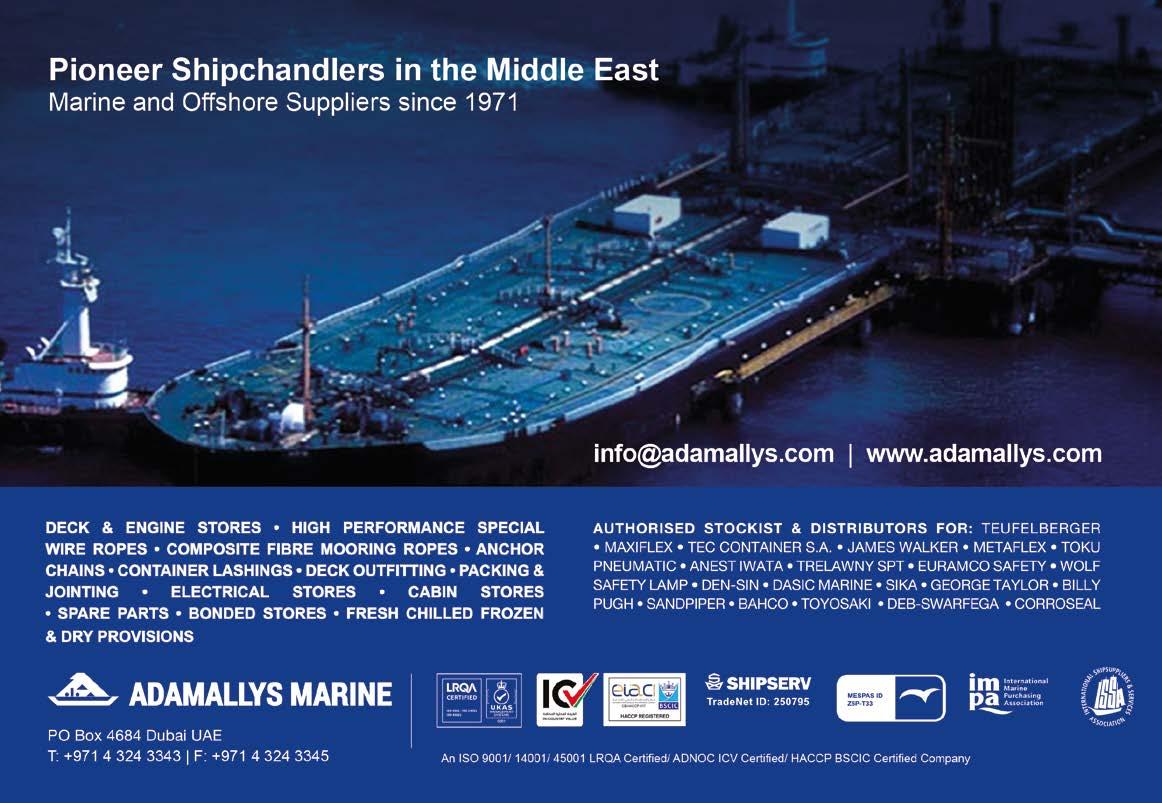
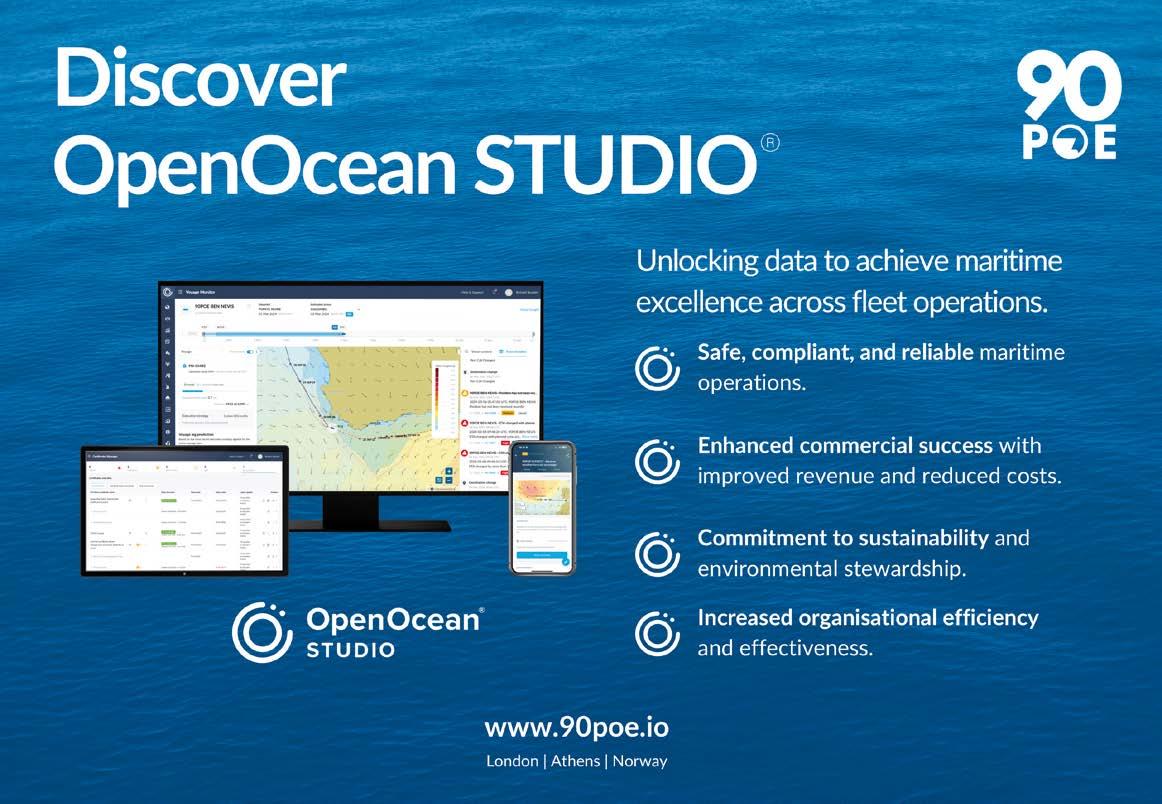
Smart leadership - NAVTOR’s quest for a holistic digital ecosystem


WCompliance, performance, profitability, sustainability…
NAVTOR’s digital ecosystem can work wonders with them all, explains Founder and CEO Tor Svanes
hen Voyager Worldwide, a group with over 200 employees and a history stretching back over two centuries, became a NAVTOR company in December last year it took the maritime world by surprise. It was a deal that made NAVTOR - founded in 2011 with, pre-merger, around 180 employees - the undisputed global leader in e-Navigation, smart shipping, and the maritime technology domain.
Although already renowned as a major player, and arguably the driving force in digital innovation within its niche, the deal catapulted the Norwegian headquartered business into a different league.
“Just a few years ago if you had a company like ours with products and services on 4, 5 or 6,000 vessels it’d be huge,” Tor Svanes, Founder and CEO of NAVTOR notes, “but this takes us to over 18,000. That’s more than 30% of all the ships relevant to our services in the world fleet. The opportunity that scale unlocks, for both ourselves and our customers, is immense, and that was the motivation here.
“So, this doesn’t mark the culmination of our efforts, or the end of our voyage. We see this as just the beginning.”
It’s clear that after well over 40 years in the maritime technology field (he started with Robertson, then owned by Kongsberg, in 1980) Svanes ambitions have anything but diminished. He has helped position NAVTOR firmly facing the future, with a clear vision of “leading the way in smart shipping innovation”. The Voyager deal, he says, is central to that aim.
“We’re delighted with the way NAVTOR has grown, launching industry firsts such as Pay As You Sail ENCs and
NavStation, the first maritime digital chart table, along the way,” Svanes comments. “As we’d built a secure digital ecosystem to unite the e-Navigation portfolio onboard, while connecting vessels to onshore teams, it made perfect sense to take the next step, moving into smart shipping with performance monitoring, management and optimisation, and then digital logbooks.
“By integrating everything onto the NAVTOR platform we found we could really unlock the power of data: automating processes, enhancing safety, improving efficiency and delivering both commercial and environmental benefits to shipping companies worldwide.
“But then, as you progress, barriers emerge… and you need to find ways to address them.”
In NAVTOR’s case those barriers appear to have been the extra ‘muscle’ needed to achieve the team’s ambitions. To really spearhead efforts towards a more efficient, sustainable and profitable industry, the company found itself hungering for an influx of both customers and resources, in particular human resources.
“Talented developers are hard to come by,” Svanes admits, “and, in a niche defined by digital solutions, absolutely essential for progress. With Voyager Worldwide we saw a pool of very talented people, with 30 developers in their Aberdeen office alone, that could accelerate our innovation. That was a major incentive.
“In addition, the customer base obviously adds the volume we were looking for, while the network of offices boosts our global footprint, getting us as close to the customers as we need to be, on the scale needed to deliver first class service. For example, the
92 Ship Management International Issue 108 March/April 2024 Digitalisation
NAVTOR Fleet manager operation room
deal pushed NAVTOR numbers in Singapore from seven to 75 people. In that respect, our business has been transformed.”
Svanes now wants to do the same for the businesses of NAVTOR customers. And integration is the key.
From the cornerstone of e-Navigation NAVTOR has built up a range of products and services that co-exist in its digital ecosystem. Here they share, and feed one another with, a constant flow of data, with each individual solution working to unlock value that is then fed back into the joined-up system.
It creates almost a ‘society’ of mutually supportive solutions, each one working away for the greater good of all. Or for ‘all’ read the shipping company, which can suddenly simplify compliance, reduce energy consumption, slash administration duties, optimise and prove performance, enhance safety, control costs, and so much more. And this is achieved not just for single vessels, but for entire fleets and (now) united on- and offshore teams.
To list the benefits of each individual offering would take too long – from the ease of automated Passage Planning on NavStation, through to the CII simplifying Emissions Calculator on fleet management tool NavFleet – but Svanes points out NAVTOR’s Digital Logbooks as a case study in transformation.
For anyone from outside the industry, he notes, it’d be “a complete shock” to discover the analogue nature of vessel logbooks in a digital age. “These are very important data sources,” Svanes explains, “covering a range of critical issues, but they exist in isolation as out-dated, offline publications, often with scribbled entries from under pressure officers that can be difficult to decipher. “
NAVTOR’s approach is to fire the format into the future with digital logbooks that are connected via the ecosystem, gathering all the data – much of which has been auto populated from the team’s integrated solutions – so shipping
companies have a new, and powerful, big data resource to delve into.
“It simplifies tasks for the crew,” Svanes notes, “while opening immense possibilities for real-time data monitoring, efficiency, and continually enhanced sustainability for shipping companies.” And although he admits there’s no mandated regulations for digital logbooks yet he thinks it may be “only a matter of time.”
NAVTOR has also recently set sail with a three-year project christened GASS (Green AI for Sustainable Shipping), working as lead partner with Grieg Star, Maritime CleanTech, Scandinavian Reach Technologies, Simula Research Laboratory, SinOceanic Shipping, and Sustainable Energy/SIVA, with support from the Norwegian Research Council, Innovation Norway, and SIVA.
In short, this aims to enable “data driven decarbonisation” by creating AI empowered digital twins of vessels based on precise operational and environmental data. These will then be used to demonstrate a benchmark of real-time optimal fuel consumption. If the actual vessel – and that’s any vessel, anywhere, sailing in any conditions – falls short of that standard the data can be instantly analysed to find out why, leading to corrective, on the spot decision making.
“The eventual aim is to create a module that can then be integrated into our portfolio that will allow for dynamic voyage optimisation,” Svanes states. “That means both crews and onshore teams can address issues and deviations from plans as they actually happen. Our models show that can make a major impact on vessel energy consumption.”
How big is major? GASS partners has claimed savings of 15% to 20% under normal operating conditions, which clearly holds out immense advantages for the industry from this Norwegian project where NAVTOR is ‘leading the way’. l

Combined AI and digital twin technology could cut vessel emissions ‘by up to 20%
93 Issue 108 March/April 2024 Ship Management International Digitalisation


Navigation Making waves in autonomy
Is the maritime sector a shining light in unmanned operations or is it lagging behind other transport sectors? Rachael O’Connor of Navtech Radar examines the question.
Since its inception in World War II, radar has been aiding marine operations for an abundance of applications. From navigation and enemy detection in the early years to obstacle detection for ships, swimmers, kayaks, buoys, birds and a host of other obstacles such as bridges, and the vast array of blue economy infrastructure our seas and waterways now house within a specified radius.
Today, plans such as those in Paris to have 3D-printed autonomous craft transport athletes and visitors at the 2024 Olympic Games, and in London to have electric ferry crossings of the Thames, are showing how maritime is continuing to lead in innovation and technology, and having a far-reaching impact.
If the maritime sector is a shining light, as suggested, is it just a case of it being an easier win, given we’ve had more than eight decades to develop it, there’s less traffic on water than on our roads, and less risk than in the air?
Radar continues to be the critical navigation and obstacle detection technology in maritime. Most systems utilise frequencies in the S-band and X-band ranges. S-band, operating at 3 GHz, offers a range of 74 kilometers (40 nautical miles), while the X-band, at around 10 GHz, provides superior target resolution and high-resolution imaging with a wavelength of 3 cm.
Yet, the emergence of W-band radar, operating at 7677 GHz, presents a notable advancement in imagery and

accuracy, and in particular, for applications such as dynamic positioning, situational awareness, collision avoidance and autonomous berthing. The new generation of W-band radar brings even further advances with cm-level resolution for exceptional imagery, a 1000m range for even greater situational awareness and a 4Hz update rate bringing updates to the crew in almost real time and regardless of rain, fog and glare.
It’s for these reasons that W-Band radar is increasingly being deployed near shore, on inland waterways and for navigating offshore infrastructure – such as wind farms –and latterly for the consumer ‘water taxis’ discussed above.
96 Ship Management International Issue 108 March/April 2024
SEA-KIT unmanned craft on trials in the UK [credit SEA-KIT).

High-resolution radar
The question still unanswered here is, is the maritime sector a shining light? For a start, radar is increasingly being used across many industrial automation applications where it can ‘see through’ the obfuscation, such as dusty environments like mining and construction – so there’s a win. Likewise, it’s improving safety on the waterways for both autonomous and manned vessels, particularly around collision avoidance.
To navigate autonomously in busy waterways, relying solely on GNSS and Inertial Measurement Unit (IMU) isn’t sufficient. These technologies lack the precision needed for such environments, especially when GPS signals weaken and IMU drift compromises accuracy. Integrating a perception-based system is vital for dependable positioning.
Traditional sensors like cameras and lidar fall short of meeting the stringent centimetre-level positioning demands, particularly in adverse weather. W-band radar offers high resolution, extended range, and resilience to weather conditions. Leveraging high-frequency radar is crucial for enabling autonomous navigation in intricate and crowded water channels.
The solution to the centimetre-level positioning challenge in congested waterways may lie in high-frequency radar. Emerging technologies, particularly W-band radar, hold the potential to combine the best of both worlds–offering the resolution of Lidar, while retaining the range and robustness of radar.
High-frequency radar systems, operating in the millimetre-wave spectrum, can deliver remarkable precision, detecting even the smallest of objects with exceptional clarity. This makes these 360° radar sensors ideal for large scale perception-based positioning, due to their inherent ability to provide multiple highly accurate
detections over a large range and field of view. These detections are stable over all weather conditions and are not influenced by lighting conditions meaning maps maintain integrity over a longer period as the environment changes. The resulting detailed detections from small navigations buoys, jetty pylons and harbour wall details, enables features to be clear as to describe the location.
Achieving precise positioning is not just about ensuring operational safety but is also concerned with streamlining navigation in congested areas, optimising traffic movement, and reducing the potential for collisions. This must be addressed to unlock the full potential of autonomous marine operations.
As our inland waterways become busier, the need for autonomy increases. Passenger, and car ferries require the whole suite of sensors, not least to navigate very busy waterways along rivers like the Thames. W-band radar is also fuelling innovation within vessels such as hydrofoils, which are stable, but fast, so need robust collision avoidance technology in place, inland survey vessels and tug vessels.
Out in the open sea, offshore support vessels are relying upon W-band radar for dynamic positioning to keep a steady berth alongside infrastructure such as wind farms and oil rigs.
The maritime sector is undeniably making waves in autonomy. Its capacity for real-time obstacle detection, collision avoidance, and positioning is critical in enhancing situational awareness and overall safety. Indeed, much of this is now deployed across many other modes of transport, particularly in mining, construction, and farming in addition to the emergence of self-driving cars on our roads and unmanned aerial vehicles, or drones, in our skies.
In short, the maritime sector has had a head start, but it’s still a shining light. l
97 Issue 108 March/April 2024 Ship Management International Navigation
Objects of Desire
» Booze cruise
Commercial breweries have been using hop oils to infuse beers with hops for centuries, a process achieved by “dry hopping”, which can take up to a week. Homebrewers opens another realm of possibilities DIY-distilling, using own essential oils made from hops. Try a new past time with PicoStill, with your very own, quality designed machine for crafting and brewing! Distil your own batches of spirits safely and more precisely, or capture the essence of hops and other oils for a wide range of uses in other food and beverages.
PicoStill
€259.00 picobrew.com

» Futuristic fitness
Ergonomics has resulted in the creation of the ideal exercise machine. High-performance training is completely possible thanks to this impeccably designed adjustable magnetic resistance system. The flywheel spins at a high speed due to a system that multiples the pedal turns, enhancing the magnetic field’s strength. An electronic system regulates resistance. The flexible base follows the body’s movements. The frame flexes sideways when under pressure, just as when cycling on a street. This amazingly smart exercise bike is Bluetooth enabled and can connect with any mobile device through an App.
Ciclotte Fitness
£15,995.95 theultimatelivingcompany.com

» Hydrogen first
Experience the freedom of direct, point-to-point flights and the versatility of vertical take-off and landing, allowing you to land at your chosen locations, literally. Featuring pressurised cabin and ducted fan design solutions, the Sirius Jet is engineered to reach high altitudes of 30,000 feet and achieve a cruise speed of 520 km/h or 323 mph producing <60 dB noise level. Sirius Jet is equipped with an airframe parachute system, effectively reducing the incident risk to virtually Zero.
Sirius Jet Hydrogen
$1,500,000.00 siriusjet.com

98 Ship Management International Issue 108 March/April 2024
» Sophisticated elegance

Strategy, contemplation, intelligence, all key elements for enjoying Teckell’s board games but, above all, you need time which is a rare gift in this hectic era. One board, three layers of marvel including a base in black Marquina marble and a thin metal game board, secured by a low iron tempered glass top. Interchangeable game surfaces in thin metal allowing you to play multiple games. Just choose a game and place it onto the board’s base through the simple magnetic opening. Other games available are Chess and Checkers, Backgammon, Ludo, Chinese chess (Xiangqi).
TECKELL® STRATEGO BLACK
£10,000 teckell.store
» Headphone finesse
DAVÌ is a passport, an invitation and an exclusive admittance to heightened sensation. An opportunity to indulge all your senses. And ultimately, to step into an experience desired by many, but attainable only by a fortunate few. Rated as the best headphones on the planet, worn by celebrities and popstars alike, namely Jay-Z. Indulge in these for something amazing and different.
Davi headphones
Up to £50,599.00 daviaudio.com


» Deck chic
Built like the best classics in nautical footwear, these long-lasting two eye boat shoes are made of hot stuffed leather. Conditioned with a rich combination of oils and waxes, then hand-sewn with the finest craftsmanship: waterproof and enhanced by a natural polish quality, they feature a canoe moc construction, leather sock lining, 360° rawhide lace system and non-marking anti-slip soles in an innovative dark-brown rubber to offer stable grip in all weather conditions. The ‘Schooner’ mocs or deck shoes are the ideal footwear to face and ride the coastal winds just like the Schooner ships!
Schooner waxed leather boat shoe
£160.00 sebago.co.uk
Objects of Desire
99 Issue 108 March/April 2024 Ship Management International
Review
Wind, Tide & Oar
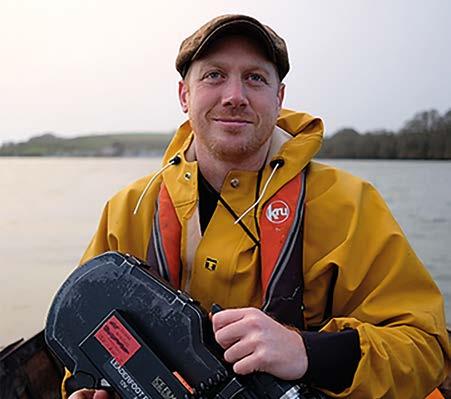
A captivating film exploring the art of ‘engineless sailing,’ which premiered at Royal Museums Greenwich before embarking on a three-month sailing tour on a Thames sailing barge crewed by youngsters. Wind, Tide & Oar is a compelling exploration of engineless sailing and the lives of those who navigate the seas without relying on auxiliary power. Shot on 16mm analogue film over three years, it follows an array of traditional boats, delving into the rhythms of sailing engineless, taking viewers on a mesmerising journey across rivers, coasts, and open seas, spanning the UK, the Netherlands, and France. Addressing themes such as ecology, mental health, heritage, traditional skills, and maritime history, it’s filmed using a 1960s hand-wound camera, where director Huw Wahl offers a poetic and intimate perspective on the ancient craft of harnessing the wind for travel, inviting deep reflection on our relationship with the natural world, where sailing becomes a place to explore our interaction with and responsibility to the environment, and the world around us.
THE SEA TOUR | 26.04.2024 - 20.07.2024 Wind, Tide & Oar embarks on a unique journey along the Southeast coast aboard the Thames sailing barge Blue Mermaid. Crewed by Skippers of the Future, young trainees, the tour offers free film screenings, Q&A sessions, and school workshops showcasing traditional maritime trades in ten ports.
THE BOOK LAUNCH The New Menard Press has released an accompanying book, delving deep into the conversation between sailor, boat, and elements, exploring the essence of engineless sailing.
Zero Point 4
By Rear Admiral James Watson USCG
At the end of World War II, the US flag flew on 50% of the world’s ocean going fleet. Today that number is 0.4% leaving the US, and the part of the world that believes in freedom of navigation and trade, vulnerable. Zero Point Four is a call to action for the United States to overcome its “sea blindness” and take action to mitigate its vulnerabilities in national, economic, energy, climate and workforce security. But not only does it highlight the risks, but it offers a 57-point Action Plan to address the myriad of challenges and consequences of doing little or nothing. Available for purchase on Amazon.

Film, Sea
Book windtideandoar.com/sea-tour
Tour and
100 Ship Management International Issue 108 March/April 2024
Harbour Life
Antwerp-Bruges
By Patrick Verhoeven
Pandora Publishers NV
(info@pandorapublishers.eu)
We all take a lot of things for granted in life, whether it’s knowing we will arrive safely from our plane trip or that the meal we ordered in the high end restaurant will be of the quality that we expect. And the same goes for who actually runs our ports. Who are the people who go about their daily tasks making our ports work? Harbour Life, Patrick Verhoeven’s fascinating insight into the port community of Antwerp-Bruges, shines a spotlight on the lives of the ordinary people who really matter. And their jobs are more diverse than you might think. The author discovered a love of ports from the early age of 16 and it shows in how he describes how the port might be populated with dockers, freight forwarders, terminal operators and harbour masters, but it is also peppered with other important people such as bar owners, priests, nature conservationists and heritage guards. Harbour Life introduces you to their fascinating world with aplomb. It pictures the Antwerp-Bruges port community as a diverse yet warm and accessible family; full of people who are passionate about what they do.

L’Atelier, by Joël Robuchon
Bund 18 3/F, 18 Zhongshan East Road (E1), Shanghai, China 200002
smartshanghai.com/venue

One Ocean Expedition
April 2025-2026
oneoceanexpedition.com

The One Ocean Expedition is a voyage around the world by the Norwegian tall ship Statsraad Lehmkuhl, set to educate new generations of seafarers and marine scientists alike. The 98-metre-long ship is a floating university and training vessel, bringing students, scientists, trainees and professionals and is recognized by the UN Decade of Ocean Science for Sustainable Development. Visiting 20 different ports in Europe, the USA, Central, and South America, its goal is to create awareness and share knowledge about the essential role of the ocean in global sustainable development and sets sail from Bergen next April. What’s more, his Royal Highness Crown Prince Haakon of Norway is an ambassador for this major expedition.
L’Atelier is the name of twelve gourmet restaurants, located worldwide, created by chef Joël Robuchon and now managed by JR International. The restaurants serve French haute cuisine in a stylized environment, with many of the seats arranged to overlook the meal preparation in the kitchen. L’Atelier translates to ‘workshop’, and the term is commonly used to refer to the workshop of an artist in the fine or decorative arts. In 2012, the Paris location of L’Atelier de Joël Robuchon in Saint-Germain-desPrés was voted 12th best in the world in Restaurant magazine’s Top 50. Notable chefs who have worked at the ateliers include Lebanese writer Tara Khattar. The Shanghai establishment is no exception and one of the city’s finest, so check it out.
books, theatre, dining, events, culture, films, festival, music, art, dvd, wine
101 Issue 108 March/April 2024 Ship Management International
Lifestyle Putting unabashed style into
electric motoring
By Rob Auchterlonie

In the ever expanding world of electric cars there are some that stand a few spaces and more away from the rest in the car park.
They’re the ones that have a tad more style about them, the ones that ooze quality to match their price tags –so that rules out the bland Tesla, however efficient it is.
We’re talking here about Audi’s e-tron GT, a four-door high performance EV that has the sleek looks to match its phenomenal performance.
A car with space for five in a superbly trimmed cabin that’s packed with the latest tech. One that can be quickly
charged up. One that ticks the necessary boxes for the well-heeled on the move.
It’s a similar concept to its stablemate Porsche Taycan but the accent is on a softer, more passenger friendly ride, thought the Porsche in its various guises has plenty of settings on offer itself.
The e-tron GT is built at Audi’s factory at Neckarsulm and features a motor on both front and rear axles (quattro) giving you a thumping 470bhp. Floor the right hand pedal and the effect is intoxicating, shoving you firmly into the depths of the sculptured seats, giving your kidneys a quick shoogle and
Ship Management International Issue 108 March/April 2024
covering the tarmac under its big wide wheels at an astonishing rate – it’ll pass the 62mph mark in just 4.5 seconds, and if you’re on an unrestricted autobahn and not the M25, you could see 152mph appear on the screen in front of you.
You sit low in the cabin, so probably not one for those with dodgy backs from too many rounds of golf, but what it gives you is a great view that accentuates the curves arches that cover the rear wheels – and a view of the road rapidly disappearing behind you.
Maximum quoted range is 298 miles on a full charge, and the Audi’s rapid charging capacity means you
Road Test: Audi e-tron GT quattro
Price: £85,185 (£96,675 as tested)
Engine: 94kWh battery
Power: 470bhp
Transmission: two speed automatic
Top speed: 152mph (electronically limited)
0-62mph: 4.5 seconds
Range: 296 miles
CO2 emissions: 0g/km

can theoretically put a 60-mile top-up into the 95kWh battery in just five minutes – but only if you have access to 270kW charging, which is currently not that easy to track down.
There are four selectable drive modes, with comfort probably the best suited for UK roads. It all feels very Audi-esque, with body roll almost non-existent, meaning you rarely have to contemplate switching to the sportier Dynamic mode.
The interior design is a bit more restrained than the exterior, although Audi makes good use of
Lifestyle
103
Lifestyle
environmentally-sourced trim materials such as a vegan ‘leather’ and recycled wood finishes. And as you’d expect of a top-level Audi, you can’t fault the fit and finish.
It’s a big heavy car at 2.2 tonnes but with the battery weight low down in the floor it’s very well balanced and there’s no tendency to roll. There’s no deviation when cornering and the pin sharp steering always keeps you up to date with what the front wheels are up to.
The e-tron cabin is very roomy in spite of its low-slung appearance, and can seat five passengers in comfort.
You might expect to find headroom restricted, especially in the back, but the battery pack has been designed with a footwell recess built into it which adds to the available space for rear passengers’ feet under the front seats.
If it’s good enough for Stella McCartney’s cultured eye, surely it’s worth you taking a look yourself? l




104 Ship Management International Issue 108 March/April 2024
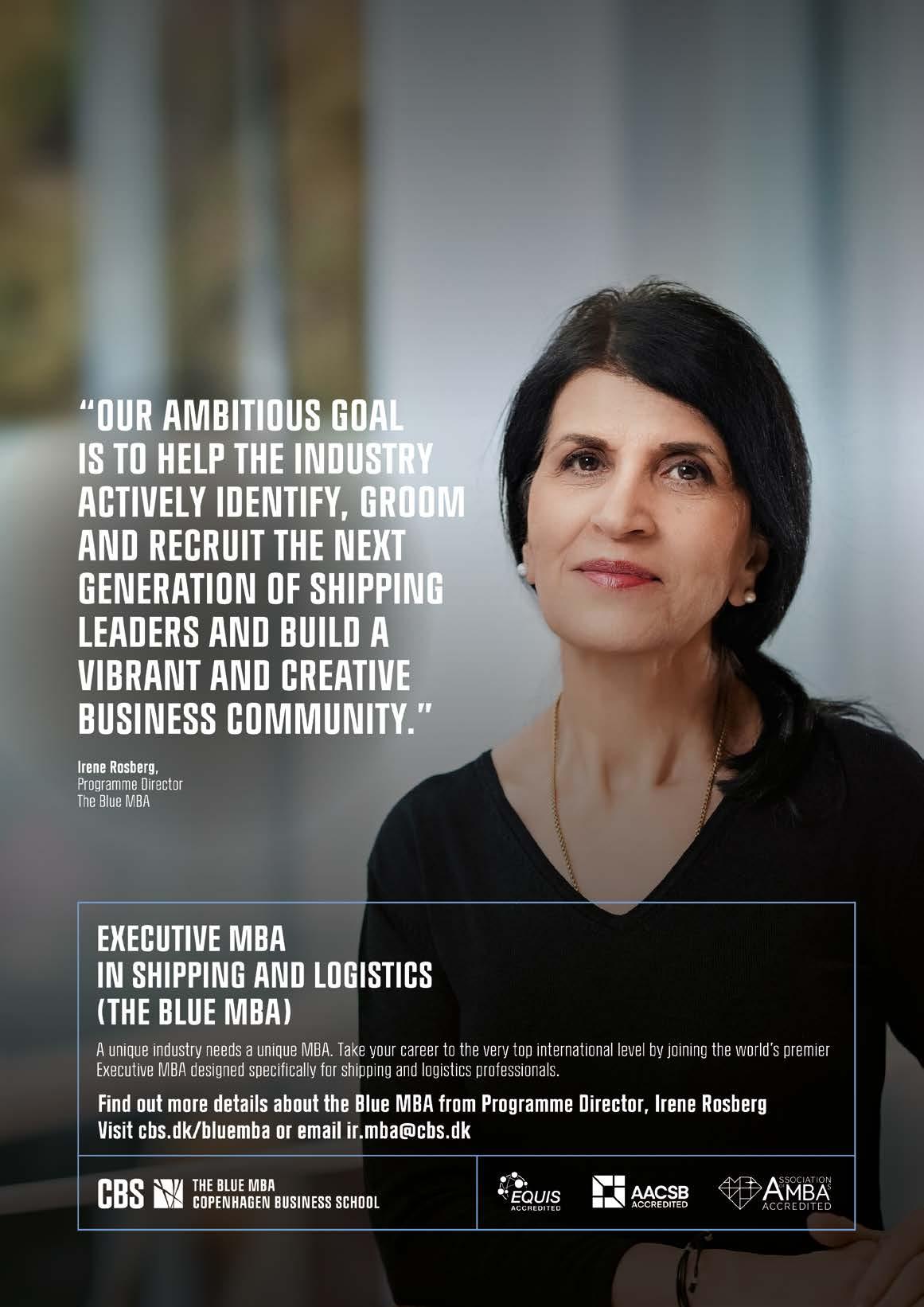








































































































 IBy Paillette Palaiologou, Vice President, Marine & Offshore Division SEEBA Zone, Bureau Veritas Group
IBy Paillette Palaiologou, Vice President, Marine & Offshore Division SEEBA Zone, Bureau Veritas Group

 By Theophanis Theophanous, Managing Director of BSM Greece
By Theophanis Theophanous, Managing Director of BSM Greece







































 By Nakul Malhotra, Vice President, Emerging Opportunities, Wilhelmsen
By Nakul Malhotra, Vice President, Emerging Opportunities, Wilhelmsen



























